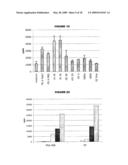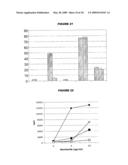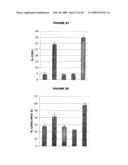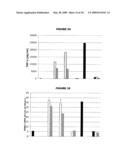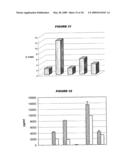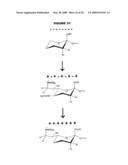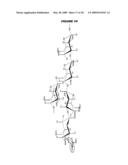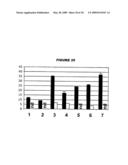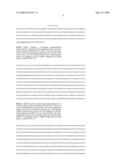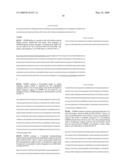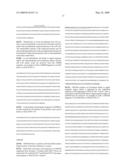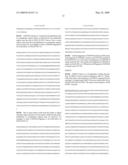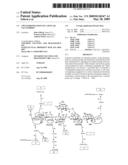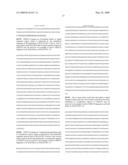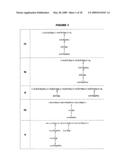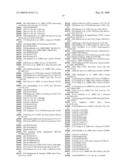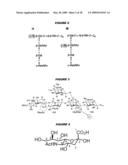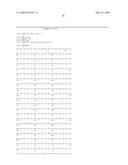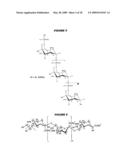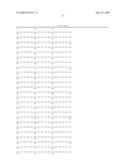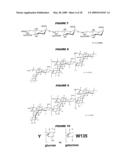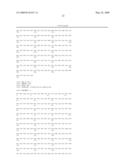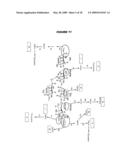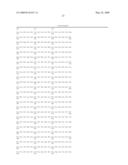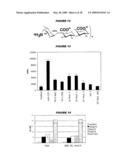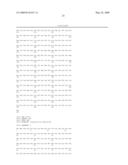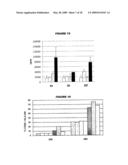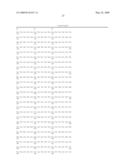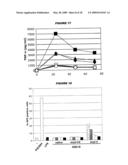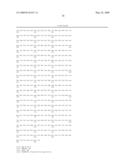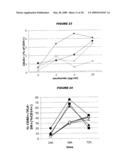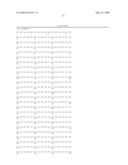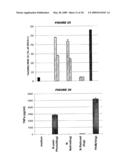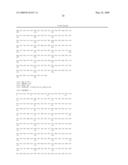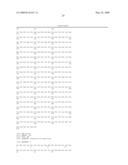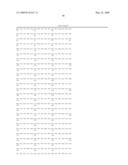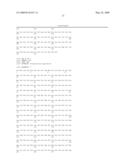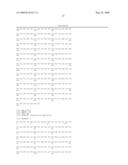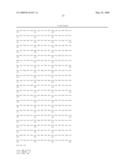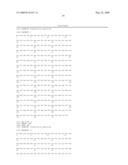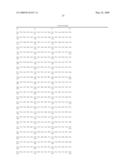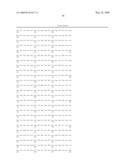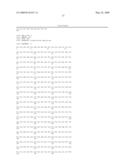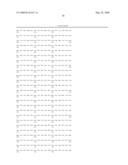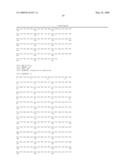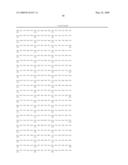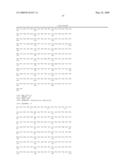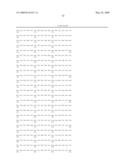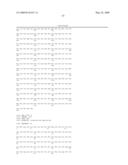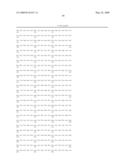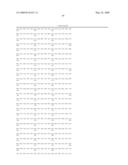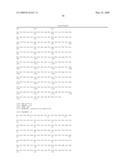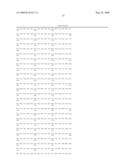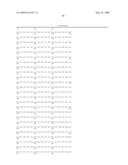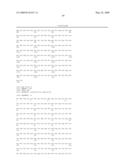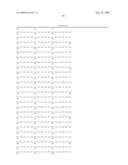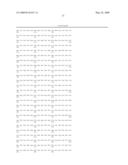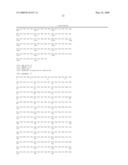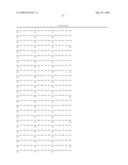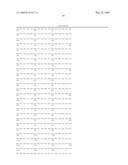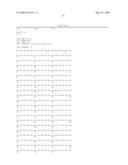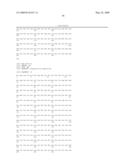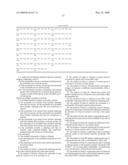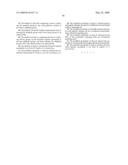Patent application title: ZWITTERIONIZATION OF CAPSULAR SACCHARIDES
Inventors:
John Telford (Siena, IT)
John Telford (Siena, IT)
Francesco Berti (Siena, IT)
Francesco Berti (Siena, IT)
Andreas Wack (Siena, IT)
Assignees:
NOVARTIS VACCINES AND DIAGNOSTICS SRL
IPC8 Class: AA61K3909FI
USPC Class:
4242441
Class name: Antigen, epitope, or other immunospecific immunoeffector (e.g., immunospecific vaccine, immunospecific stimulator of cell-mediated immunity, immunospecific tolerogen, immunospecific immunosuppressor, etc.) bacterium or component thereof or substance produced by said bacterium (e.g., legionella, borrelia, anaplasma, shigella, etc.) streptococcus (e.g., group b streptococcus, pneumococcus or streptococcus pneumoniae, etc.)
Publication date: 2009-05-28
Patent application number: 20090136547
Claims:
1. A method for modifying a bacterial capsular saccharide antigen,
comprising a step of:(i) if the saccharide is anionic, converting a
neutral group in the saccharide into a cationic group;(ii) if the
saccharide is cationic, converting a neutral group in the saccharide into
an anionic group;(iii) if the saccharide is neutral, converting a first
neutral group in the saccharide into an anionic group and converting a
second neutral group in the saccharide into a cationic group,thereby
providing a modified saccharide.
2. A modified bacterial capsular saccharide, wherein:(i) the saccharide in its natural form includes repeating units that are cationic, but the saccharide in its modified form includes repeating units that are zwitterionic or anionic;(ii) the saccharide in its natural form includes repeating units that are anionic, but the saccharide in its modified form includes repeating units that are zwitterionic or cationic;(iii) the saccharide in its natural form includes repeating units that include either cationic or anionic groups, but the saccharide in its modified form includes repeating units that include both cationic and anionic groups; or(iv) the saccharide includes a repeating unit that (1) includes both positively-charged and negatively-charged groups but (2) has no overall charge.
3-4. (canceled)
5. The modified saccharide of claim 2, wherein:(i) the repeating units in the modified saccharide are zwitterionic; or(ii) the repeating unit has both a free carboxyl group and a free amino group.
6. (canceled)
7. The method of claim 1, wherein the repeating unit has both a free carboxyl group and a free amino group.
8. The method of claim 1, wherein the saccharide is from group B. streptococcus or B. meningococcus.
9. The method of claim 1, wherein a neutral group is converted to a group with a lower pKb value.
10. The method of claim 1, wherein a N-acetyl group is converted to an amino or amine group.
11. The method of claim 1, wherein positive and negative charges are present on different monosaccharide within a repeating unit.
12. The method of claim 11, wherein the positive and negative charges are not on adjacent monosaccharides within the repeating unit.
13. The method of claim 1, wherein at least 50% of the saccharide's repeating units are zwitterionic repeating units.
14. The method of claim 1, wherein the saccharide is a substantially full-length capsular polysaccharide.
15. The method of claim 1, comprising a step of: deacetylating a N-acetyl group on the bacterial capsular saccharide in the presence of a base or enzyme to provide a free amino group.
16. The method of claim 15, further comprising the step of: reacting the free amino group with an aldehyde to provide an amine group.
17. The method of claim 16, wherein the aldehyde is formaldehyde and the amine is a secondary amine.
18. The method of claim 15, wherein the N-acetyl group is present on a NeuAc moiety and/or a GlcNac moiety.
19. The method of claim 1, comprising a step of: reacting a carboxyl group on the bacterial capsular saccharide with pyruvate.
20. The method of claim 19, further comprising the step of: reacting the pyruvate with a carbodiimide or acetic acid.
21. The method of claim 1, comprising the step of: reacting a carboxyl group on the bacterial capsular saccharide with TEMPO (2,2,6,6-tetramethyl-1-piperidine oxoammonium ion) in the presence of hypochlorite and bromide.
22. The method of claim 1, comprising a step of: hydrolysis of a terminal galactose unit on the bacterial capsular saccharide with O3/NO or [beta]-endogalactosidase.
23. The method of claim 22, comprising a step of: oxidizing the terminal galactose unit with galactose oxidase to provide an aldehyde group.
24. The method of claim 23, further comprising the step of: reacting the aldehyde group with a free amino group or an amine group.
25. The method of claim 1, comprising the step of: oxidizing NeuAc groups on the bacterial capsular saccharide to provide aldehyde groups and then reacting the aldehyde groups with a free amino group or an amine group.
26. The method of claim 1, wherein the bacterial capsular saccharide is not from B. fragilis or S. pneumoniae.
27. The modified saccharide of claim 2, wherein the saccharide is from group B. streptococcus or B. meningococcus.
28. The modified saccharide of claim 2, wherein positive and negative charges are present on different monosaccharide within a repeating unit.
29. The modified saccharide of claim 28, wherein the positive and negative charges are not on adjacent monosaccharides within the repeating unit.
30. The modified saccharide of claim 2, wherein at least 50% of the saccharide's repeating units are zwitterionic repeating units.
31. The modified saccharide of claim 2, wherein the saccharide is a substantially full-length capsular polysaccharide.
32. The modified saccharide of claim 2, wherein the bacterial capsular saccharide is not from B. fragilis or S. pneumoniae.
Description:
[0001]All documents cited herein are incorporated by reference in their
entirety.
TECHNICAL FIELD
[0002]This invention is in the field of vaccines based on saccharide antigens.
BACKGROUND ART
[0003]Bacterial capsular saccharides are generally T-independent antigens, but they can be converted to T-dependent antigens by conjugating them to carrier proteins. It is an object of the invention to provide alternatives to conjugation for making saccharides into T-dependent antigens, and more generally to provide ways of modifying saccharides so that they can activate T cells.
DISCLOSURE OF THE INVENTION
[0004]Capsular saccharides are typically anionic, as a result of an otherwise neutral sugar backbone carrying anionic groups such as carboxyls (which are present as carboxylate ions at physiological pH). In the invention, however, a T-independent bacterial capsular saccharide antigen is converted into a saccharide that can activate T cells (e.g. a T-dependent saccharide antigen) by modifying it to include both anionic and cationic groups. In preferred embodiments, the anionic and cationic groups are balanced with the saccharide's repeating unit, to give a zwitterion. Zwitterionic capsular saccharide antigens from Bacteroides fragilis have been found to stimulate T cells by MHC class II-dependent interactions [1], and similar stimulation has been seen for Staphylococcus aureus and type 1 Streptococcus pneumoniae. Without wishing to be bound by theory, the invention aims to mimic this MHC-II stimulatory effect for saccharides that are naturally T-independent, thereby rendering them immunogenic without requiring conjugation to a carrier.
[0005]Thus the invention provides a method for modifying an anionic bacterial capsular saccharide antigen, comprising a step of converting a neutral group in the saccharide into a cationic group.
[0006]The invention also provides a method for modifying a cationic bacterial capsular saccharide antigen, comprising a step of converting a neutral group in the saccharide into an anionic group.
[0007]The invention also provides a method for modifying a neutral bacterial capsular saccharide antigen, comprising steps of (i) converting a first neutral group in the saccharide into an anionic group and (ii) converting a second neutral group in the saccharide into a cationic group.
[0008]For convenience, these various methods are referred to as `zwitterionization`, even though the final modified repeating unit may not formally be a zwitterion. For example, the type 1 S. pneumoniae saccharide (FIG. 12) is generally referred to as being a zwitterion even though it has an overall negative charge. The key point is that the modified saccharide has a repeating unit which includes both cationic and anionic groups, which may or may not be balanced to give a zwitterion. Preferably, however, the charges are balanced such that the repeating unit is a zwitterion.
[0009]The invention also provides a modified bacterial capsular saccharide, wherein the saccharide in its natural form includes repeating units that are cationic, but the saccharide in its modified form includes repeating units that are zwitterionic or anionic. The repeating units in the modified saccharide are preferably zwitterionic.
[0010]The invention also provides a modified bacterial capsular saccharide, wherein the saccharide in its natural form includes repeating units that are anionic, but the saccharide in its modified form includes repeating units that are zwitterionic or cationic. The repeating units in the modified saccharide are preferably zwitterionic.
[0011]The invention also provides a modified bacterial capsular saccharide, wherein the saccharide in its natural form includes repeating units that include either cationic or anionic groups (but not both), but the saccharide in its modified form includes repeating units that include both cationic and anionic groups. The repeating units in the modified saccharide are preferably zwitterionic.
[0012]The invention also provides a modified bacterial capsular saccharide, wherein the saccharide includes a repeating unit that (i) includes both positively-charged and negatively-charged groups but (ii) has no overall charge.
[0013]Preferred repeating units have both free carboxyl groups and free amino groups, thereby providing both positively-charged and negatively-charged groups, preferably in an overall neutral zwitterionic repeating unit.
[0014]The invention is particularly suitable for use with capsular saccharides from (a) group B streptococcus (`GBS`, or Streptococcus agalactiae), including serotypes Ia, Ib, II, III and V, and (b) meningococcus (Neisseria meningitidis), including each of meningococcal serogroups A, B, C, W135 and Y. These saccharides are naturally polyanionic (i.e. they have multiple anionic repeating units, typically carboxyls) but can be chemically modified by introducing positively-charged groups, preferably into a zwitterionic form. For instance, neutral N-acetyl groups can be converted to amino groups able to carry positive charge as --NH3.sup.+.
Zwitterionization
[0015]A zwitterion is a molecule that has both positively-charged and negatively-charged groups but has no overall charge i.e. the + and - charges are balanced within the molecule. To convert an anionic molecule into a neutral molecule then anions would typically be replaced by neutral groups, but to convert an anionic molecule into a zwitterion then a neutral group is replaced by a cationic group. According to the invention, the term `zwitterionization` includes situations where a saccharide with a repeating unit that includes only anionic or cationic groups (but not both), or that includes no charged groups, is modified to have a repeating unit that includes both cationic and anionic groups. The modified repeating unit may have neutral overall charge (i.e. may be a zwitterion), but the invention also extends to situations where the charges are present but are not balanced. The modified repeating unit may be amphoteric (i.e. can react with an acid or a base).
[0016]Once a naturally-charged capsular saccharide has been selected for zwitterionization, an initial step in the process involves the identification of a charged repeating unit. The charge in an anionic repeating unit will typically result from the presence of free carboxyl groups [--COO.sup.-]. A neutral group in the repeating unit is identified, and in particular a neutral group that can be converted to a group having the opposite charge to the unmodified repeating unit i.e. for an anionic repeating unit, a neutral group that can be converted to a cation is identified. The positive charge in the modified repeating unit will typically result from the presence of protonated free amino groups [--NH3.sup.+], which can conveniently be prepared from free N-acetyl groups [--NH--(C═O)--CH3]. To introduce an anionic group, a carboxyl can be introduced, for instance by conversion of --CH2OH to --COO.sup.- (optionally via an aldehyde group).
[0017]The ability to convert a neutral group into an ionic group is thus a key aspect of zwitterionization. For anionic saccharides, which is the most common type of bacterial capsular saccharide, the ability to change a neutral group to a cationic group is important. Typical cations for use with the invention are protonated forms of primary amines (amino groups --NH2, which can be protonated to give cationic --NH3.sup.+), secondary amines (--NRH→--NRH2.sup.+) and tertiary amines (--NR1R2→--NR1R2H.sup.+). Cationic quaternary amines (--NR1R2R3+) can also be used, such as --N(CH3)3.sup.+. These groups can conveniently be prepared from free N-acetyl groups, which are frequently found in capsular saccharides as part of sialic acid (N-acetylneuraminic acids, `NeuNAc`; FIG. 4) and N-acetylglucosamine (`GlcNAc`) residues. The nitrogen atom in a N-acetyl group does not readily accept a proton at physiological pH and so, for zwitterionization, N-acetyl groups can be replaced with N-linked groups with a lower pKb value, such as the amino and amine groups discussed above. Amino groups can also be introduced in place of existing uncharged hydroxyl groups (e.g. to make an amino sugar), which can be used instead of de-N-acetylation if the N-acetyl group is important for immunoreactivity.
[0018]For introduction of a cationic group, therefore, a neutral group should be converted to a group with a lower pKb value (i.e. to a stronger base). Conversely, where an anionic group is to be introduced then a neutral group should be converted to a group with a lower pKa (i.e. higher pKb) value.
[0019]As mentioned above, cationic groups that can easily be generated from existing neutral groups include primary amine, secondary amine, tertiary amine and amino groups.
[0020]Anionic groups that can easily be introduced during zwitterionization include phosphates, phosphonates, sulfates, nitrates and carboxyls.
[0021]The most preferred cationic group to introduce during zwitterionization is a free (i.e. unsubstituted) amino group. The free amino group may then be substituted as discussed above. The most preferred anionic group to introduce during zwitterionization is a free carboxyl group.
[0022]Examples of chemical treatments to remove or introduce charged groups in bacterial capsular saccharides are outlined in FIG. 11. These schemes are shown for GBS-III, but are equally applicable to other GBS serotypes, including Ia and Ib.
[0023]In general, de-N-acetylation can be achieved by basic hydrolysis to reveal free amino groups. As shown in scheme I in FIG. 11, a N-acetyl group (either in an internal residue or a terminal residue) can be converted first (step Ia) to an amine by de-N-acetylation (e.g. via NaOH treatment) and the amine can then be converted to a cationic --NH3.sup.+ group. If desired, scheme II can then be used to convert the amino group to a tertiary amine (for example, to tertiary dimethylamine --NH(CH3)2.sup.+) e.g. by formaldehyde treatment under suitable conditions (such as 37% formaldehyde) in step Ha. These higher amines are more stable e.g. resistant to the effects of pH changes.
[0024]Scheme III in FIG. 11 illustrates removal of an anionic carboxyl. A carboxyl group can be associated with pyruvate (--COCOOCH3) and reduced by carbodiimide-mediated reduction. The pyruvate ring can also be removed by treatment with acetic acid (e.g. 5%). Further modifications of an introduced pyruvate residue are possible. For example, step IIIb reduces the carboxyl to an aldehyde e.g. using NaBH4. The carboxyl can also be reduced to an aldehyde by using SOCl2 or a phosphorus chloride reagent such as phosphorus trichloride or phosphorus pentachloride to form an acid chloride. The acid chloride can then be reduced to an aldehyde by using a suitable reducing agent, which is preferably a hydride donor, e.g. LiAlH4 or sodium borohydride. The aldehyde can then be reduced to an alcohol in step IIIc e.g. using sodium borohydride. The removal of an anionic carboxyl can also be achieved by treatment of the anionic carboxyl group with a reagent such as EDC (1-ethyl-3-(3-dimethylaminopropyl)carbodiimide) and sodium borohydride. Alternatively, the anionic carboxyl can be reduced to an alcohol in a single step by using LiAlH4 or BH3 for example. Scheme III can be used after basic de-N-acetylation. As the effect of modification III is to remove an anionic group, this procedure will typically be used in conjunction with other modifications. The modification can be used in a procedure to move a negative charge to another site in a repeating unit e.g. to give a desired spacing of negative and positive charges.
[0025]As shown in scheme IV in FIG. 11, glycosidic linkages in saccharides can be cleaved by various treatments, including enzymatic (e.g. with β-endogalactosidase) or chemical (e.g. ozonolysis, nitric oxide treatment, acid hydrolysis, base hydrolysis, etc.) treatments. These depolymerization treatments can leave terminal groups that can be used during zwitterionization. For example, FIG. 11 shows an initial fragmentation in step IVa using ozonolysis, nitric oxide or β-gal treatment. Step IVb oxidises the end of the fragmented saccharide to generate a terminal aldehyde e.g. using galactose oxidase. Step IVc then converts the aldehyde to a cationic --NH3.sup.+ group by reductive amination e.g. using ammonium and sodium cyanoborohydride. Reductive amination may involve either ammonia or a primary amine (NHR). This can conveniently be achieved by using an ammonium salt (e.g. ammonium chloride) in combination with an appropriate reducing agent (e.g. cyanoborohydrides, such as sodium cyanoborohydride NaBH3CN; borane-pyridine; sodium triacetoxyborohydride; borohydride exchange resin; etc.). After its introduction, an amino can be further converted to a secondary or tertiary amine as described above for schemes I & II (e.g. to tertiary dimethylamine --NH(CH3)2.sup.+). Scheme IV may be used particularly after a saccharide has been subjected to total (re-)N-acetylation of its residues.
[0026]Scheme V in FIG. 11 begins by removing the aliphatic chain (--CHOH--CH2OH) from a terminal NeuNAc residue (e.g. by mild oxidation, as achieved using sodium periodate at low temperature) to leave --CHO (i.e. the C9 carbon is lost). This aldehyde group can then be converted to a cationic group (e.g. --NH3.sup.+, or higher amine) as described for scheme IV. Scheme V may be used particularly in situations where it is desired to maintain N-acetyl groups e.g. after a saccharide has been subjected to total (re-)N-acetylation of its residues.
[0027]Scheme VI in FIG. 11 converts a hydroxyl (--CH2OH) to a carboxyl (--COO.sup.-), thereby replacing a neutral group with an anionic group. The conversion can be achieved using a strong oxidising agent, such as H2O2, KMnO4 or H2CrO4, in step Via. Conversion from hydroxyl to carboxyl can also be achieved (scheme VII) via an aldehyde intermediate e.g. an initial Va with further oxidation in step Vila. Selective conversion of a primary hydroxyl (--CH2OH) to a carboxyl (--COO.sup.-) can be achieved by use of TEMPO (2,2,6,6-tetramethyl-1-piperidine oxoammonium ion) in the presence of hypochlorite and bromide.
[0028]In general, aldehydes can readily be prepared by oxidizing vicinal hydroxyls groups (diols). The aldehyde can then be converted to carboxyl by further oxidation step e.g. with H2O2. With reference to FIG. 11, the susceptible diols are, in order of reactivity (see also FIG. 34): [0029]1) C8-C9 of the NeuAc residue [0030]2) C7-C8 of the NeuAc residue; [0031]3) C2-C3 of the Glucose residue.
[0032]These diols can be converted into aldehydes using reagents such as TEMPO and NaIO4. The non-diol hydroxyls (e.g. the hydroxyl groups on C-6 of glucose moieties and on C-6 of galactose moieties) are typically not reactive with TEMPO or NaIO4 but can be oxidized instead with, for example, KMnO4, H2O2 or H2CrO4. Selective reaction of diolic hydroxyls and non-diolic hydroxyls can be achieved based on stoichiometry and/or the use of protection and de-protection of primary and secondary hydroxyl groups as necessary.
[0033]Further suitable chemical treatments are also disclosed in reference 2, including (a) modification of --NH3.sup.+ groups to --NHAc or to --NH(CH3)2.sup.+, and (b) reduction of anionic --COO.sup.- to --CH2OH.
[0034]The balanced negative and positive charges in a zwitterionic repeating unit of the invention preferably arise from carboxyl and amino groups.
[0035]Neutral groups selected for modification during zwitterionisation are preferably not critical to the antigenic activity of the native saccharide. Thus, for instance, the modification should not remove the ability of a saccharide to induce a neutralizing antibody.
[0036]If the spacing of positive and negative groups in a zwitterionised repeating unit is important for a molecule's ability to act as a T-dependent antigen, it may be preferred that positive and negative charges should be on different monosaccharides within a repeating unit. However, it is also possible to have the charges on the same monosaccharide (e.g. the use of scheme V, shown in FIG. 11, gives a modified NeuNAc residue with a cationic amine and an anionic carboxyl). The repeating unit of the zwitterionized repeating unit may be different from the repeating unit of the natural saccharide. For example, if a saccharide is naturally a homopolymer (e.g. a polymer of anionic monosaccharides, . . . -N-N-N-N-N-N-N-N- , , , ) then it is possible to introduce alternating positive and negative charges along the chain (e.g. . . . -N-P-N-P-N-P-N-P- . . . ), such that the repeating unit becomes a disaccharide rather than a monosaccharide.
[0037]Positive and negative charges need not be on adjacent monosaccharides within a repeating unit. For instance, reference 3 teaches that, in a saccharide having a tetrasaccharide backbone -(M1-M2-M3-M4)-, M1 should be anionic and M4 should be cationic. According to reference 3, the cationic groups on M4 units of adjacent tetrasaccharides are preferably less than 32 Å from each other, measured along the backbone. This distance will typically be between the nitrogens of free amino moieties.
[0038]Where a number of groups can be chosen for modification during zwitterionization then it is preferred to choose those which together result in suitable antigenic activity and T eel 1 activating activity.
[0039]Preferred zwitterionic repeating units can adopt a helical conformation, and in particular a right-handed helix. The helix may have about 10 monosaccharide units in the saccharide backbone for every turn of the helix [4].
[0040]Modified saccharides of the invention include at least one repeating unit that has been zwitterionised, whereas that repeating unit is cationic or anionic in the natural saccharide. The saccharide as a whole may be charged or may be neutral. An overall charge may result from the presence of non-zwitterionic repeating units in the saccharide as a whole. Preferably, however, at least 50% (e.g. ≧60%, ≧70%, ≧80%, ≧90%, ≧95%, ≧98%, or more) of the repeating units in a saccharide are zwitterionised. Overall neutrality may result from the presence of 100% zwitterionic repeating units, or from having, in addition to the zwitterionic repeating units, balanced non-zwitterionic repeating units (e.g. the 9-mers P-P-P-Z-Z-Z-N-N-N and P-Z-P-Z-N-P-N-Z-N where each P is a positive repeating unit, each Z is a zwitterionic repeating unit, and each N is a negative repeating unit). Incomplete zwitterionization of a long saccharide can occur, for instance, when only a portion of the repeating units are acetylated.
[0041]Zwitterions made using the invention should be neutral under physiological conditions. At lower or higher pH values then a zwitterion will acquire or lose protons, but it preferably has an isoelectric point (pI) between 6 and 8, more preferably about 7. For saccharides processed via intracellular endocytic compartments, a pI between 4 and 6 (e.g. about 5 or about 5.5) may be preferred.
The saccharide to be zwitterionized
[0042]Preferred saccharides for zwitterionization are those than contain sialic acid residues, optionally also including N-acetyl-containing residues other than sialic acid residues (e.g. GlcNAc residues). Thus GBS and meningococcal capsular saccharides are suitable for zwitterionization.
[0043]The capsular polysaccharides of different GBS serotypes are chemically related, but are antigenically very different. All GBS capsular polysaccharides share the following trisaccharide core:
β-D-GlcpNAc(1→3)β-D-Galp(1→4)β-D-Glcp
[0044]The various GBS serotypes differ by the way in which this core is modified. The difference between serotypes Ia and III, for instance, arises from the use of either the GlcNAc (Ia) or the Gal (III) in this core for linking consecutive trisaccharide cores (FIG. 2). Serotypes Ia and Ib both have a [α-D-NeupNAc(2→3)β-D-Galp-(1→] disaccharide linked to the GlcNAc in the core, but the linkage is either 1→4 (Ia) or 1→3 (Ib).
[0045]GBS-related disease arises primarily from serotypes Ia, Ib, II, III, IV, V, VI, VII, and VIII, with over 90% being caused by five serotypes: Ia, Ib, II, III & V. Zwitterionization is preferably used for one of these five serotypes, although can also be applied to the others. As shown in FIG. 1, the capsular saccharides of each of these five serotypes include: (a) a terminal N-acetyl-neuraminic acid (NeuNAc) residue (commonly referred to as sialic acid), which in all cases is linked 2→3 to a galactose residue; and (b) a N-acetyl-glucosamine residue (GlcNAc) within the trisaccharide core.
[0046]All five saccharides include galactose residues within the trisaccharide core, but serotypes Ia, Ib, II & III also contain additional galactose residues in each repeating unit, with the serotype II saccharide containing three galactose residues per repeating unit.
[0047]For each of these five GBS serotypes, there is a terminal NeuNAc residue and a non-terminal GlcNAc residue. The terminal NeuNAc provides a native anionic --COO.sup.- group. For zwitterionization an available N-acetyl group can conveniently be cleaved to give an amino group. The N-acetyl on the terminal NeuNAc can be used, but to increase spacing between the zwitterion's positive and negative groups then it is preferred to use the N-acetyl group on the GlcNAc residue. This modification is illustrated in FIG. 3 for a repeating unit of the GBS-III saccharide.
[0048]The capsular saccharide of serogroup A meningococcus is shown in FIG. 5. It is (α1→6)-linked N-acetyl-D-mannosamine-1-phosphate homopolymer, with partial N- and O-acetylation. The main glycosidic bond is a 1,6-phosphodiester bond involving the hemiacetal group of C-1 and the alcohol group of C-6 of the D-mannosamine. Each repeating unit includes an anionic phosphate, so zwitterionization will generally involve the conversion of a non-phosphate group into a cation, such as conversion of the N-acetyl group on C-2 into an amino or amine group.
[0049]The capsular saccharide of serogroup B meningococcus is a homopolymer of sialic acid, linked α-2,8 with partial N-acetylation but no O-acetylation: poly(α2→8)NeuNAc, as shown in FIG. 6. Each repeating unit in the native saccharide includes an anionic carboxyl, so zwitterionization will generally involve the conversion of a non-carboxyl group into a cation, such as conversion of a N-acetyl group into an amino or amine group.
[0050]The capsular saccharide of serogroup C meningococcus is a homopolymer of sialic acid, linked α-2,9 with partial N-acetylation and sometimes O-acetylation at C-7/C-8:→9)-NeupNAc7/8OAc-(α2→, as shown in FIG. 7. Zwitterionization can be as for serogroup B.
[0051]The capsular saccharide of serogroup W135 meningococcus is a polymer of sialic acid-galactose disaccharide units [→4)-D-Neup5Ac(7/9OAc)-α-(2→6)-D-Gal-α-(1.fwdar- w.], with variable O-acetylation at the 7 and 9 positions of the sialic acid (FIG. 8). The N. meningitidis serogroup Y saccharide is similar to the serogroup W135 saccharide, except that the disaccharide repeating unit includes glucose instead of galactose [→4)-D-Neup5Ac(7/9OAc)-α-(2→6)-D-Glc-α-(1.fwdar- w.] (FIG. 9). The difference between W135 and Y is shown in FIG. 10, which shows that there is no difference in terms of charged groups, and so no difference in terms of zwitterionization. Every repeating unit includes a carboxyl group, which is anionic at physiological pH. A cationic amine or amino can be substituted for the N-acetyl group.
[0052]To avoid having the oppositely-charged groups on the same monomer in a homopolymers then it may be useful not to modify each wild-type repeating unit. For instance, in a homopolymer of -X-, where each X has a single anionic group, every third -X- could have a cationic group introduced. If one in every three -X- groups also has the anionic group removed and a cationic group introduced then, overall, the polymer has a repeating unit of -X1-X2-X3- with an overall neutral charge.
[0053]Saccharides to be zwitterionized can be in their native form, or they may have been modified. For example, the saccharide may be shorter than the native capsular saccharide, or may be chemically modified.
[0054]Thus the saccharide may be a substantially full-length capsular polysaccharide, as found in nature, or it may be shorter than the natural length. Full-length polysaccharides may be depolymerized to give shorter fragments for use with the invention e.g. by hydrolysis in mild acid, by heating, by sizing chromatography, etc. Chain length has been reported to affect immunogenicity of GBS saccharides in rabbits [5], and the length of zwitterionic saccharides can influence their ability to stimulate T cells. For example, the B. fragilis saccharide has a native size of 129 kDa, retains its stimulatory activity when fragmented down as short as 17.1 kDa, but loses the activity when fragmented down to 5 kDa [6]. Zwitterionized saccharides are naturally processed to low molecular-weight carbohydrates by a NO-mediated mechanism [7], and any fragmentation should not prevent this processing.
[0055]Thus a zwitterionized saccharide of the invention preferably has a molecular weight of at least 6 kDa e.g. ≧7 kDa, ≧8 kDa, ≧9 kDa, ≧10 kDa, ≧12 kDa, ≧14 kDa, ≧15 kDa, ≧20 kDa, ≧25 kDa, ≧30 kDa, ≧35 kDa, ≧40 kDa, ≧45 kDa, ≧50 kDa, ≧75 kDa, ≧100 kDa, ≧125 kDa, etc.
[0056]Rather than express saccharide size by molecular weight, it is possible to express it in terms of the `degree of polymerization` (DP) i.e. the number of repeating units in the saccharide. For a homopolymer, the degree of polymerisation is thus the same as the number of monosaccharide units. For a heteropolymer, however, the degree of polymerisation is the number of monosaccharide units in the whole chain divided by the number of monosaccharide units in the minimum repeating unit e.g. the DP of (Glc-Gal)10 is 10 rather than 20, and the DP of (Glc-Gal-Neu)10 is 10 rather than 30.
[0057]A zwitterionized saccharide of the invention preferably has a DP of at least 3 e.g. ≧4, ≧5, ≧6, ≧7, ≧8, ≧9, ≧10, ≧12, ≧14, ≧16, ≧18, ≧20, ≧25, ≧30, etc.
[0058]Depolymerisation of the serotype III capsular saccharide by endo-β-galactosidase has been reported [8-11]. Ozonolysis of capsular polysaccharides from GBS serotypes II, III and VIII has also been used for depolymerisation [12]. It is preferred to use saccharides with MW>30 kDa, and substantially full-length capsular polysaccharides can be used. For serotype Ia, it is preferred to use polysaccharides with a MW up to ˜145 kDa. For serotype Ib, it is preferred to use polysaccharides with a MW up to ˜50 kDa. For serotype III, it is preferred to use polysaccharides with a MW up to ˜50 kDa. These molecular masses can be measured by gel filtration relative to dextran standards, such as those available from Polymer Standard Service [13].
[0059]The saccharide may be chemically modified relative to the capsular saccharide as found in nature. For example, the saccharide may be de-O-acetylated (partially or fully), de-N-acetylated (partially or fully), N-propionated (partially or fully), etc. Depending on the particular saccharide, de-acetylation may or may not affect immunogenicity e.g. the NeisVac-C® vaccine uses a de-O-acetylated saccharide, whereas Menjugate® is acetylated, but both vaccines are effective. The relevance of O-acetylation on GBS saccharides in various serotypes is discussed in reference 14, and it is preferred to retain O-acetylation of sialic acid residues at positions 7, 8 and/or 9 before during and after purification e.g. by using formaldehyde for extraction of the saccharide and/or bacterial inactivation, by protection/de-protection, by re-acetylation, etc. The effect of de-acetylation etc. can be assessed by routine assays.
Methods of Treatment and Administration of Saccharides
[0060]Saccharides of the invention are suitable as active ingredients in compositions for administration to human patients. Thus the invention provides a pharmaceutical composition comprising a saccharide of the invention. The composition is preferably an immunogenic composition, such as a vaccine, suitable for use in the prevention and/or treatment of a bacterial infection. Whereas the prior art conjugates these saccharides to carrier proteins, according to the invention the zwitterionized saccharides can be used without conjugation. Thus a saccharide of the invention is preferably not conjugated to a protein earner. In some embodiments, however, conjugation can be used.
[0061]These compositions will typically include pharmaceutically acceptable carriers. Such carriers include any carrier that does not itself induce the production of antibodies harmful to the individual receiving the composition. Suitable carriers are typically large, slowly metabolised macromolecules such as proteins, polysaccharides, polylactic acids, polyglycolic acids, polymeric amino acids, amino acid copolymers, sucrose, trehalose, lactose, and lipid aggregates (such as oil droplets or liposomes). Such carriers are well known to those of ordinary skill in the art. The vaccines may also contain diluents, such as water, saline, glycerol, etc. Additionally, auxiliary substances, such as wetting or emulsifying agents, pH buffering substances, and the like, may be present. Sterile pyrogen-free, phosphate-buffered physiologic saline is a typical carrier. A thorough discussion of pharmaceutically acceptable excipients is available in reference 15.
[0062]Compositions may include an antimicrobial.
[0063]Compositions may comprise detergent e.g. a Tween (polysorbate), such as Tween 80. Detergents are generally present at low levels e.g. <0.01%.
[0064]The composition may be sterile.
[0065]Compositions of the invention are preferably non-pyrogenic e.g. containing <1 EU (endotoxin unit, a standard measure) per dose, and preferably <0.1 EU per dose.
[0066]Compositions of the invention are preferably gluten free.
[0067]Compositions will generally have an osmolality of between 200 mOsm/kg and 400 mOsm/kg, preferably between 240-360 mOsm/kg, and will more preferably fall within the range of 290-300 mOsm/kg. Compositions may be substantially isotonic with respect to humans.
[0068]Compositions may include sodium salts (e.g. sodium chloride) to give tonicity. A concentration of 10±2 mg/ml NaCl is typical.
[0069]Compositions of the invention may include one or more buffers. Typical buffers include: a phosphate buffer; a Tris buffer; a borate buffer; a succinate buffer; a histidine buffer; or a citrate buffer. A phosphate buffer is typical. Buffers will typically be included in the 5-20 mM range.
[0070]The pH of a composition of the invention will generally be between 5.0 and 7.5, and more typically between 5.0 and 6.0 for optimum stability, or between 6.0 and 7.0.
[0071]Compositions may comprise a sugar alcohol (e.g. mannitol) or a disaccharide (e.g. sucrose or trehalose) e.g. at around 15-30 mg/ml (e.g. 25 mg/ml), particularly if they are to be lyophilised or if they include material which has been reconstituted from lyophilised material.
[0072]The invention also provides a method of raising an immune response in a patient, comprising the step of administering a saccharide of the invention to the patient.
[0073]The invention also provides a saccharide of the invention for use in medicine.
[0074]The invention also provides the use of a saccharide of the invention in the manufacture of a medicament for administering to a patient.
[0075]Saccharides of the invention are preferably for the treatment of a human. Where a vaccine is for prophylactic use, the human is preferably a child (e.g. a toddler or infant) or a teenager; where the vaccine is for therapeutic use, the human is preferably an adult. A vaccine intended for children may also be administered to adults e.g. to assess safety, dosage, immunogenicity, etc. A preferred class of humans for treatment are females of child-bearing age (e.g. teenagers and above). Another preferred class is pregnant females. In order to have full efficacy, a typical immunization schedule for a child may involve administering more than one dose. For example, doses may be at: 0 & 6 months (time 0 being the first dose); at 0, 1, 2 & 6 months; at day 0, day 21 and then a third dose between 6 & 12 months; or at 0, 1, 2, 6 & 12 months.
[0076]Where using a modified GBS saccharide then the uses and methods of the invention are preferably for prevention and/or treatment of a disease caused by S. agalactiae e.g. neonatal sepsis or bacteremia, neonatal pneumonia, neonatal meningitis, endometritis, osteomyelitis, septic arthritis, etc.
[0077]When using a modified meningococcal saccharide then the uses and methods of the invention are preferably for prevention and/or treatment of a disease caused by N. meningitidis e.g. bacterial (or, more specifically, meningococcal) meningitis, or septicemia.
[0078]The subject in which disease is prevented may not be the same as the subject that receives the saccharide of the invention. For instance, a saccharide may be administered to a female (before or during pregnancy) in order to protect offspring (so-called `maternal immunisation` [16-18]).
[0079]One way of checking efficacy of therapeutic treatment involves monitoring bacterial infection after administration of the composition of the invention. One way of checking efficacy of prophylactic treatment involves monitoring immune responses against the antigens after administration of the composition.
[0080]Preferred compositions of the invention can confer an antibody titre in a patient that is superior to the criterion for seroprotection for an acceptable percentage of human subjects (preferably for each antigenic component in compositions including multiple antigens). Antigens with an associated antibody titre above which a host is considered to be seroconverted against the antigen are well known, and such titres are published by organisations such as WHO. Preferably more than 80% of a statistically significant sample of subjects is seroconverted, more preferably more than 90%, still more preferably more than 93% and most preferably 96-100%.
[0081]Compositions of the invention can be administered by intramuscular injection e.g. into the arm or leg
[0082]Vaccines produced by the invention may be administered to patients at the same time as other immunogenic compositions.
[0083]Saccharides may be administered in conjunction with other immunoregulatory agents. In particular, compositions will usually include a vaccine adjuvant. Adjuvants which may be used in compositions of the invention include, but are not limited to:
A. Mineral-Containing Compositions
[0084]Mineral containing compositions suitable for use as adjuvants in the invention include mineral salts, such as aluminium salts and calcium salts. The invention includes mineral salts such as hydroxides (e.g. oxyhydroxides), phosphates (e.g. hydroxyphosphates, orthophosphates), sulphates, etc. [e.g. see chapters 8 & 9 of ref. 19], or mixtures of different mineral compounds, with the compounds taking any suitable form (e.g. gel, crystalline, amorphous, etc.), and with adsorption being preferred. The mineral containing compositions may also be formulated as a particle of metal salt [20].
[0085]Aluminium phosphates are particularly preferred, particularly in compositions which include a H. influenzae saccharide antigen, and a typical adjuvant is amorphous aluminium hydroxyphosphate with PO4/Al molar ratio between 0.84 and 0.92, included at 0.6 mg Al3+/ml. Adsorption with a low dose of aluminium phosphate may be used e.g. between 50 and 100 μg Al3+ per saccharide per dose. Where there is more than one saccharide in a composition, not all of them need to be adsorbed.
B. Oil Emulsions
[0086]Oil emulsion compositions suitable for use as adjuvants in the invention include squalene-water emulsions, such as MF59 [Chapter 10 of ref. 19; see also ref. 21] (5% Squalene, 0.5% Tween 80, and 0.5% Span 85, formulated into submicron particles using a microfluidizer). Complete Freund's adjuvant (CFA) and incomplete Freund's adjuvant (IFA) may also be used.
C. Saponin Formulations [Chapter 22 of Ref. 19]
[0087]Saponin formulations may also be used as adjuvants in the invention. Saponins are a heterologous group of sterol glycosides and triterpenoid glycosides that are found in the bark, leaves, stems, roots and even flowers of a wide range of plant species. Saponin from the bark of the Quillaia saponaria Molina tree have been widely studied as adjuvants. Saponin can also be commercially obtained from Smilax ornata (sarsaprilla), Gypsophilla paniculata (brides veil), and Saponaria officianalis (soap root). Saponin adjuvant formulations include purified formulations, such as QS21, as well as lipid formulations, such as ISCOMs. QS21 is marketed as Stimulon®.
[0088]Saponin compositions have been purified using HPLC and RP-HPLC. Specific purified fractions using these techniques have been identified, including QS7, QS17, QS18, QS21, QH-A, QH-B and QH-C. Preferably, the saponin is QS21. A method of production of QS21 is disclosed in ref. 22. Saponin formulations may also comprise a sterol, such as cholesterol [23].
[0089]Combinations of saponins and cholesterols can be used to form unique particles called immunostimulating complexs (ISCOMs) [chapter 23 of ref. 19]. ISCOMs typically also include a phospholipid such as phosphatidylethanolamine or phosphatidylcholine. Any known saponin can be used in ISCOMs. Preferably, the ISCOM includes one or more of QuilA, QHA & QHC. ISCOMs are further described in refs. 23-25. Optionally, the ISCOMS may be devoid of additional detergent [26].
[0090]A review of the development of saponin based adjuvants can be found in refs. 27 & 28.
D. Virosomes and Virus-Like Particles
[0091]Virosomes and virus-like particles (VLPs) can also be used as adjuvants in the invention. These structures generally contain one or more proteins from a virus optionally combined or formulated with a phospholipid. They are generally non-pathogenic, non-replicating and generally do not contain any of the native viral genome. The viral proteins may be recombinantly produced or isolated from whole viruses. These viral proteins suitable for use in virosomes or VLPs include proteins derived from influenza virus (such as HA or NA), Hepatitis B virus (such as core or capsid proteins), Hepatitis E virus, measles virus, Sindbis virus, Rotavirus, Foot-and-Mouth Disease virus, Retrovirus, Norwalk virus, human Papilloma virus, HIV, RNA-phages, Qβ-phage (such as coat proteins), GA-phage, fr-phage, AP205 phage, and Ty (such as retrotransposon Ty protein p1). VLPs are discussed further in refs. 29-34. Virosomes are discussed further in, for example, ref. 35
E. Bacterial or Microbial Derivatives
[0092]Adjuvants suitable for use in the invention include bacterial or microbial derivatives such as non-toxic derivatives of enterobacterial lipopolysaccharide (LPS), Lipid A derivatives, immunostimulatory oligonucleotides and ADP-ribosylating toxins and detoxified derivatives thereof.
[0093]Non-toxic derivatives of LPS include monophosphoryl lipid A (MPL) and 3-O-deacylated MPL (3dMPL). 3dMPL is a mixture of 3 de-O-acylated monophosphoryl lipid A with 4, 5 or 6 acylated chains. A preferred "small particle" form of 3 De-O-acylated monophosphoryl lipid A is disclosed in ref. 36. Such "small particles" of 3dMPL are small enough to be sterile filtered through a 0.22 um membrane [36]. Other non-toxic LPS derivatives include monophosphoryl lipid A mimics, such as aminoalkyl glucosaminide phosphate derivatives e.g. RC-529 [37,38].
[0094]Lipid A derivatives include derivatives of lipid A from Escherichia coli such as OM-174. OM-174 is described for example in refs. 39 & 40.
[0095]Immunostimulatory oligonucleotides suitable for use as adjuvants in the invention include nucleotide sequences containing a CpG motif (a dinucleotide sequence containing an unmethylated cytosine linked by a phosphate bond to a guanosine). Double-stranded RNAs and oligonucleotides containing palindromic or poly(dG) sequences have also been shown to be immunostimulatory.
[0096]The CpG's can include nucleotide modifications/analogs such as phosphorothioate modifications and can be double-stranded or single-stranded. References 41, 42 and 43 disclose possible analog substitutions e.g. replacement of guanosine with 2'-deoxy-7-deazaguanosine. The adjuvant effect of CpG oligonucleotides is further discussed in refs. 44-49.
[0097]The CpG sequence may be directed to TLR9, such as the motif GTCGTT or TTCGTT [50]. The CpG sequence may be specific for inducing a Th1 immune response, such as a CpG-A ODN, or it may be more specific for inducing a B cell response, such a CpG-B ODN. CpG-A and CpG-B ODNs are discussed in refs. 51-53. Preferably, the CpG is a CpG-A ODN.
[0098]Preferably, the CpG oligonucleotide is constructed so that the 5' end is accessible for receptor recognition. Optionally, two CpG oligonucleotide sequences may be attached at their 3' ends to form "immunomers". See, for example, refs. 50 & 54-56.
[0099]Bacterial ADP-ribosylating toxins and detoxified derivatives thereof may be used as adjuvants in the invention. Preferably, the protein is derived from E. coli (E. coli heat labile enterotoxin "LT"), cholera ("CT"), or pertussis ("PT"). The use of detoxified ADP-ribosylating toxins as mucosal adjuvants is described in ref. 57 and as parenteral adjuvants in ref. 58. The toxin or toxoid is preferably in the form of a holotoxin, comprising both A and B subunits. Preferably, the A subunit contains a detoxifying mutation; preferably the B subunit is not mutated. Preferably, the adjuvant is a detoxified LT mutant such as LT-K63, LT-R72, and LT-G192. The use of ADP-ribosylating toxins and detoxified derivatives thereof, particularly LT-K63 and LT-R72, as adjuvants can be found in refs. 59-66. Numerical reference for amino acid substitutions is preferably based on the alignments of the A and B subunits of ADP-ribosylating toxins set forth in ref. 67, specifically incorporated herein by reference in its entirety.
F. Human Immunomodulators
[0100]Human immunomodulators suitable for use as adjuvants in the invention include cytokines, such as interleukins (e.g. IL-1, IL-2, IL-4, IL-5, IL-6, IL-7, IL-12 [68], etc.) [69], interferons (e.g. interferon-γ), macrophage colony stimulating factor, and tumor necrosis factor. A preferred immunomodulator is IL-12.
G. Bioadhesives and Mucoadhesives
[0101]Bioadhesives and mucoadhesives may also be used as adjuvants in the invention. Suitable bioadhesives include esterified hyaluronic acid microspheres [70] or mucoadhesives such as cross-linked derivatives of poly(acrylic acid), polyvinyl alcohol, polyvinyl pyrollidone, polysaccharides and carboxymethylcellulose. Chitosan and derivatives thereof may also be used as adjuvants in the invention [71].
H. Microparticles
[0102]Microparticles may also be used as adjuvants in the invention. Microparticles (i.e. a particle of ˜100 nm to ˜150 μm in diameter, more preferably ˜200 nm to ˜30 μm in diameter, and most preferably ˜500 nm to ˜10 μm in diameter) formed from materials that are biodegradable and non-toxic (e.g. a poly(α-hydroxy acid), a polyhydroxybutyric acid, a polyorthoester, a polyanhydride, a polycaprolactone, etc.), with poly(lactide-co-glycolide) are preferred, optionally treated to have a negatively-charged surface (e.g. with SDS) or a positively-charged surface (e.g. with a cationic detergent, such as CTAB).
I. Liposomes (Chapters 13 & 14 of Ref. 19)
[0103]Examples of liposome formulations suitable for use as adjuvants are described in refs. 72-74.
J. Polyoxyethylene Ether and Polyoxyethylene Ester Formulations
[0104]Adjuvants suitable for use in the invention include polyoxyethylene ethers and polyoxyethylene esters [75]. Such formulations further include polyoxyethylene sorbitan ester surfactants in combination with an octoxynol [76] as well as polyoxyethylene alkyl ethers or ester surfactants in combination with at least one additional non-ionic surfactant such as an octoxynol [77]. Preferred polyoxyethylene ethers are selected from the following group: polyoxyethylene-9-lauryl ether (laureth 9), polyoxyethylene-9-steoryl ether, polyoxytheylene-8-steoryl ether, polyoxyethylene-4-lauryl ether, polyoxyethylene-35-lauryl ether, and polyoxyethylene-23-lauryl ether.
K. Polyphosphazene (PCPP)
[0105]PCPP formulations are described, for example, in refs. 78 and 79.
L. Muramyl Peptides
[0106]Examples of muramyl peptides suitable for use as adjuvants in the invention include N-acetyl-muramyl-L-threonyl-D-isoglutamine (thr-MDP), N-acetyl-normuramyl-L-alanyl-D-isoglutamine (nor-MDP), and N-acetylmuramyl-L-alanyl-D-isoglutaminyl-L-alanine-2-(1'-2'-dipalmitoyl-s- n-glycero-3-hydroxyphosphoryloxy)-ethylamine MTP-PE).
M. Imidazoquinolone Compounds.
[0107]Examples of imidazoquinolone compounds suitable for use adjuvants in the invention include Imiquamod and its homologues (e.g. "Resiquimod 3M"), described further in refs. 80 and 81.
[0108]The invention may also comprise combinations of aspects of one or more of the adjuvants identified above. For example, the following adjuvant compositions may be used in the invention: (1) a saponin and an oil-in-water emulsion [82]; (2) a saponin (e.g. QS21)+a non-toxic LPS derivative (e.g. 3dMPL) [83]; (3) a saponin (e.g. QS21)+a non-toxic LPS derivative (e.g. 3dMPL)+a cholesterol; (4) a saponin (e.g. QS21)+3dMPL+IL-12 (optionally +a sterol) [84]; (5) combinations of 3dMPL with, for example, QS21 and/or oil-in-water emulsions [85]; (6) SAF, containing 10% squalane, 0.4% Tween 80®, 5% pluronic-block polymer L121, and thr-MDP, either microfluidized into a submicron emulsion or vortexed to generate a larger particle size emulsion. (7) Ribi® adjuvant system (RAS), (Ribi Immunochem) containing 2% squalene, 0.2% Tween 80, and one or more bacterial cell wall components from the group consisting of monophosphorylipid A (MPL), trehalose dimycolate (TDM), and cell wall skeleton (CWS), preferably MPL+CWS (Detox®); and (8) one or more mineral salts (such as an aluminum salt)+a non-toxic derivative of LPS (such as 3dMPL).
[0109]Other substances that act as immunostimulating agents are disclosed in chapter 7 of ref. 19.
[0110]The use of an aluminium hydroxide and/or aluminium phosphate adjuvant is particularly preferred, and antigens are generally adsorbed to these salts. Calcium phosphate is another preferred adjuvant.
[0111]Compositions of the invention will generally be in aqueous form.
Combination Vaccines
[0112]Rather than using just a single modified saccharide of the invention, it is preferred to administer a composition comprising more than one saccharide. For example, a mixture of saccharides from 2, 3, 4 or 5 of meningococcal serogroups A, B, C, W135 and Y can be used. Similarly, a mixture of 2 or 3 of GBS serotypes Ia, Ib and III can be used.
[0113]For GBS, a combination of all three of serotypes Ia, Ib and III is preferred. The saccharide mixture may also be supplemented by one or more GBS protein antigens. Preferred protein antigens for use with the invention include those disclosed in references 86 and 87-89. Five preferred GBS protein antigens for use with the invention are known as: GBS67; GBS80; GBS104; GBS276; and GBS322 [see ref. 86]. Further details of these five antigens are given below.
[0114]The full-length sequences for these five GBS proteins are SEQ ID NOs 1 to 5 herein. Compositions of the invention may thus include (a) a polypeptide comprising an amino acid sequence selected from SEQ ID NOs 1 to 5, and/or (b) a polypeptide comprising (i) an amino acid sequence that has sequence identity to one or more of SEQ ID NOs 1 to 5 and/or (ii) a fragment of SEQ ID NOs 1 to 5.
[0115]Depending on the particular SEQ ID NO, the degree of sequence identity in (i) is preferably greater than 50% (e.g. 60%, 70%, 75%, 80%, 85%, 90%, 91%, 92%, 93%, 94%, 95%, 96%, 97%, 98%, 99% or more). These polypeptides include homologs, orthologs, allelic variants and functional mutants. Typically, 50% identity or more between two polypeptide sequences is considered to be an indication of functional equivalence. Identity between polypeptides is preferably determined by the Smith-Waterman homology search algorithm as implemented in the MPSRCH program (Oxford Molecular), using an affine gap search with parameters gap open penalty=12 and gap extension penalty=1.
[0116]Depending on the particular SEQ ID NO, the fragments of (ii) should comprise at least n consecutive amino acids from the sequences and, depending on the particular sequence, n is 7 or more (e.g. 8, 10, 12, 14, 16, 18, 20, 22, 24, 26, 28, 30, 35, 40, 45, 50, 60, 70, 80, 90, 100 or more). The fragment may comprise at least one T-cell or, preferably, a B-cell epitope of the sequence. T- and B-cell epitopes can be identified empirically (e.g. using PEPSCAN [90,91] or similar methods), or they can be predicted (e.g. using the Jameson-Wolf antigenic index [92], matrix-based approaches [93], TEPITOPE [94], neural networks [95], OptiMer & EpiMer [96,97], ADEPT [98], Tsites [99], hydrophilicity [100], antigenic index [101] or the methods disclosed in reference 102 etc.). Other preferred fragments are SEQ ID NOs 1 to 5 without their N-terminal amino acid residue or without their N-terminal signal peptide. Removal of one or more domains, such as a leader or signal sequence region, a transmembrane region, a cytoplasmic region or a cell wall anchoring motif can be used. Preferred fragments are given below (SEQ ID NOs 6 to 19).
[0117]These polypeptide may, compared to SEQ ID NOs 1 to 5, include one or more (e.g. 1, 2, 3, 4, 5, 6, 7, 8, 9, 10, etc.) conservative amino acid replacements i.e. replacements of one amino acid with another which has a related side chain. Genetically-encoded amino acids are generally divided into four families: (1) acidic i.e. aspartate, glutamate; (2) basic i.e. lysine, arginine, histidine; (3) non-polar i.e. alanine, valine, leucine, isoleucine, proline, phenylalanine, methionine, tryptophan; and (4) uncharged polar i.e. glycine, asparagine, glutamine, cystine, serine, threonine, tyrosine. Phenylalanine, tryptophan, and tyrosine are sometimes classified jointly as aromatic amino acids. In general, substitution of single amino acids within these families does not have a major effect on the biological activity. The polypeptides may also include one or more (e.g. 1, 2, 3, 4, 5, 6, 7, 8, 9, 10, etc.) single amino acid deletions relative to SEQ ID NOs 1 to 5. The polypeptides may also include one or more (e.g. 1, 2, 3, 4, 5, 6, 7, 8, 9, 10, etc.) insertions (e.g. each of 1, 2, 3, 4 or 5 amino acids) relative to the SEQ ID NOs 1 to 5.
[0118]Polypeptides of the invention can be prepared in many ways e.g. by chemical synthesis (in whole or in part), by digesting longer polypeptides using proteases, by translation from RNA, by purification from cell culture (e.g. from recombinant expression), from the organism itself (e.g. after bacterial culture, or direct from patients), etc. A preferred method for production of peptides <40 amino acids long involves in vitro chemical synthesis [103,104]. Solid-phase peptide synthesis is particularly preferred, such as methods based on tBoc or Fmoc [105] chemistry. Enzymatic synthesis [106] may also be used in part or in full. As an alternative to chemical synthesis, biological synthesis may be used e.g. the polypeptides may be produced by translation. This may be carried out in vitro or in vivo. Biological methods are in general restricted to the production of polypeptides based on L-amino acids, but manipulation of translation machinery (e.g. of aminoacyl tRNA molecules) can be used to allow the introduction of D-amino acids (or of other non natural amino acids, such as iodotyrosine or methylphenylalanine, azidohomoalanine, etc.) [107]. Where D-amino acids are included, however, it is preferred to use chemical synthesis. Polypeptides of the invention may have covalent modifications at the C-terminus and/or N-terminus.
[0119]If these GBS proteins are included in compositions of the invention then they can take various forms (e.g. native, fusions, glycosylated, non-glycosylated, lipidated, non-lipidated, phosphorylated, non-phosphorylated, myristoylated, non-myristoylated, monomeric, multimeric, particulate, denatured, etc.). They are preferably used in purified or substantially purified form i.e. substantially free from other polypeptides (e.g. free from naturally-occurring polypeptides), particularly from other GBS or host cell polypeptides).
GBS67
[0120]Nucleotide and amino acid sequence of GBS67 sequenced from serotype V strain 2603 V/R are set forth in ref. 86 as SEQ ID NOs 3745 & 3746. The amino acid sequence is SEQ ID NO:1 herein:
TABLE-US-00001 MRKYQKFSKILTLSLFCLSQIPLNTNVLGESTVPENGAKGKLVVKKTDDQNKPLSKATFVLKTTAHPESKIEKV- TAELT GEATFDNLIPGDYTLSEETAPEGYKKTNQTWQVKVESNGKTTIQNSGDKNSTIGQNQEELDKQYPPTGIYEDTK- ESYKL EHVKGSVPNGKSEAKAVNPYSSEGEHIREIPEGTLSKRISEVGDLAHNKYKIELTVSGKTIVKPVDKQKPLDVV- FVLDN SNSMNNDGPNFQRHNKAKKAAEALGTAVKDILGANSDNRVALVTYGSDIFDGRSVDVVKGFKEDDKYYGLQTKF- TIQTE NYSHKQLTNNAEEIIKRIPTEAPKAKWGSTTNGLTPEQQKEYYLSKVGETFTMKAFMEADDILSQVNRNSQKII- VHVTD GVPTRSYAINNFKLGASYESQFEQMKKNGYLNKSNFLLTDKPEDIKGNGESYFLFPLDSYQTQIISGNLQKLHY- LDLNL NYPKGTIYRNGPVKEHGTPTKLYINSLKQKNYDIFNFGIDISGFRQVYNEEYKKNQDGTFQKLKEEAFKLSDGE- ITELM RSFSSKPEYYTPIVTSADTSNNEILSKIQQQFETILTKENSIVNGTIEDPMGDKINLQLGNGQTLQPSDYTLQG- NDGSV MKDGIATGGPNNDGGILKGVKLEYIGNKLYVRGLNLGEGQKVTLTYDVKLDDSFISNKFYDTNGRTTLNPKSED- PNTLR DFPIPKIRDVREYPTITIKNEKKLGEIEFIKVDKDNNKLLLKGATFELQEFNEDYKLYLPIKNNNSKVVTGENG- KISYK DLKDGKYQLIEAVSPEDYQKITNKPILTFEVVKGSIKNIIAVNKQISEYHEEGDKHLITNTHIPPKGIIPMTGG- KGILS FILIGGAMMSIAGGIYIWKRYKKSSDMSIKKD
[0121]GBS67 contains a C-terminus transmembrane region which is indicated by the underlined region closest to the C-terminus of SEQ ID NO: 1 above. One or more amino acids from the transmembrane region may be removed, or the amino acid may be truncated before the transmembrane region. An example of such a GBS67 fragment is set forth below as SEQ ID NO: 18.
TABLE-US-00002 MRKYQKFSKILTLSLFCLSQIPLNTNVLGESTVPENGAKGKLVVKKTDDQNKPLSKATFVLKTTAHPESKIEKV- TAELT GEATFDNLIPGDYTLSEETAPEGYKKTNQTWQVKVESNGKTTIQNSGDKNSTIGQNQEELDKQYPPTGIYEDTK- ESYKL EHVKGSVPNGKSEAKAVNPYSSEGEHIREIPEGTLSKRISEVGDLAHNKYKIELTVSGKTIVKPVDKQKPLDVV- FVLDN SNSMNNDGPNFQRHNKAKKAAEALGTAVKDILGANSDNRVALVTYGSDIFDGRSVDVVKGFKEDDKYYGLQTKF- TIQTE NYSHKQLTNNAEEIIKRIPTEAPKAKWGSTTNGLTPEQQKEYYLSKVGETFTMKAFMEADDILSQVNRNSQKII- VHVTD GVPTRSYAINNFKLGASYESQFEQMKKNGYLNKSNFLLTDKPEDIKGNGESYFLFPLDSYQTQIISGNLQKLHY- LDLNL NYPKGTIYRNGPVKEHGTPTKLYINSLKQKNYDIFNFGIDISGFRQVYNEEYKKNQDGTFQKLKEEAFKLSDGE- ITELM RSFSSKPEYYTPIVTSADTSNNEILSKIQQQFETILTKENSIVNGTIEDPMGDKINLQLGNGQTLQPSDYTLQG- NDGSV MKDGIATGGPNNDGGILKGVKLEYIGNKLYVRGLNLGEGQKVTLTYDVKLDDSFISNKFYDTNGRTTLNPKSED- PNTLR DFPIPKIRDVREYPTITIKNEKKLGEIEFIKVDKDNNKLLLKGATFELQEFNEDYKLYLPIKNNNSKVVTGENG- KISYK DLKDGKYQLIEAVSPEDYQKITNKPILTFEVVKGSIKNIIAVNKQISEYHEEGDKHLITNTHIPPKGIIPMTGG- KGILS
[0122]GBS67 contains an amino acid motif indicative of a cell wall anchor, shown in italics in SEQ ID NO: 1 above. In some recombinant host cell systems, it may be preferable to remove this motif to facilitate secretion of a recombinant GBS67 protein from the host cell. Accordingly, in one preferred fragment of GBS67 for use in the invention, the transmembrane and the cell wall anchor motif are removed from GBS67. An example of such a GBS67 fragment is set forth below as SEQ ID NO: 19.
TABLE-US-00003 MRKYQKFSKILTLSLFCLSQIPLNTNVLGESTVPENGAKGKLVVKKTDDQNKPLSKATFVLKTTAHPESKIEKV- TAELT GEATFDNLIPGDYTLSEETAPEGYKKTNQTWQVKVESNGKTTIQNSGDKNSTIGQNQEELDKQYPPTGIYEDTK- ESYKL EHVKGSVPNGKSEAKAVNPYSSEGEHIREIPEGTLSKRISEVGDLAHNKYKIELTVSGKTIVKPVDKQKPLDVV- FVLDN SNSMNNDGPNFQRHNKAKKAAEALGTAVKDILGANSDNRVALVTYGSDIFDGRSVDVVKGFKEDDKYYGLQTKF- TIQTE NYSHKQLTNNAEEIIKRIPTEAPKAKWGSTTNGLTPEQQKEYYLSKVGETFTMKAFMEADDILSQVNRNSQKII- VHVTD GVPTRSYAINNFKLGASYESQFEQMKKNGYLNKSNFLLTDKPEDIKGNGESYFLFPLDSYQTQIISGNLQKLHY- LDLNL NYPKGTIYRNGPVKEHGTPTKLYINSLKQKNYDIFNFGIDISGFRQVYNEEYKKNQDGTFQKLKEEAFKLSDGE- ITELM RSFSSKPEYYTPIVTSADTSNNEILSKIQQQFETILTKENSIVNGTIEDPMGDKINLQLGNGQTLQPSDYTLQG- NDGSV MKDGIATGGPNNDGGILKGVKLEYIGNKLYVRGLNLGEGQKVTLTYDVKLDDSFISNKFYDTNGRTTLNPKSED- PNTLR DFPIPKIRDVREYPTITIKNEKKLGEIEFIKVDKDNNKLLLKGATFELQEFNEDYKLYLPIKNNNSKVVTGENG- KISYK DLKDGKYQLIEAVSPEDYQKITNKPILTFEVVKGSIKNITAVNKQISEYHEEGDKHLITNTHIPPKGI
GBS80
[0123]GBS80 refers to a putative cell wall surface anchor family protein. Nucleotide and amino acid sequence of GBS80 sequenced from serotype V isolated strain 2603 V/R are set forth in ref. 86 as SEQ ID NOs 8779 & 8780. The amino acid sequence is set forth below as SEQ ID NO: 2:
TABLE-US-00004 MKLSKKLLFSAAVLTMVAGSTVEPVAQFATGMSIVRAAEVSQERPAKTTVNIYKLQADSYKSEITSNGGIENKD- GEVIS NYAKLGDNVKGLQGVQFKRYKVKTDISVDELKKLTTVEAADAKVGTILEEGVSLPQKTNAQGLVVDALDSKSNV- RYLYV EDLKNSPSNITKAYAVPFVLELPVANSTGTGFLSEINIYPKNVVTDEPKTDKDVKKLGQDDAGYTIGEEFKWFL- KSTIP ANLGDYEKFEITDKFADGLTYKSVGKIKIGSKTLNRDEHYTIDEPTVDNQNTLKITFKPEKFKEIAELLKGMTL- VKNQD ALDKATANTDDAAFLEIPVASTINEKAVLGKAIENTFELQYDHTPDKADNPKPSNPPRKPEVHTGGKRFVKKDS- TETQT LGGAEFDLLASDGTAVKWTDALIKANTNKNYIAGEAVTGQPIKLKSHTDGTFEIKGLAYAVDANAEGTAVTYKL- KETKA PEGYVIPDKEIEFTVSQTSYNTKPTDITVDSADATPDTIKNNKRPSIPNTGGIGTAIFVAIGAAVMAFAVKGMK- RRTKD N
[0124]GBS80 contains a N-terminal leader or signal sequence region which is indicated by the underlined sequence above. One or more amino acids from the leader or signal sequence region of GBS80 can be removed. An example of such a GBS80 fragment is set forth below as SEQ ID NO: 6:
TABLE-US-00005 AEVSQERPAKTTVNIYKLQADSYKSEITSNGGIENKDGEVISNYAKLGDN VKGLQGVQFKRYKVKTDISVDELKKLTTVEAADAKVGTILEEGVSLPQKT NAQGLVVDALDSKSNVRYLYVEDLKNSPSNITKAYAVPFVLELPVANSTG TGFLSEINIYPKNVVTDEPKTDKDVKKLGQDDAGYTIGEEFKWFLKSTIP ANLGDYEKFEITDKFADGLTYKSVGKIKIGSKTLNRDEHYTIDEPTVDNQ NTLKITFKPEKFKEIAELLKGMTLVKNQDALDKATANTDDAAFLEIPVAS TINEKAVLGKAIENTFELQYDHTPDKADNPKPSNPPRKPEVHTGGKRFVK KDSTETQTLGGAEFDLLASDGTAVKWTDALIKANTNKNYIAGEAVTGQPI KLKSHTDGTFEIKGLAYAVDANAEGTAVTYKLKETKAPEGYVIPDKEIEF TVSQTSYNTKPTDITVDSADATPDTIKNNKRPSIPNTGGIGTAIFVAIGA AVMAFAVKGMKRRTKDN
[0125]GBS80 contains a C-terminal transmembrane region which is indicated by the underlined sequence near the end of SEQ ID NO: 2 above. One or more amino acids from the transmembrane region and/or a cytoplasmic region may be removed. An example of such a fragment is set forth below as SEQ ID NO:7:
TABLE-US-00006 MKLSKKLLFSAAVLTMVAGSTVEPVAQFATGMSIVRAAEVSQERPAKTTV NIYKLQADSYKSEITSNGGIENKDGEVISNYAKLGDNVKGLQGVQFKRYK VKTDISVDELKKLTTVEAADAKVGTILEEGVSLPQKTNAQGLVVDALDSK SNVRYLYVEDLKNSPSNITKAYAVPFVLELPVANSTGTGFLSEINIYPKN VVTDEPKTDKDVKKLGQDDAGYTIGEEFKWFLKSTIPANLGDYEKFEITD KFADGLTYKSVGKIKIGSKTLNRDEHYTIDEPTVDNQNTLKITFKPEKFK EIAELLKGMTLVKNQDALDKATANTDDAAFLEIPVASTINEKAVLGKAIE NTFELQYDHTPDKADNPKPSNPPRKPEVHTGGKRFVKKDSTETQTLGGAE FDLLASDGTAVKWTDALIKANTNKNYIAGEAVTGQPIKLKSHTDGTFEIK GLAYAVDANAEGTAVTYKLKETKAPEGYVIPDKEIEFTVSQTSYNTKPTD ITVDSADATPDTIKNNKRPSIPNTG
[0126]GBS80 contains an amino acid motif indicative of a cell wall anchor, shown in italics in SEQ ID NO: 2 above. In some recombinant host cell systems, it may be preferable to remove this motif to facilitate secretion of a recombinant GBS80 protein from the host cell. Thus the transmembrane and/or cytoplasmic regions and the cell wall anchor motif may be removed from GBS80. An example of such a fragment is set forth below as SEQ ID NO: 8.
TABLE-US-00007 MKLSKKLLFSAAVLTMVAGSTVEPVAQFATGMSIVRAAEVSQERPAKTTV NIYKLQADSYKSEITSNGGIENKDGEVISNYAKLGDNVKGLQGVQFKRYK VKTDISVDELKKLTTVEAADAKVGTILEEGVSLPQKTNAQGLVVDALDSK SNVRYLYVEDLKNSPSNITKAYAVPFVLELPVANSTGTGFLSEINIYPKN VVTDEPKTDKDVKKLGQDDAGYTIGEEFKWFLKSTIPANLGDYEKFEITD KFADGLTYKSVGKIKIGSKTLNRDEHYTIDEPTVDNQNTLKITFKPEKFK EIAELLKGMTLVKNQDALDKATANTDDAAFLEIPVASTINEKAVLGKAIE NTFELQYDHTPDKADNPKPSNPPRKPEVHTGGKRFVKKDSTETQTLGGAE FDLLASDGTAVKWTDALIKANTNKNYIAGEAVTGQPIKLKSHTDGTFEIK GLAYAVDANAEGTAVTYKLKETKAPEGYVIPDKEIEFTVSQTSYNTKPTD TTVDSADATPDTIKNNKRPS
[0127]Alternatively, in some recombinant host cell systems, it may be preferable to use the cell wall anchor motif to anchor the recombinantly expressed protein to the cell wall. The extracellular domain of the expressed protein may be cleaved during purification or the recombinant protein may be left attached to either inactivated host cells or cell membranes in the final composition.
[0128]In one embodiment, the leader or signal sequence region, the transmembrane and cytoplasmic regions and the cell wall anchor motif are removed from the GBS80 sequence. An example of such a GBS80 fragment is set forth below as SEQ ID NO: 9:
TABLE-US-00008 AEVSQERPAKTTVNIYKLQADSYKSEITSNGGIENKDGEVISNYAKLGDN VKGLQGVQFKRYKVKTDISVDELKKLTTVEAADAKVGTILEEGVSLPQKT NAQGLVVDALDSKSNVRYLYVEDLKNSPSNITKAYAVPFVLELPVANSTG TGFLSEINIYPKNVVTDEPKTDKDVKKLGQDDAGYTIGEEFKWFLKSTIP ANLGDYEKFEITDKFADGLTYKSVGKIKIGSKTLNRDEHYTIDEPTVDNQ NTLKITFKPEKFKEIAELLKGMTLVKNQDALDKATANTDDAAFLEIPVAS TINEKAVLGKAIENTFELQYDHTPDKADNPKPSNPPRKPEVHTGGKRFVK KDSTETQTLGGAEFDLLASDGTAVKWTDALIKANTNKNYIAGEAVTGQPI KLKSHTDGTFEIKGLAYAVDANAEGTAVTYKLKETKAPEGYVIPDKEIEF TVSQTSYNTKPTDITVDSADATPDTIKNNKRPS
[0129]A particularly immunogenic fragment of GBS80 is located towards the N-terminus of the protein, and is given herein as SEQ ID NO: 10:
TABLE-US-00009 AEVSQERPAKTTVNIYKLQADSYKSEITSNGGIENKDGEVISNYAKLGDN VKGLQGVQFKRYKVKTDTSVDELKKLTTVEAADAKVGTILEEGVSLPQKT NAQGLVVDALDSKSNVRYLYVEDLKNSPSNITKAYAVPFVLELPVANSTG TGFLSEINIYPKNVVTDEPKTDKDVKKLGQDDAGYTTGEEFKWFLKSTIP ANLGDYEKFEITDKFADGLTYKSVGKIKIGSKTLNRDEHYTIDEPTVDNQ NTLKITFKPEKFKEIAELLKG
GBS104
[0130]GBS104 refers to a putative cell wall surface anchor family protein. It has been referred to as emaA.
[0131]Nucleotide and amino acid sequences of GBS104 sequenced from serotype V isolated strain 2603 V/R are set forth in Ref. 86 as SEQ ID 8777 and SEQ ID 8778. The amino acid sequence is SEQ ID NO: 3 herein:
TABLE-US-00010 MKKRQKIWRGLSVTLLILSQIPFGILVQGETQDTNQALGKVIVKKTGDNA TPLGKATFVLKNDNDKSETSHETVEGSGEATFENIKPGDYTLREETAPIG YKKTDKTWKVKVADNGATIIEGMDADKAEKRKEVLNAQYPKSAIYEDTKE NYPLVNVEGSKVGEQYKALNPINGKDGRREIAEGWLSKKITGVNDLDKNK YKIELTVEGKTTVETKELNQPLDVVVLLDNSNSMNNERANNSQRALKAGE AVEKLIDKITSNKDNRVALVTYASTIFDGTEATVSKGVADQNGKALNDSV SWDYHKTTFTATTHNYSYLNLTNDANEVNILKSRIPKEAEHINGDRTLYQ FGATFTQKALMKANEILETQSSNARKKLIFHVTDGVPTMSYAINFNPYIS TSYQNQFNSFLNKIPDRSGILQEDFIINGDDYQIVKGDGESFKLFSDRKV PVTGGTTQAAYRVPQNQLSVMSNEGYAINSGYIYLYWRDYNWVYPFDPKT KKVSATKQIKTHGEPTTLYFNGNIRPKGYDIFTVGIGVNGDPGATPLEAE KFMQSISSKTENYTNVDDTNKIYDELNKYFKTIVEEKHSIVDGNVTDPMG EMIEFQLKNGQSFTHDDYVLVGNDGSQLKNGVALGGPNSDGGILKDVTVT YDKTSQTIKINHLNLGSGQKVVLTYDVRLKDNYISNKFYNTNNRTTLSPK SEKEPNTIRDFPIPKIRDVREFPVLTISNQKKMGEVEFINKVNKDHSESL LGAKFQLQIEKDFSGYKQFVPEGSDVTTKNDGKIYFKALQDGNYKLYEIS SPDGYIEVKTKPVVTFTIQNGEVTNLKADPNANKNQIGYLEGNGKHLITN TPKREPGVFPKTGGIGTIVYILVGSTFMILTICSFRRKQL
[0132]GBS104 contains an N-terminal leader or signal sequence region which is indicated by the underlined sequence at the beginning of SEQ ID NO: 3 above. One or more amino acids from the leader or signal sequence region of GBS104 may be removed. An example of such a GBS104 fragment is set forth below as SEQ ID NO 11.
TABLE-US-00011 GETQDTNQALGKVIVKKTGDNATPLGKATFVLKNDNDKSETSHETVEGSG EATFENIKPGDYTLREETAPIGYKKTDKTWKVKVADNGATIIEGMDADKA EKRKEVLNAQYPKSAIYEDTKENYPLVNVEGSKVGEQYKALNPINGKDGR REIAEGWLSKKITGVNDLDKNKYKIELTVEGKTTVETKELNQPLDVVVLL DNSNSMNNERANNSQRALKAGEAVEKLIDKITSNKDNRVALVTYASTIFD GTEATVSKGVADQNGKALNDSVSWDYHKTTFTATTHNYSYLNLTNDANEV NILKSRIPKEAEHINGDRTLYQFGATFTQKALMKANEILETQSSNARKKL IFHVTDGVPTMSYAINFNPYISTSYQNQFNSFLNKIPDRSGILQEDFIIN GDDYQIVKGDGESFKLFSDRKVPVTGGTTQAAYRVPQNQLSVMSNEGYAI NSGYIYLYWRDYNWVYPFDPKTKKVSATKQIKTHGEPTTLYFNGNIRPKG YDIFTVGIGVNGDPGATPLEAEKFMQSISSKTENYTNVDDTNKIYDELNK YFKTIVEEKHSIVDGNVTDPMGEMIEFQLKNGQSFTHDDYVLVGNDGSQL KNGVALGGPNSDGGILKDVTVTYDKTSQTIKINHLNLGSGQKVVLTYDVR LKDNYISNKFYNTNNRTTLSPKSEKEPNTIRDFPIPKIRDVREFPVLTIS NQKKMGEVEFIKVNKDKHSESLLGAKFQLQIEKDFSGYKQFVPEGSDVTT KNDGKIYFKALQDGNYKLYEISSPDGYIEVKTKPVVTFTIQNGEVTNKLA DPNANKNQIGYLEGNGKHLITNTPKRPPGVFPKTGGIGTIVYILVGSTFM ILTICSFRRKQL
[0133]GBS104 contains a C-terminal transmembrane and/or cytoplasmic region which is indicated by the underlined region near the end of SEQ ID NO:3 above. One or more amino acids from the transmembrane or cytoplasmic regions may be removed. An example of such a GBS104 fragment is set forth below as SEQ ID NO 12:
TABLE-US-00012 MKKRQKIWRGLSVTLLILSQIPFGILVQGETQDTNQALGKVIVKKTGDNA TPLGKATFVLKNDNDKSETSHETVEGSGEATFENIKPGDYTLREETAPIG YKKTDKTWKVKVADNGATIIEGMDADKAEKRKEVLNAQYPKSAIYEDTKE NYPLVNVEGSKVGEQYKALNPINGKDGRREIAEGWLSKKITGVNDLDKNK YKIELTVEGKTTVETKELNQPLDVVVLLDNSNSMNNERANNSQRALKAGE AVEKLIDKITSNKDNRVALVTYASTIFDGTEATVSKGVADQNGKALNDSV SWDYHKTTFTATTHNYSYLNLTNDANEVNILKSRIPKEAEHINGDRTLYQ FGATFTQKALMKANEILETQSSNARKKLIFHVTDGVPTMSYAINFNPYIS TSYQNQFNSFLNKIPDRSGILQEDFIINGDDYQIVKGDGESFKLFSDRKV PVTGGTTQAAYRVPQNQLSVMSNEGYAINSGYIYLYWRDYNWVYPFDPKT KKVSATKQIKTHGEPTTLYFNGNIRPKGYDIFTVGIGVNGDPGATPLEAE KFMQSISSKTENYTNVDDTNKIYDELNKYFKTIVEEKHSIVDGNVTDPMG EMIEFQLKNGQSFTHDDYVLVGNDGSQLKNGVALGGPNSDGGILKDVTVT YDKTSQTIKINHLNLGSGQKVVLTYDVRLKDNYISNKFYNTNNRTTLSPK SEKEPNTIRDFPIPKIRDVREFPVLTISNQKKMGEVEFIKVNKDKHSESL LGAKFQLQIEKDFSGYKQFVPEGSDVTTKNDGKIYFKALQDGNYKLYEIS SPDGYIEVKTKPVVTFTIQNGEVTNLKADPNANKNQIGYLEGNGKHLITN T
[0134]One or more amino acids from the leader or signal sequence region and one or more amino acids from the transmembrane or cytoplasmic regions may be removed. An example of such a GBS104 fragment is set forth below as SEQ ID NO 13:
TABLE-US-00013 GETQDTNQALGKVIVKKTGDNATPLGKATFVLKNDNDKSETSHETVEGSG EATFENIKPGDYTLREETAPIGYKKTDKTWKVKVADNGATIIEGMDADKA EKRKEVLNAQYPKSAIYEDTKENYPLVNVEGSKVGEQYKALNPINGKDGR REIAEGWLSKKITGVNDLDKNKYKIELTVEGKTTVETKELNQPLDVVVLL DNSNSMNNERANNSQRALKAGEAVEKLIDKITSNKDNRVALVTYASTIFD GTEATVSKGVADQNGKALNDSVSWDYHKTTFTATTHNYSYLNLTNDANEV NILKSRIPKEAEHINGDRTLYQFGATFTQKALMKANEILETQSSNARKKL IFHVTDGVPTMSYAINFNPYISTSYQNQFNSFLNKIPDRSGILQEDFIIN GDDYQIVKGDGESFKLFSDRKVPVTGGTTQAAYRVPQNQLSVMSNEGYAI NSGYIYLYWRDYNWVYPFDPKTKKVSATKQIKTHGEPTTLYFNGNIRPKG YDIFTVGIGVNGDPGATPLEAEKFMQSISSKTENYTNVDDTNKIYDELNK YFKTIVEEKHSIVDGNVTDPMGEMIEFQLKNGQSFTHDDYVLVGNDGSQL KNGVALGGPNSDGGILKDVTVTYDKTSQTIKINHLNLGSGQKVVLTYDVR LKDNYISNKFYNTNNRTTLSPKSEKEPNTIRDFPIPKIRDVREFPVLTIS NQKKMGEVEFIKVNKDKHSESLLGAKFQLQIEKDFSGYKQFVPEGSDVTT KNDGKIYFKALQDGNYKLYEISSPDGYIEVKTKPVVTFTIQNGEVTNLKA DPNANKNQIGYLEGNGKHLITNT
[0135]Further fragments of GBS104 include an 830 amino acid fragment of GBS104 of amino acids 28-858 (numbered by SEQ ID NO: 3), a 359 amino acid fragment of GBS104 of amino acids 28-387, a 581 amino acid fragment of GBS104 of amino acids 28-609, or a 740 amino acid fragment of GBS104 of amino acids 28-768.
GBS276
[0136]GBS276 refers to a C5a peptidase. Further description of GBS276 can be found in references 108-111. Nucleotide and amino acid sequences of GBS276 sequenced from serotype V isolated strain 2603 V/R are set forth in Ref. 86 as SEQ ID NOs 8941 & 8942. The amino acid sequence is SEQ ID NO: 4 herein:
TABLE-US-00014 MRKKQKLPFDKLAIALISTSILLNAQSDIKANTVTEDTPATEQAVEPPQP IAVSEESRSSKETKTSQTPSDVGETVADDANDLAPQAPAKTADTPATSKA TIRDLNDPSHVKTLQEKAGKGAGTVVAVIDAGFDKNHEAWRLTDKTKARY QSKENLEKAKKEHGITYGEWVNDKVAYYHDYSKDGKNAVDQEHGTHVSGI LSGNAPSEMKEPYRLEGAMPEAQLLLMRVEIVNGLADYARNYAQAIRDAV NLGAKVINMSFGNAALAYANLPDETKKAFDYAKSKGVSIVTSAGNDSSFG GKPRLPLADHPDYGVVGTPAAADSTLTVASYSPDKQLTETATVKTDDHQD KEMPVISTNRFEPNKAYDYAYANRGTKEDDFKDVEGKIALIERGDIDFKD KIANAKKAGAVGVLIYDNQDKGFPIELPNVDQMPAAFISRRDGLLLKDNP PKTITFNATPKVLPTASGTKLSRFSSWGLTADGNIKPDIAAPGQDILSSV ANNKYAKLSGTSMSAPLVAGIMGLLQKQYETQYPDMTPSERLDLAKKVLM SSATALYDEDEKAYFSPRQQGAGAVDAKKASAATMYVTDKDNTSSKVHLN NVSDKFEVTVTVHNKSDKPQELYYQVTVQTDKVDGKHFALAPKALYETSW QKITIPANSSKQVTVPIDASRFSKDLLAQMKNGYFLEGFVRFKQDPTKEE LMSIPYIGFRGDFGNLSALEKPIYDSKDGSSYYHEANSDAKDQLDGDGLQ FYALKNNFTALTTESNPWTIIKAVKEGVENIEDIESSEITETIFAGTFAK QDDDSHYYIHRHANGKPYAAISPNGDGNRDYVQFQGTFLRNAKNLVAEVL DKEGNVVWTSEVTEQVVKNYNNDLASTLGSTRFEKTRWDGKDKDGKVVAN GTYTYRVRYTPISSGAKEQHTDFDVIVDNTTPEVATSATFSTEDSRLTLA SKPKTSQPVYRERIAYTYMDEDLPTTEYISPNEDGTFTLPEEAETMEGAT VPLKMSDFTYVVEDMAGNITYTPVTKLLEGHSNKPEQDGSDQAPDKKPEA KPEQDGSGQTPDKKKETKPEKDSSGQTPGKTPQKGQSSRTLEKRSSKRAL ATKASTRDQLPTTNDKDTNRLHLLKLVMTTFFLG
[0137]GBS276 contains an N-terminal leader or signal sequence region which is indicated by the underlined sequence at the beginning of SEQ ID NO: 4 above. One or more amino acids from the leader or signal sequence region of GBS276 may be removed. An example of such a GBS276 fragment is set forth below as SEQ ID NO: 14:
TABLE-US-00015 QSDIKANTVTEDTPATEQAVEPPQPIAVSEESRSSKETKTSQTPSDVGET VADDANDLAPQAPAKTADTPATSKATIRDLNDPSHVKTLQEKAGKGAGTV VAVIDAGFDKNHEAWRLTDKTKARYQSKENLEKAKKEHGITYGEWVNDKV AYYHDYSKDGKNAVDQEHGTHVSGILSGNAPSEMKEPYRLEGAMPEAQLL LMRVEIVNGLADYARNYAQAIRDAVNLGAKVINMSFGNAALAYANLPDET KKAFDYAKSKGVSIVTSAGNDSSFGGKPRLPLADHPDYGVVGTPAAADST LTVASYSPDKQLTETATVKTDDHQDKEMPVISTNRFEPNKAYDYAYANRG TKEDDFKDVEGKIALIERGDIDFKDKIANAKKAGAVGVLIYDNQDKGFPI ELPNVDQMPAAFISRRDGLLLKDNPPKTITFNATPKVLPTASGTKLSRFS SWGLTADGNIKPDIAAPGQDILSSVANNKYAKLSGTSMSAPLVAGIMGLL QKQYETQYPDMTPSERLDLAKKVLMSSATALYDEDEKAYFSPRQQGAGAV DAKKASAATMYVTDKDNTSSKVHLNNVSDKFEVTVTVHNKSDKPQELYYQ VTVQTDKVDGKHFALAPKALYETSWQKITIPANSSKQVTVPIDASRFSKD LLAQMKNGYFLSGFVRFKQDPTKEELMSIPYIGFRGDFGNLSALEKPIYD SKDGSSYYHEANSDAKDQLDGDGLQFYALKNNFTALTTESNPWTIIKAVK EGVENIEDIESSEITETIFAGTFAKQDDDSHYYIHRHANGKPYAAISPNG DGNRDYVQFQGTFLRNAKNLVAEVLDKEGNVVWTSEVTEQVVKNYNNDLA STLGSTRFEKTRWDGKDKDGKVVANGTYTYRVRYTPISSGAKEQHTDFDV IVDNTTPEVATSATFSTEDSRLTLASKPKTSQPVYRERIAYTYMDEDLPT TEYISPNEDGTFTLPEEAETMEGATVPLKMSDFTYVVEDMAGNITYTPVT KLLEGHSNKPEQDGSDQAPDKKPEAKPEQDGSGQTPDKKKETKPEKDSSG QTPGKTPQKGQSSRTLEKRSSKRALATKASTRDQLPTTNDKDTNRLHLLK LVMTTFFLG
[0138]GBS276 contains a C-terminal transmembrane and/or cytoplasmic region which is indicated by the underlined sequence near the end of SEQ ID NO: 4 above. One or more amino acids from the transmembrane or cytoplasmic regions of GBS276 may be removed. An example of such a GBS276 fragment is set forth below as SEQ ID NO: 15:
TABLE-US-00016 MRKKQKLPFDKLAIALISTSILLNAQSDIKANTVTEDTPATEQAVEPPQP IAVSEESRSSKETKTSQTPSDVGETVADDANDLAPQAPAKTADTPATSKA TIRDLNDPSHVKTLQEKAGKGAGTVVAVIDAGFDKNHEAWRLTDKTKARY QSKENLEKAKKEHGITYGEWVNDKVAYYHDYSKDGKNAVDQEBGTHVSGI LSGNAPSEMKEPYRLEGAMPEAQLLLMRVEIVNGLADYARNYAQAIRDAV NLGAKVINMSFGNAALAYANLPDETKKAFDYAKSKGVSIVTSAGNDSSFG GKPRLPLADHPDYGVVGTPAAADSTLTVASYSPDKQLTETATVKTDDHQD KEMPVISTNRFEPNKAYDYAYANRGTKEDDFKDVEGKIALIERGDIDFKD KIANAKKAGAVGVLIYDNQDKGFPIELPNVDQMPAAFISRRDGLLLKDNP PKTITFNATPKVLPTASGTKLSRFSSWGLTADGNIKPDIAAPGQDILSSV ANNKYAKLSGTSMSAPLVAGIMGLLQKQYETQYPDMTPSERLDLAKKVLM SSATALYDEDEKAYFSPRQQGAGAVDAKKASAATMYVTDKDNTSSKVHLN NVSDKFEVTVTVHNKSDKPQELYYQVTVQTDKVDGKHFALAPKALYETSW QKITIPANSSKQVTVPIDASRFSKDLLAQMKNGYFLEGFVRFKQDPTKEE LMSIPYIGFRGDFGNLSALEKPIYDSKDGSSYYHEANSDAKDQLDGDGLQ FYALKNNFTALTTESNPWTIIKAVKEGVENIEDIESSEITETIFAGTFAK QDDDSHYYIHRHANGKPYAAISPNGDGNRDYVQFQGTFLRNAKNLVAEVL DKEGNVVWTSEVTEQVVKNYNNDLASTLGSTRFEKTRWDGKDKDGKVVAN GTYTYRVRYTPISSGAKEQHTDFDVIVDNTTPEVATSATFSTEDSRLTLA SKPKTSQPVYRERIAYTYMDEDLPTTEYISPNEDGTFTLPEEAETMEGAT VPLKMSDFTYVVEDMAGNITYTPVTKLLEGHSNKPEQDGSDQAPDKKPEA KPEQDGSGQTPDKKKETKPEKDSSGQTPGKTPQKGQSSRTLEKRSSKRAL ATK
[0139]One or more amino acids from the leader or signal sequence region and one or more amino acids from the transmembrane or cytoplasmic regions of GBS276 may be removed. An example of such a GBS276 fragment is set forth below as SEQ ID NO: 16:
TABLE-US-00017 QSDIKANTVTEDTPATEQAVEPPQPIAVSEESRSSKETKTSQTPSDVGET VADDANDLAPQAPAKTADTPATSKATIRDLNDPSHVKTLQFKAGKGAGTV VAVIDAGFDKNHEAWRLTDKTKARYQSKENLEKAKKEHGITYGEWVNDKV AYYHDYSKDGKNAVDQEHGTHVSGILSGNAPSEMKEPYRLEGAMPEAQLL LMRVEIVNGLADYARNYAQAIRDAVNLGAKVINMSFGNAALAYANLPDET KKAFDYAKSKGVSIVTSAGNDSSFGGKPRLPLADHPDYGVVGTPAAADST LTVASYSPDKQLTETATVKTDDHQDKEMPVISTNRFEPNKAYDYAYANRG TKEDDFKDVEGKIALIERGDIDFKDKIANAKKAGAVGVLIYDNQDKGFPI ELPNVDQMPAAFISRRDGLLLKDNPPKTITFNATPKVLPTASGTKLSRFS SWGLTADGNIKPDIAAPGQDILSSVANNKYAKLSGTSMSAPLVAGIMGLL QKQYETQYPDMTPSERLDLAKKVLMSSATALYDEDEKAYFSPRQQGAGAV DAKKASAATMYVTDKDNTSSKVHLNNVSDKFEVTVTVHNKSDKPQELYYQ VTVQTDKVDGKHFALAPKALYETSWQKITIPANSSKQVTVPIDASRFSKD LLAQMKNGYFLEGFVRFKQDPTKEELMSIPYIGFRGDFGNLSALEKPIYD SKDGSSYYHEANSDAKDQLDGDGLQFYALKNNFTALTTESNPWTIIKAVK EGVENIEDIESSEITETIFAGTFAKQDDDSHYYIHRHANGKPYAAISPNG DGNRDYVQFQGTFLRNAKNLVAEVLDKEGNVVWTSEVTEQVVKNYNNDLA STLGSTRFEKTRWDGKDKDGKVVANGTYTYRVRYTPISSGAKEQHTDFDV IVDNTTPEVATSATFSTEDSRLTLASKPKTSQPVYRERIAYTYMDEDLPT TEYISPNEDGTFTLPEEAETMEGATVPLKMSDFTYVVEDMAGNITYTPVT KLLEGHSNKPEQDGSDQAPDKKPEAKPEQDGSGQTPDKKKETKPEKDSSG QTPGKTPQKGQSSRTLEKRSSKRALATK
GBS322.
[0140]GBS322 refers to a surface immunogenic protein, also referred to as `sip`. Nucleotide and amino acid sequences of GBS322 sequenced from serotype V isolated strain 2603 V/R are set forth in Ref. 86 as SEQ ID NOs 8539 & 8540. The amino acid sequence is SEQ ID NO: 5 herein:
TABLE-US-00018 MNKKVLLTSTMAASLLSVASVQAQETDTTWTARTVSEVKADLVKQDNKSS YTVKYGDTLSVISEAMSIDMNVLAKINNIADINLIYPETTLTVTYDQKSH TATSMKIETPATNAAGQTTATVDLKTNQVSVADQKVSLNTISEGMTPEAA TTIVSPMKTYSSAPALKSKEVLAQEQAVSQAAANEQVSPAPVKSITSEVP AAKEEVKPTQTSVSQSTTVSPASVAAETPAPVAKVAPVRTVAAPRVASVK VVTPKVETGASPEHVSAPAVPVTTTSPATDSKLQATEVKSVPVAQKAPTA TPVAQPASTTNAVAAHPENAGLQPHVAAYKEKVASTYGVNEFSTYRAGDP GDHGKGLAVDFIVGTNQALGNKVAQYSTQNMAANNISYVIWQQKFYSNTN SIYGPANTWNAMPDRGGVTANHYDHVHVSFNK
[0141]GBS322 contains a N-terminal leader or signal sequence region which is indicated by the underlined sequence near the beginning of SEQ ID NO: 5. One or more amino acids from the leader or signal sequence region of GBS322 may be removed. An example of such a GBS322 fragment is set forth below as SEQ ID NO: 17:
TABLE-US-00019 DLVKQDNKSSYTVKYGDTLSVISEAMSIDMNVLAKINNIADINLIYPETT LTVTYDQKSHTATSMKIETPATNAAGQTTATVDLKTNQVSVADQKVSLNT ISEGMTPEAATTIVSPMKTYSSAPALKSKEVLAQEQAVSQAAANEQVSPA PVKSITSEVPAAKEEVKPTQTSVSQSTTVSPASVAAETPAPVAKVAPVRT VAAPRVASVKVVTPKVETGASPEHVSAPAVPVTTTSPATDSKLQATEVKS VPVAQKAPTATPVAQPASTTNAVAAHPENAGLQPHVAAYKEKVASTYGVN EFSTYRAGDPGDHGKGLAVDFIVGTNQALGNKVAQYSTQNMAANNISYVI WQQKFYSNTNSIYGPANTWNAMPDRGGVTANHYDHVHVSFNK
Non-GBS Antigens
[0142]Where a composition includes one or more GBS antigens, it may also include further antigens from sexually-transmitted pathogens, such as: herpesvirus; N. gonorrhoeae; papillomavirus; C. trachomatis; a hepatitis virus (HAV, HBV, HCV, etc.); a papillomavirus, such as one more of HPV types 6, 11, 16 and 18 (e.g. a L1 virus-like particle from HPV); Treponema pallidum; Haemophilus ducreyi; etc.
[0143]Another type of preferred composition includes further antigens that affect the elderly and/or the immunocompromised, and so GBS antigens can be combined with one or more antigens from the following non-GBS pathogens: influenza virus, Enterococcus faecalis, Staphylococcus aureus, Staphylococcus epidermis, Pseudomonas aeruginosa, Legionella pneumophila, Listeria monocytogenes, Neisseria meningitidis, and parainfluenza virus.
Activity as Immunopotentiating Adjuvants
[0144]The saccharides of the invention have the ability to agonise TLR2 (see below). It has been shown in vitro that TLR2 agonists alone are able to activate T cells [112]. Moreover, conjugation of antigens to TLR2 agonists can increase both antibody and T cell responses [113]. As well as being useful as antigens for eliciting immune responses against themselves, therefore, the zwitterionized saccharides of the invention can be used as adjuvants. Thus they can be used to augment the immune response against a second antigen, wherein the second antigen is not the zwitterionized saccharide. As a result, the immune response against the second antigen is greater than when the second antigen is administered alone. The second antigen will typically be co-administered with the zwitterionized saccharide. Co-administration may be via simple admixing or may involve linking the zwitterionized saccharide and the second antigen e.g. in the form of a covalent conjugate.
[0145]Thus the invention provides a pharmaceutical composition comprising (i) a saccharide of the invention, and (ii) a second antigen. Further attributes of such compositions are discussed above.
[0146]The invention also provides a method of raising an immune response against an antigen in a patient, comprising the step of administering the antigen to the patient in combination with a saccharide of the invention.
[0147]The invention also provides the use of a saccharide of the invention in the manufacture of a medicament for administering to a patient in order to adjuvant the immune response against a second antigen that is administered to the patient.
[0148]At the time of filing, it is unclear whether the ability of zwitterionized saccharides of the invention to activate T cells arises from APC activation and subsequent T cell co-stimulation, or whether the saccharides can bind to and activate T cells themselves. Both direct and indirect T cell co-stimulatory properties have been ascribed to TLR2 agonists in the past [114,115].
Conjugation
[0149]As mentioned above, the zwitterionized saccharides of the invention can be used without conjugation. In some embodiments, however, conjugation can be used. For instance, it may be desirable to utilise the TLR2-agonising activity of a zwitterionized saccharide in conjunction with a conjugated carrier. As mentioned above, conjugation of antigens to TLR2 agonists can increase both antibody and T cell responses [113].
[0150]Where conjugation is used, preferred carrier proteins are bacterial toxins or toxoids, such as diphtheria toxoid or tetanus toxoid. The CRM 197 mutant of diphtheria toxin [116-118] is a particularly preferred carrier for, as is a tetanus toxoid. Other suitable carrier proteins include the N. meningitidis outer membrane protein [119], synthetic peptides [120,121], heat shock proteins [122,123], pertussis proteins [124,125], cytokines [126], lymphokines [126], hormones [126], growth factors [126], artificial proteins comprising multiple human CD4.sup.+ T cell epitopes from various pathogen-derived antigens [127] such as N19 [128], protein D from H. influenzae [129,130], pneumococcal surface protein PspA [131], pneumolysin [132], iron-uptake proteins [133], toxin A or B from C. difficile [134], a GBS protein (see above) [89], etc.
[0151]Attachment to the carrier is preferably via a --NH2 group e.g. in the side chain of a lysine residue in a carrier protein, or of an arginine residue. Attachment may also be via a --SH group e.g. in the side chain of a cysteine residue.
[0152]It is possible to use more than one carrier protein e.g. to reduce the risk of carrier suppression. Thus different carrier proteins can be used for different GBS serotypes e.g. serotype Ia saccharides might be conjugated to CRM197 while serotype Ib saccharides might be conjugated to tetanus toxoid. It is also possible to use more than one carrier protein for a particular saccharide antigen e.g. serotype III saccharides might be in two groups, with some conjugated to CRM197 and others conjugated to tetanus toxoid. In general, however, it is preferred to use the same carrier protein for all saccharides.
[0153]A single carrier protein might carry more than one saccharide antigen [135,136]. For example, a single carrier protein might have conjugated to it saccharides from serotypes Ia and Ib. To achieve this goal, different saccharides can be mixed prior to the conjugation reaction. In general, however, it is preferred to have separate conjugates for each serogroup, with the different saccharides being mixed after conjugation. The separate conjugates may be based on the same carrier.
[0154]Conjugates with a saccharide:protein ratio (w/w) of between 1:5 (i.e. excess protein) and 5:1 (i.e. excess saccharide) are preferred. Ratios between 1:2 and 5:1 are preferred, as are ratios between 1:1.25 and 1:2.5. Ratios between 1:1 and 4:1 are also preferred. With longer saccharide chains, a weight excess of saccharide is typical.
[0155]Compositions may include a small amount of free carrier. When a given carrier protein is present in both free and conjugated form in a composition of the invention, the unconjugated form is preferably no more than 5% of the total amount of the carrier protein in the composition as a whole, and more preferably present at less than 2% by weight.
[0156]After conjugation, free and conjugated saccharides can be separated. There are many suitable methods, including hydrophobic chromatography, tangential ultrafiltration, diafiltration etc. [see also refs. 137 & 138, etc.].
[0157]Where the composition of the invention includes a depolymerised oligosaccharide, it is preferred that depolymerisation precedes conjugation.
General
[0158]The term "comprising" encompasses "including" as well as "consisting" e.g. a composition "comprising" X may consist exclusively of X or may include something additional e.g. X+ Y.
[0159]The word "substantially" does not exclude "completely" e.g. a composition which is "substantially free" from Y may be completely free from Y. Where necessary, the word "substantially" may be omitted from the definition of the invention.
[0160]The term "about" in relation to a numerical value x means, for example, x±10%.
[0161]Unless specifically stated, a process comprising a step of mixing two or more components does not require any specific order of mixing. Thus components can be mixed in any order. Where there are three components then two components can be combined with each other, and then the combination may be combined with the third component, etc.
[0162]Where an antigen is described as being "adsorbed" to an adjuvant, it is preferred that at least 50% (by weight) of that antigen is adsorbed e.g. 50%, 60%, 70%, 80%, 90%, 95%, 98% or more. It is preferred that diphtheria toxoid and tetanus toxoid are both totally adsorbed i.e. none is detectable in supernatant. Total adsorption of HBsAg is also preferred.
[0163]In some embodiments of the invention, the zwitterionized saccharide is not a de-N-acetylated saccharide from S. agalactiae. In some embodiments it is not a de-N-acetylated saccharide from S. agalactiae to which a bifunctional linker has been attached.
[0164]It will be appreciated that ionisable groups may exist in the neutral form shown in formulae herein, or may exist in charged form e.g. depending on pH. Thus a phosphate group may be shown as --P--O--(OH)2, this formula is merely representative of the neutral phosphate group, and other charged forms are encompassed by the invention.
[0165]Similarly, references herein to cationic and anionic groups should be taken to refer to the charge that is present on that group under physiological conditions e.g. where an amine --NH2 is protonated to give the cationic --NH3.sup.+ group, this protonation is one that occurs at physiological pH. In addition where a carboxyl --COOH is deprotonated to give the anionic --COO.sup.- group, this protonation is one that can occur at physiological pH.
[0166]Moreover, the invention encompasses salts of the charged forms of molecules of the invention.
[0167]Sugar rings can exist in open and closed form and, while closed forms are shown in structural formulae herein, open forms are also encompassed by the invention.
[0168]Similarly, the invention encompasses isomeric forms of the molecules of the invention, including tautomers (e.g. imine/enamine tautomers), conformers, enantiomers, diastereoisomers, etc.
[0169]The invention may involve the introduction of a secondary amine group (--NR1H2.sup.+), a tertiary amine group (--NR1R2H.sup.+) or a quaternary amine group (--NR1R2R3+). In a tertiary amine, R1 and R2 can be the same as or different from each other. In a quaternary amine, R1 R2 and R3 can each be the same as or different from each other. The R groups may be electron donating. Potential R groups include C1-8hydrocarbyl, more preferably C1-8alkyl, especially methyl. R is preferably --CH3, --C2H5 or --C3H7.
[0170]The hydrocarbyl may be substituted with one or more groups, such as: halogen (e.g. Cl, Br, F, I), trihalomethyl, --NO2, --CN, --N.sup.+(C1-6alkyl)2O.sup.-, --SO3H, --SOC1-6alkyl, --SO2C1-6alkyl, --SO3C1-6alkyl, --OC(═O)OC1-6alkyl, --C(═O)H, --C(═O)C1-6alkyl, --OC(═O)C1-6alkyl, --N(C1-6alkyl)2, C1-6alkyl, --N(C1-6alkyl)2, --C(═O)N(C1-6alkyl)2, --N(C1-6alkyl)C(═O)O(C1-6alkyl), --N(C1-6alkyl)C(═O)N(C1-6 alkyl)2, --CO2H, --OC(═O)N(C1-6alkyl)2, --N(C1-6alkyl)C(═O)C1-6alkyl, --N(C1-6alkyl)C(═S)C1-6alkyl, --N(C1-6alkyl)SO2N(C1-6alkyl)2, --CO2C1-6alkyl, --SO2N(C1-6alkyl)2, --C(═O)NH2, --C(═S)N(C1-6alkyl)2, --N(C1-6alkyl)SO2C1-6alkyl, --N(C1-6alkyl)C(═S)N(C1-6alkyl)2, --NH--C1-6alkyl, --S--C1-6alkyl or --O--C1-6alkyl. The term `hydrocarbyl` includes linear, branched or cyclic monovalent groups consisting of carbon and hydrogen. Hydrocarbyl groups thus include alkyl, alkenyl and alkynyl groups, cycloalkyl (including polycycloalkyl), cycloalkenyl and aryl groups and combinations thereof, e.g. alkylcycloalkyl, alkylpolycycloalkyl, alkylaryl, alkenylaryl, cycloalkylaryl, cycloalkenylaryl, cycloalkylalkyl, polycycloalkylalkyl, arylalkyl, arylalkenyl, arylcycloalkyl and arylcycloalkenyl groups. Preferred hydrocarbyl are C1-14 hydrocarbyl, more preferably C1-8 hydrocarbyl.
[0171]Where animal (and particularly bovine) materials are used in the culture of cells, they should be obtained from sources that are free from transmissible spongiform encephalopathies (TSEs), and in particular free from bovine spongiform encephalopathy (BSE).
BRIEF DESCRIPTION OF THE DRAWINGS
[0172]FIG. 1 shows the structures of serotypes Ia, Ib, II, III & V of GBS.
[0173]FIG. 2 highlights the difference between serotypes Ia and III.
[0174]FIG. 3 shows modification of the N-acetyl group on a GlcNAc residue in the GBS-III saccharide.
[0175]FIG. 4 shows the structure of N-acetyl neuraminic acid (sialic acid).
[0176]FIGS. 5 to 9 show the structures of the repeating units in meningococcal saccharides for: (5) serogroup A; (6) serogroup B; (7) serogroup C; (8) serogroup W135; and (9) serogroup Y.
[0177]FIG. 10 highlights the difference between serogroups W135 and Y.
[0178]FIG. 11 shows modifications according to the invention.
[0179]FIG. 12 shows the repeating unit in the S. pneumoniae type 1 saccharide, taken from ref. 1.
[0180]FIG. 13 shows the results of a T cell proliferation assay using PBMCs.
[0181]FIG. 14 shows the up-regulation of CD25/CD69 on CD4 T cells, using either B. fragilis PSA or a zwitterionized GBS-III saccharide.
[0182]FIG. 15 shows results of a 3H-Thy incorporation assay. For each of the three GBS serotypes (Ia, Ib, III) the four bars are, from left to right: medium; native saccharide; second derivatisation; first derivatisation.
[0183]FIG. 16 shows flow cytometry results in relation to MHC class II and CD80 expression. Numbers indicate the percentage of cells present in a window of MHC II-CD80 high expression. From left to right, the seven bars at the two time points are: medium; native Ia; native Ib; native III; modified Ia; modified Ib; modified III.
[0184]FIG. 17 shows TNF-α induction by saccharides. Open symbols are native saccharides: ⋄=Ia; quadrature=Ib; Δ=III; filled symbols (.diamond-solid., .box-solid., .tangle-solidup.) are the zwitterionized versions. The open circle is medium alone.
[0185]FIG. 18 shows the percentage of GFP-positive cells in an assay of TLR2 involvement. For the three saccharide treatments, the five bars show different concentrations used during the incubation, from left to right: 10 μg/ml; 3 μg/ml; 1 μg/ml; 0.3 μg/ml; 0.1 μg/ml.
[0186]FIG. 19 compares 3H-Thy incorporation using various saccharides. FIG. 20 shows results with a zwitterionized serotype III saccharide at various doses.
[0187]FIG. 21 shows that an anti-TLR2 blocking antibody prevents monocyte activation induced by zwitterionized saccharides, but not by LPS or R848 (resiquimod). The five data groups are, from left to right: medium alone; phenol-extracted zwitterionized Ib; native Ib; resiquimod; LPS. Each group is split into two: left= without anti-TLR2, right= with anti-TLR2.
[0188]FIGS. 22 and 23 show that T cell activation by zwitterionized saccharides, at various doses, is dependent on MHC class II expression. Diamonds (⋄ & .diamond-solid.) show results using B. fragilis PSA, and squares (quadrature & .box-solid.) show results using zwitterionized GBS-III. Open symbols show results in the presence of anti-MHC-II, whereas closed symbols show results in the absence of anti-MHC-II.
[0189]FIG. 24 shows monocyte activation. Open symbols are native saccharides: Δ=Ia; ∘=Ib; quadrature=III; filled symbols (.tangle-solidup., , .box-solid.) are the corresponding zwitterionized versions.
[0190]FIG. 25 shows the activity of zwitterionized GBS-Ib saccharide before and after phenol extraction. The five groups are, from left to right: medium alone; GBS-Ib pre-phenol; GBS-Ib post-phenol; native GBS-Ib; and a positive control (synthetic lipopeptide N-palmitoyl-S-[2,3-bis(palmitoyloxy)-(2R,S)-propyl]-(R)-cysteinyl-seryl-(- lysyl)(3)-lysine, or "PAMcsk"). The three saccharides were tested at both 6 μg/ml (left in the pair) and 2 μg/ml (right in the pair).
[0191]FIG. 26 shows the activity of various GBS-Ib saccharides. From left to right: medium alone; zwitterionized saccharide after phenol extraction; native saccharide; zwitterionized saccharide subjected to reduction to reverse zwitterionization; and the PAMcsk positive control.
[0192]FIGS. 27 and 28 show the up-regulation of CD83 (FIG. 27) and CD80/MHC class II (FIG. 28) induced by various saccharides on monocyte-derived dendritic cells. From left to right, the five bars are: medium; phenol-extracted zwitterionized Ib; native Ib; reduced Ib (de-zwitterionized); and endotoxin (LPS).
[0193]FIGS. 29 and 30 show the TLR2 dependence of monocyte activation, measured by TNF-a production (FIG. 29) or CD80/MHC II up-regulation (FIG. 30) by purified monocytes. The data are in six groups of columns, from left to right: medium alone; zwitterionized Ib; post-phenol zwitterionized Ib; native Ib; PAMcsk; and anti-TLR2 combinations. The saccharides were tested at 2 μg/ml and 6 μg/ml. The anti-TLR2 group shows data for a combination with the zwitterionized Ib saccharide at both concentrations, and for a combination with PAMcsk.
[0194]FIGS. 31 and 32 show the results of assays for DC activation and TNFα production using a new batch of zwitterionized GBS serotype Ib saccharide. In FIG. 31, the groups of data are, from left to right: medium alone; zwitterionized Ib; native Ib; resiquimod; and LPS. In FIG. 32, the groups of data are, from left to right: medium alone; zwitterionized Ib; phenol-extracted zwitterionized Ib; resiquimod; and LPS. In FIG. 32, the left-hand of each pair is without anti-TLR2, and the right-hand of each pair is with anti-TLR2.
[0195]FIG. 33 illustrates zwitterionization followed by de-zwitterionization.
[0196]FIG. 34 highlights vicinal diols for reduction to aldehydes.
[0197]FIG. 35 shows the results of a monocyte activation assay after 24 hours. The y-axis shows % CD80/MHCII (of CD14+ cells). The x-axis shows data for: (1) native GBS Ib saccharide; (2) native GBS III saccharide; (3) zwitterionized GBS Ib saccharide; (4) zwitterionized GBS III saccharide; (5) alternative zwitterionized GBS Ib saccharide; (6) PSA; and (7) PAMcsk. White bars are results using these compounds in the presence of an anti-TLR2 monoclonal antibody; black bars are without the blocking antibody. The "nd" columns indicate that experiments were not done.
MODES FOR CARRYING OUT THE INVENTION
Modification of GBS Saccharides
[0198]Capsular saccharides were purified from GBS serotypes Ia, Ib and III by known techniques.
[0199]In a first series of derivatisations, the three separate saccharides were treated with sodium periodate to oxidise the terminal --CH2OH group of the sialic acid residues (shown for serotype III in FIG. 11 as step Va), and were then treated with a mixture of ammonium chloride and sodium cyanoborohydride (step Vb). The resulting amine was then dimethylated (step IIa). Thus the aim was to introduce a cationic group into the sialic acid residues.
[0200]In a second series of derivatisations, the saccharides were treated with sodium hydroxide to remove N-acetyl groups from the sialic acid and expose amine groups (step Ia in FIG. 11), and were then treated with formaldehyde to di-methylate the amines (step IIa). Thus the aim was to introduce a cationic group into the sialic acid and/or GlcNAc residues.
[0201]In a third series of derivatisations, the saccharides were treated with EDC and sodium borohydride (step III in FIG. 11) to reduce the carboxyl group to an alcohol via an aldehyde. Thus the aim was to remove an anionic group and replace it with a neutral group.
PBMC Assays
[0202]Total human peripheral blood mononuclear cells (PBMCs) were purified from the blood of healthy donors by centrifugation through a Ficoll-Paque cushion. PBMCs were washed and incubated at a concentration of 400,000 cells/well in a 96 well plate in RPMI+Hepes, 5% human AB serum, penicillin, streptomycin and glutamine (medium). The indicated compounds were added at 20 μg/ml. After 6 days of culture, 0.5 μCi of tritiated thymidine (3H-Thy) was added, and proliferation was determined by incorporation of 3H-Thy. Results are shown in FIG. 13 as the mean±standard deviation of duplicate cultures. Positive controls included: (i) medium only, (ii) sterile-filtered PSA (the zwitterionic polysaccharide A from B. fragilis) dissolved in 3M NaCl; (iii) sterile-filtered PSA dissolved in PBS; and (iv) anti-CD3. Negative controls included: (i) the (KD)5 zwitterionic peptide [2]; and (ii) GBS-III saccharide treated by de-N-acetylation and di-methylation, as described above.
[0203]The saccharides from serotypes Ia and Ib, modified by the first derivatisation (i.e. according to scheme V), show good activation of T cells, with higher activity than both the zwitterionic polysaccharide A from B. fragilis and the zwitterioninc (KD)5 peptide.
[0204]In further experiments, 2.5×105 PBMCs/well were used in a 3H-Thy incorporation assay. Results after 8 days are shown in FIG. 15. For each of GBS serotypes Ia, Ib and III, incorporation of 3H was substantially higher for the saccharide having the first derivatisation (black bars, compared to wild-type in light grey). The second derivatisation gave good results for serotype la, but less so for serotypes Ib and III.
[0205]FIG. 19 shows a direct comparison of results from 3H-Thy incorporation assays for: the B. fragilis PSA in saline or PBS; for zwitterionized saccharides from GBS Ia, Ib and III modified according to reaction scheme V (first series of derivatisations); for (KD)5 and (KD)20 peptides; for unmodified GBS saccharides with short or long chains; and for GBS III modified according to the second series of derivatisations (reaction scheme Ia then IIa).
[0206]FIG. 20 shows 3H-Thy incorporation results using the B. fragilis PSA or GBS-III modified according to reaction scheme V. The six bars for each group are, from left to right: 105 monocytes as a negative control; 2×105 T cells as a negative control; and then monocytes+T cells: in culture medium, without saccharide; with the saccharide at 6 μg/ml; with the saccharide at 20 μg/ml; or with anti-CD3 as a positive control.
[0207]Further ways of assessing the T cell activating activity of the modified saccharides include, but are not limited to, measurement of activation markers and/or cytokine production after incubation of T cells with the saccharides (and, optionally, antigen presenting cells). Anti-MHC-III antibodies will typically be able to block such activation. Animals treated with the modified saccharides should raise antibodies that recognise the native saccharides, and can be protected against infection.
[0208]The effect of the first derivatisation on the ability of the type III saccharide to up-regulate CD25/CD69 on CD4 T cells was investigated. MACS-purified CD14.sup.+ gamma-irradiated monocytes and negatively MACS-purified T cells were mixed at various ratios, incubated for 6 days with the indicated substances, and analysed by FACS. The results in FIG. 14 show that the zwitterionized saccharide can up-regulate CD25/CD69 in a similar way to PSA from B. fragilis.
[0209]Similar experiments were performed in relation to MHC class II and CD80. MACS-purified CD14+ monocytes were incubated for 48 hours with native or modified saccharides for each of GBS serotypes Ia, Ib and III, and MHC class II and CD80 expression were assessed by flow cytometry. As shown in FIG. 16, the modified saccharides induced a much higher up-regulation.
[0210]Further experiments with monocytes looked at TNF-α production every 24 hours during a 72 hour incubation with the native and modified saccharides. As shown in FIG. 17, the modified saccharides induced more TNF-a production than the native saccharides.
[0211]Further experiments with monocytes measured their activation in terms of up-regulation of MHC class II and CD80, measured by FACS. The results are shown in FIG. 24. Superior activation is seen using the zwitterionized saccharides.
[0212]To confirm that monocyte activation was due to the zwitterionized saccharides, rather than being due to another component such as LPS, phenol extraction was performed on the saccharides. As shown in FIG. 25, the phenol extraction did not diminish monocyte activation. In contrast, removal of the introduced negative group after phenol extraction, by use of a reducing agent, removed the activity (FIG. 26).
[0213]A separate series of experiments used 293T cells that had been stably transfected with TLR2 and a NFκB-driven GFP reporter construct. These cells were incubated with various ligands: Pam3Cys, a known TLR2 agonist, as a positive control; medium alone, as a negative control; LPS, a TLR4 agonist, as a negative control; and the saccharide from GBS serotype III, either (i) native; (ii) modified by the first derivatisation; or (iii) modified by the second derivatisation. After overnight culture, GFP expression was assessed by flow cytometry. As shown in FIG. 18, the saccharide modified by the first derivatisation showed increased GFP expression.
[0214]Activation of monocyte-derived dendritic cells (Mo-DCs) was assessed by looking at up-regulation of CD83 (a DC maturation marker), CD80 (a DC activation marker) and MHC class II, as well as by assaying TNF-α production. Results are in FIGS. 27 and 28. The zwitterionized saccharides were able to activate the DCs more effectively than both the native saccharides and the de-zwitterionized saccharides (obtained by treating the zwitterionized saccharides to reduce --COOH to --CHO; FIG. 33). The zwitterionized saccharide was also much more effective than the native saccharide in a TNF-α assay.
[0215]FIGS. 22 and 23 show that the proliferation of T cells induced by the zwitterionized saccharides is dependent on MHC class II. The saccharides were used in a T cell proliferation assay in the absence or presence of anti-MHC-II antibodies. The antibodies inhibited proliferation when present.
[0216]To confirm that monocyte activation by the zwitterionized saccharides is dependent on the presence of a TLR2 receptor, serotype Ib saccharide was used in a TNFα assay (FIG. 29) and a CD80/MHC-II assay (FIG. 30) in the absence or presence of an anti-TLR2 antibody. The antibody was able to block activation by both the zwitterionized saccharides and the PAMcsk positive control. The blocking antibody prevented monocyte activation by the zwitterionized saccharide, but did not block activation by LPS (a TLR4 agonist) or by resiquimod (a TLR7/8 agonist) (FIG. 21).
[0217]CD83 and TNF-α assays were performed again using a new batch of zwitterionized Ib saccharide, modified according to reaction scheme V in FIG. 11. Results are shown in FIGS. 31 and 32.
[0218]Further confirmation that the zwitterionized saccharides activate APCs in a TLR2-dependent manner comes from FIG. 35. The ability to activate monocytes was blocked by using an anti-TLR2 monoclonal antibody.
CONCLUSIONS
[0219]Naturally-occurring bacterial polysaccharides which contain both positive and negative charges are able to activate T cells and antigen presenting cells (APCs), but the vast majority of bacterial capsular saccharides are anionic and do not have these qualities. Chemical modification to introduce positive charges into anionic saccharides gives them the capacity to activate human monocytes, human monocyte-derived dendritic cells (Mo-DCs) and mouse bone-marrow derived DCs. Cells are induced to up-regulate MHC class II and co-stimulatory molecules and to produce cytokines. In mixed monocyte-T cell co-cultures, the modified saccharides induce MHC II-dependent T-cell proliferation and up-regulation of activation markers. These stimulatory qualities of the modified saccharides are not affected by phenol extraction, and they disappear when the introduced positive charge is chemically removed. The ability of the modified saccharides to activate APCs can be blocked by anti-TLR2 monoclonal antibodies, and TLR2 transfectants show reporter gene transcription upon incubation with the modified saccharides.
[0220]It will be understood that the invention has been described by way of example only and modifications may be made whilst remaining within the scope and spirit of the invention.
REFERENCES
The Contents of which are Hereby Incorporated by Reference
[0221][1] Kalka-Moll et al. (2002) J Immunol 169:6149-53. [0222][2] Tzianabos et al. (2000) J Biol Chem 275:6733-40. [0223][3] WO02/45708. [0224][4] Wang et al. (2000) PNAS USA 97:13478-83. [0225][5] Paoletti et al. (1992) J Clin Invest 89:203-9. [0226][6] Kalka-Moll et al. (2000) J Immunol 164:719-24. [0227][7] Cobb et al. (2004) Cell 117:677-87. [0228][8] Paoletti et al. (1990) J Biol Chem 265:18278-83. [0229][9] Paoletti et al. (1992) J Clin Invest 89:203-9. [0230][10] Wessels et al. (1987) Proc Natl Acad Sci USA 84:9170-4. [0231][11] Wang et al. (2003) Vaccine 21:1112-7. [0232][12] U.S. Pat. Nos. 6,027,733 & 6,274,144. [0233][13] www.polymer.de [0234][14] Lewis et al. (2004) PNAS USA 101:11123-8. [0235][15] Gennaro (2000) Remington: The Science and Practice of Pharmacy. 20th ed., ISBN: 0683306472. [0236][16] Glezen & Alpers (1999) Clin. Infect. Dis. 28:219-224 [0237][17] Madoff et al. (1994) J Clin Invest 94:286-92. [0238][18] Paoletti et al. (1994) Infect Immun 62:3236-43. [0239][19] Vaccine Design . . . (1995) eds. Powell & Newman. ISBN: 030644867X. Plenum. [0240][20] WO00/23105. [0241][21] WO90/14837. [0242][22] U.S. Pat. No. 5,057,540. [0243][23] WO96/33739. [0244][24] EP-A-0109942. [0245][25] WO96/11711. [0246][26] WO00/07621. [0247][27] Barr et al. (1998) Advanced Drug Delivery Reviews 32:247-271. [0248][28] Sjolanderet et al. (1998) Advanced Drug Delivery Reviews 32:321-338. [0249][29] Niikura et al. (2002) Virology 293:273-280. [0250][30] Lenz et al. (2001) J Immunol 166:5346-5355. [0251][31] Pinto et al. (2003) J Infect Dis 188:327-338. [0252][32] Gerber et al. (2001) Virol 75:4752-4760. [0253][33] WO03/024480 [0254][34] WO03/024481 [0255][35] Gluck et al. (2002) Vaccine 20:B10-B16. [0256][36] EP-A-0689454. [0257][37] Johnson et al. (1999) Bioorg Med Chem Lett 9:2273-2278. [0258][38] Evans et al. (2003) Expert Rev Vaccines 2:219-229. [0259][39] Meraldi et al. (2003) Vaccine 21:2485-2491. [0260][40] Pajak et al. (2003) Vaccine 21:836-842. [0261][41] Kandimalla et al. (2003) Nucleic Acids Research 31:2393-2400. [0262][42] WO02/26757. [0263][43] WO99/62923. [0264][44] Krieg (2003) Nature Medicine 9:831-835. [0265][45] McCluskie et al. (2002) FEMS Immunology and Medical Microbiology 32:179-185. [0266][46] WO98/40100. [0267][47] U.S. Pat. No. 6,207,646. [0268][48] U.S. Pat. No. 6,239,116. [0269][49] U.S. Pat. No. 6,429,199. [0270][50] Kandimalla et al. (2003) Biochemical Society Transactions 31 (part 3):654-658. [0271][51] Blackwell et al. (2003) J Immunol 170:4061-4068. [0272][52] Krieg (2002) Trends Immunol 23:64-65. [0273][53] WO01/95935. [0274][54] Kandimalla et al. (2003) BBRC 306:948-953. [0275][55] Bhagat et al. (2003) BBRC 300:853-861. [0276][56] WO03/035836. [0277][57] WO95/17211. [0278][58] WO98/42375. [0279][59] Beignon et al. (2002) Infect Immun 70:3012-3019. [0280][60] Pizzas al. (2001) Vaccine 19:2534-2541. [0281][61] Pizza et al. (2000) Int J Med Microbiol 290:455-461. [0282][62] Scharton-Kersten et al. (2000) Infect Immun 68:5306-5313. [0283][63] Ryan et al. (1999) Infect Immun 67:6270-6280. [0284][64] Partidos et al. (1999) Immunol Lett 67:209-216. [0285][65] Peppoloni et al. (2003) Expert Rev Vaccines 2:285-293. [0286][66] Pine et al. (2002) J Control Release 85:263-270. [0287][67] Domenighini et al. (1995) Mol Microbiol 15:1165-1167. [0288][68] WO99/40936. [0289][69] WO99/44636. [0290][70] Singh et al. (2001) J Cont Release 70:267-276. [0291][71] WO99/27960. [0292][72] U.S. Pat. No. 6,090,406 [0293][73] U.S. Pat. No. 5,916,588 [0294][74] EP-A-0626169. [0295][75] WO99/52549. [0296][76] WO01/21207. [0297][77] WO01/21152. [0298][78] Andrianov et al. (1998) Biomaterials 19:109-115. [0299][79] Payne et al. (1998) Adv Drug Delivery Review 31:185-196. [0300][80] Stanley (2002) Clin Exp Dermatol 27:571-577. [0301][81] Jones (2003) Curr Opin Investig Drugs 4:214-218. [0302][82] WO99/11241. [0303][83] WO94/00153. [0304][84] WO98/57659. [0305][85] European patent applications 0835318, 0735898 and 0761231. [0306][86] WO02/34771. [0307][87] WO03/093306. [0308][88] WO2004/018646. [0309][89] WO2004/041157. [0310][90] Geysen et al. (1984) PNAS USA 81:3998-4002. [0311][91] Carter (1994) Methods Mol Biol 36:207-23. [0312][92] Jameson, B A et al. 1988, CABIOS 4(1):181-186. [0313][93] Raddrizzani & Hammer (2000) Brief Bioinform 1(2): 179-89. [0314][94] De Lalla et al. (1999) J. Immunol. 163:1725-29. [0315][95] Brusic et al. (1998) Bioinformatics 14(2): 121-30 [0316][96] Meister et al. (1995) Vaccine 13(6):581-91. [0317][97] Roberts et al. (1996) AIDS Res Hum Retroviruses 12(7):593-610. [0318][98] Maksyutov & Zagrebelnaya (1993) Comput Appl Biosci 9(3):291-7. [0319][99] Feller & de la Cruz (1991) Nature 349(6311):720-1. [0320][100] Hopp (1993) Peptide Research 6:183-190. [0321][101] Welling et al. (1985) FEBS Lett. 188:215-218. [0322][102] Davenport et al. (1995) Immunogenetics 42:392-297. [0323][103] Bodanszky (1993) Principles of Peptide Synthesis (ISBN: 0387564314). [0324][104] Fields et al. (1997) Meth Enzymol 289: Solid-Phase Peptide Synthesis. ISBN: 0121821900. [0325][105] Chan & White (2000) Fmoc Solid Phase Peptide Synthesis. ISBN: 0199637245. [0326][106] Kullmann (1987) Enzymatic Peptide Synthesis. ISBN: 0849368413. [0327][107] Ibba (1996) Biotechnol Genet Eng Rev 13:197-216. [0328][108] Qi Chen et al. (2002) Infect Immun 70:6409-15. [0329][109] Beckmann et al. (2002) Infect Immun 70:2869-76. [0330][110] Cheng et al. (2002) Infect Immun 70:2408-13. [0331][111] Cheng et al. (2001) Infect Immun 69:2302-8. [0332][112] Wang et al. (2000) Infect Immun 68:3965-3970. [0333][113] Jackson et al. (2004) Proc Natl Acad Sci USA 101:15440-15445. [0334][114] Liu et al. (2006) Proc Natl Acad Sci USA 103:7048-7053. [0335][115] Cottalorda et al. (2006) Eur J Immunol 36:1684-1693. [0336][116] Anonymous (January 2002) Research Disclosure, 453077. [0337][117] Anderson (1983) Infect Immun 39(1):233-238. [0338][118] Anderson et al. (1985) J Clin Invest 76(1):52-59. [0339][119] EP-A-0372501. [0340][120] EP-A-03 78881. [0341][121] EP-A-0427347. [0342][122] WO93/17712 [0343][123] WO94/03208. [0344][124] WO98/58668. [0345][125] EP-A-0471177. [0346][126] WO91/01146 [0347][127] Falugi et al. (2001) Eur J Immunol 31:3816-24. [0348][128] Baraldo et al. (2004) Infect Immun 72:4884-87. [0349][129] EP-A-0594610. [0350][130] WO00/56360. [0351][131] WO02/091998. [0352][132] Kuo et al. (1995) Infect Immun 63:2706-13. [0353][133] WO01/72337 [0354][134] WO00/61761. [0355][135] WO99/42130. [0356][136] WO2004/011027. [0357][137] Lei et al. (2000) Dev Biol (Basel) 103:259-264. [0358][138] WO00/38711; U.S. Pat. No. 6,146,902.
Sequence CWU
1
191901PRTStreptococcus agalactiae 1Pro Met Arg Lys Tyr Gln Lys Phe Ser Lys
Ile Leu Thr Leu Ser Leu1 5 10
15Phe Cys Leu Ser Gln Ile Pro Leu Asn Thr Asn Val Leu Gly Glu Ser20
25 30Thr Val Pro Glu Asn Gly Ala Lys Gly
Lys Leu Val Val Lys Lys Thr35 40 45Asp
Asp Gln Asn Lys Pro Leu Ser Lys Ala Thr Phe Val Leu Lys Thr50
55 60Thr Ala His Pro Glu Ser Lys Ile Glu Lys Val
Thr Ala Glu Leu Thr65 70 75
80Gly Glu Ala Thr Phe Asp Asn Leu Ile Pro Gly Asp Tyr Thr Leu Ser85
90 95Glu Glu Thr Ala Pro Glu Gly Tyr Lys
Lys Thr Asn Gln Thr Trp Gln100 105 110Val
Lys Val Glu Ser Asn Gly Lys Thr Thr Ile Gln Asn Ser Gly Asp115
120 125Lys Asn Ser Thr Ile Gly Gln Asn Gln Glu Glu
Leu Asp Lys Gln Tyr130 135 140Pro Pro Thr
Gly Ile Tyr Glu Asp Thr Lys Glu Ser Tyr Lys Leu Glu145
150 155 160His Val Lys Gly Ser Val Pro
Asn Gly Lys Ser Glu Ala Lys Ala Val165 170
175Asn Pro Tyr Ser Ser Glu Gly Glu His Ile Arg Glu Ile Pro Glu Gly180
185 190Thr Leu Ser Lys Arg Ile Ser Glu Val
Gly Asp Leu Ala His Asn Lys195 200 205Tyr
Lys Ile Glu Leu Thr Val Ser Gly Lys Thr Ile Val Lys Pro Val210
215 220Asp Lys Gln Lys Pro Leu Asp Val Val Phe Val
Leu Asp Asn Ser Asn225 230 235
240Ser Met Asn Asn Asp Gly Pro Asn Phe Gln Arg His Asn Lys Ala
Lys245 250 255Lys Ala Ala Glu Ala Leu Gly
Thr Ala Val Lys Asp Ile Leu Gly Ala260 265
270Asn Ser Asp Asn Arg Val Ala Leu Val Thr Tyr Gly Ser Asp Ile Phe275
280 285Asp Gly Arg Ser Val Asp Val Val Lys
Gly Phe Lys Glu Asp Asp Lys290 295 300Tyr
Tyr Gly Leu Gln Thr Lys Phe Thr Ile Gln Thr Glu Asn Tyr Ser305
310 315 320His Lys Gln Leu Thr Asn
Asn Ala Glu Glu Ile Ile Lys Arg Ile Pro325 330
335Thr Glu Ala Pro Lys Ala Lys Trp Gly Ser Thr Thr Asn Gly Leu
Thr340 345 350Pro Glu Gln Gln Lys Glu Tyr
Tyr Leu Ser Lys Val Gly Glu Thr Phe355 360
365Thr Met Lys Ala Phe Met Glu Ala Asp Asp Ile Leu Ser Gln Val Asn370
375 380Arg Asn Ser Gln Lys Ile Ile Val His
Val Thr Asp Gly Val Pro Thr385 390 395
400Arg Ser Tyr Ala Ile Asn Asn Phe Lys Leu Gly Ala Ser Tyr
Glu Ser405 410 415Gln Phe Glu Gln Met Lys
Lys Asn Gly Tyr Leu Asn Lys Ser Asn Phe420 425
430Leu Leu Thr Asp Lys Pro Glu Asp Ile Lys Gly Asn Gly Glu Ser
Tyr435 440 445Phe Leu Phe Pro Leu Asp Ser
Tyr Gln Thr Gln Ile Ile Ser Gly Asn450 455
460Leu Gln Lys Leu His Tyr Leu Asp Leu Asn Leu Asn Tyr Pro Lys Gly465
470 475 480Thr Ile Tyr Arg
Asn Gly Pro Val Lys Glu His Gly Thr Pro Thr Lys485 490
495Leu Tyr Ile Asn Ser Leu Lys Gln Lys Asn Tyr Asp Ile Phe
Asn Phe500 505 510Gly Ile Asp Ile Ser Gly
Phe Arg Gln Val Tyr Asn Glu Glu Tyr Lys515 520
525Lys Asn Gln Asp Gly Thr Phe Gln Lys Leu Lys Glu Glu Ala Phe
Lys530 535 540Leu Ser Asp Gly Glu Ile Thr
Glu Leu Met Arg Ser Phe Ser Ser Lys545 550
555 560Pro Glu Tyr Tyr Thr Pro Ile Val Thr Ser Ala Asp
Thr Ser Asn Asn565 570 575Glu Ile Leu Ser
Lys Ile Gln Gln Gln Phe Glu Thr Ile Leu Thr Lys580 585
590Glu Asn Ser Ile Val Asn Gly Thr Ile Glu Asp Pro Met Gly
Asp Lys595 600 605Ile Asn Leu Gln Leu Gly
Asn Gly Gln Thr Leu Gln Pro Ser Asp Tyr610 615
620Thr Leu Gln Gly Asn Asp Gly Ser Val Met Lys Asp Gly Ile Ala
Thr625 630 635 640Gly Gly
Pro Asn Asn Asp Gly Gly Ile Leu Lys Gly Val Lys Leu Glu645
650 655Tyr Ile Gly Asn Lys Leu Tyr Val Arg Gly Leu Asn
Leu Gly Glu Gly660 665 670Gln Lys Val Thr
Leu Thr Tyr Asp Val Lys Leu Asp Asp Ser Phe Ile675 680
685Ser Asn Lys Phe Tyr Asp Thr Asn Gly Arg Thr Thr Leu Asn
Pro Lys690 695 700Ser Glu Asp Pro Asn Thr
Leu Arg Asp Phe Pro Ile Pro Lys Ile Arg705 710
715 720Asp Val Arg Glu Tyr Pro Thr Ile Thr Ile Lys
Asn Glu Lys Lys Leu725 730 735Gly Glu Ile
Glu Phe Ile Lys Val Asp Lys Asp Asn Asn Lys Leu Leu740
745 750Leu Lys Gly Ala Thr Phe Glu Leu Gln Glu Phe Asn
Glu Asp Tyr Lys755 760 765Leu Tyr Leu Pro
Ile Lys Asn Asn Asn Ser Lys Trp Thr Gly Glu Asn770 775
780Gly Lys Ile Ser Tyr Lys Asp Leu Lys Asp Gly Lys Tyr Gln
Leu Ile785 790 795 800Glu
Ala Val Ser Pro Glu Asp Tyr Gln Lys Ile Thr Asn Lys Pro Ile805
810 815Leu Thr Phe Glu Val Val Lys Gly Ser Ile Lys
Asn Ile Ile Ala Val820 825 830Asn Lys Gln
Ile Ser Glu Tyr His Glu Glu Gly Asp Lys His Leu Ile835
840 845Thr Asn Thr His Ile Pro Pro Lys Gly Ile Ile Pro
Met Thr Gly Gly850 855 860Lys Gly Ile Leu
Ser Phe Ile Leu Ile Gly Gly Ala Met Met Ser Ile865 870
875 880Ala Gly Gly Ile Tyr Ile Trp Lys Arg
Tyr Lys Lys Ser Ser Asp Met885 890 895Ser
Ile Lys Lys Asp9002865PRTStreptococcus agalactiae 2Pro Met Arg Lys Tyr
Gln Lys Phe Ser Lys Ile Leu Thr Leu Ser Leu1 5
10 15Phe Cys Leu Ser Gln Ile Pro Leu Asn Thr Asn Val
Leu Gly Glu Ser20 25 30Thr Val Pro Glu
Asn Gly Ala Lys Gly Lys Leu Trp Lys Lys Thr Asp35 40
45Asp Gln Asn Lys Pro Leu Ser Lys Ala Thr Phe Val Leu Lys
Thr Thr50 55 60Ala His Pro Glu Ser Lys
Ile Glu Lys Val Thr Ala Glu Leu Thr Gly65 70
75 80Glu Ala Thr Phe Asp Asn Leu Ile Pro Gly Asp
Tyr Thr Leu Ser Glu85 90 95Glu Thr Ala
Pro Glu Gly Tyr Lys Lys Thr Asn Gln Thr Trp Gln Val100
105 110Lys Val Glu Ser Asn Gly Lys Thr Thr Ile Gln Asn
Ser Gly Asp Lys115 120 125Asn Ser Thr Ile
Gly Gln Asn Gln Glu Glu Leu Asp Lys Gln Tyr Pro130 135
140Pro Thr Gly Ile Tyr Glu Asp Thr Lys Glu Ser Tyr Lys Leu
Glu His145 150 155 160Val
Lys Gly Ser Val Pro Asn Gly Lys Ser Glu Ala Lys Ala Val Asn165
170 175Pro Tyr Ser Ser Glu Gly Glu His Ile Arg Glu
Ile Pro Glu Gly Thr180 185 190Leu Ser Lys
Arg Ile Ser Glu Val Gly Asp Leu Ala His Asn Lys Tyr195
200 205Lys Ile Glu Leu Thr Val Ser Gly Lys Thr Ile Val
Lys Pro Val Asp210 215 220Lys Gln Lys Pro
Leu Asp Trp Phe Val Leu Asp Asn Ser Asn Ser Met225 230
235 240Asn Asn Asp Gly Pro Asn Phe Gln Arg
His Asn Lys Ala Lys Lys Ala245 250 255Ala
Glu Ala Leu Gly Thr Ala Val Lys Asp Ile Leu Gly Ala Asn Ser260
265 270Asp Asn Arg Val Ala Leu Val Thr Tyr Gly Ser
Asp Ile Phe Asp Gly275 280 285Arg Ser Val
Asp Trp Lys Gly Phe Lys Glu Asp Asp Lys Tyr Tyr Gly290
295 300Leu Gln Thr Lys Phe Thr Ile Gln Thr Glu Asn Tyr
Ser His Lys Gln305 310 315
320Leu Thr Asn Asn Ala Glu Glu Ile Ile Lys Arg Ile Pro Thr Glu Ala325
330 335Pro Lys Ala Lys Trp Gly Ser Thr Thr
Asn Gly Leu Thr Pro Glu Gln340 345 350Gln
Lys Glu Tyr Tyr Leu Ser Lys Val Gly Glu Thr Phe Thr Met Lys355
360 365Ala Phe Met Glu Ala Asp Asp Ile Leu Ser Gln
Val Asn Arg Asn Ser370 375 380Gln Lys Ile
Ile Val His Val Thr Asp Gly Val Pro Thr Arg Ser Tyr385
390 395 400Ala Ile Asn Asn Phe Lys Leu
Gly Ala Ser Tyr Glu Ser Gln Phe Glu405 410
415Gln Met Lys Lys Asn Gly Tyr Leu Asn Lys Ser Asn Phe Leu Leu Thr420
425 430Asp Lys Pro Glu Asp Ile Lys Gly Asn
Gly Glu Ser Tyr Phe Leu Phe435 440 445Pro
Leu Asp Ser Tyr Gln Thr Gln Ile Ile Ser Gly Asn Leu Gln Lys450
455 460Leu His Tyr Leu Asp Leu Asn Leu Asn Tyr Pro
Lys Gly Thr Ile Tyr465 470 475
480Arg Asn Gly Pro Val Lys Glu His Gly Thr Pro Thr Lys Leu Tyr
Ile485 490 495Asn Ser Leu Lys Gln Lys Asn
Tyr Asp Ile Phe Asn Phe Gly Ile Asp500 505
510Ile Ser Gly Phe Arg Gln Val Tyr Asn Glu Glu Tyr Lys Lys Asn Gln515
520 525Asp Gly Thr Phe Gln Lys Leu Lys Glu
Glu Ala Phe Lys Leu Ser Asp530 535 540Gly
Glu Ile Thr Glu Leu Met Arg Ser Phe Ser Ser Lys Pro Glu Tyr545
550 555 560Tyr Thr Glu Ile Val Thr
Ser Ala Asp Thr Ser Asn Asn Glu Ile Leu565 570
575Ser Lys Ile Gln Gln Gln Phe Glu Thr Ile Leu Thr Lys Glu Asn
Ser580 585 590Ile Val Asn Gly Thr Ile Glu
Asp Pro Met Gly Asp Lys Ile Asn Leu595 600
605Gln Leu Gly Asn Gly Gln Thr Leu Gln Pro Ser Asp Tyr Thr Leu Gln610
615 620Gly Asn Asp Gly Ser Val Met Lys Asp
Gly Ile Ala Thr Gly Gly Pro625 630 635
640Asn Asn Asp Gly Gly Ile Leu Lys Gly Val Lys Leu Glu Tyr
Ile Gly645 650 655Asn Lys Leu Tyr Val Arg
Gly Leu Asn Leu Gly Glu Gly Gln Lys Val660 665
670Thr Leu Thr Tyr Asp Val Lys Leu Asp Asp Ser Phe Ile Ser Asn
Lys675 680 685Phe Tyr Asp Thr Asn Gly Arg
Thr Thr Leu Asn Pro Lys Ser Glu Asp690 695
700Pro Asn Thr Leu Arg Asp Phe Pro Ile Pro Lys Ile Arg Asp Val Arg705
710 715 720Glu Tyr Pro Thr
Ile Thr Ile Lys Asn Glu Lys Lys Leu Gly Glu Ile725 730
735Glu Phe Ile Lys Val Asp Lys Asp Asn Asn Lys Leu Leu Leu
Lys Gly740 745 750Ala Thr Phe Glu Leu Gln
Glu Phe Asn Glu Asp Tyr Lys Leu Tyr Leu755 760
765Pro Ile Lys Asn Asn Asn Ser Lys Trp Thr Gly Glu Asn Gly Lys
Ile770 775 780Ser Tyr Lys Asp Leu Lys Asp
Gly Lys Tyr Gln Leu Ile Glu Ala Val785 790
795 800Ser Pro Glu Asp Tyr Gln Lys Ile Thr Asn Lys Pro
Ile Leu Thr Phe805 810 815Glu Trp Lys Gly
Ser Ile Lys Asn Ile Ile Ala Val Asn Lys Gln Ile820 825
830Ser Glu Tyr His Glu Glu Gly Asp Lys His Leu Ile Thr Asn
Thr His835 840 845Ile Pro Pro Lys Gly Ile
Ile Pro Met Thr Gly Gly Lys Gly Ile Leu850 855
860Ser8653855PRTStreptococcus agalactiae 3Pro Met Arg Lys Tyr Gln
Lys Phe Ser Lys Ile Leu Thr Leu Ser Leu1 5
10 15Phe Cys Leu Ser Gln Ile Pro Leu Asn Thr Asn Val Leu
Gly Glu Ser20 25 30Thr Val Pro Glu Asn
Gly Ala Lys Gly Lys Leu Trp Lys Lys Thr Asp35 40
45Asp Gln Asn Lys Pro Leu Ser Lys Ala Thr Phe Val Leu Lys Thr
Thr50 55 60Ala His Pro Glu Ser Lys Ile
Glu Lys Val Thr Ala Glu Leu Thr Gly65 70
75 80Glu Ala Thr Phe Asp Asn Leu Ile Pro Gly Asp Tyr
Thr Leu Ser Glu85 90 95Glu Thr Ala Pro
Glu Gly Tyr Lys Lys Thr Asn Gln Thr Trp Gln Val100 105
110Lys Val Glu Ser Asn Gly Lys Thr Thr Ile Gln Asn Ser Gly
Asp Lys115 120 125Asn Ser Thr Ile Gly Gln
Asn Gln Glu Glu Leu Asp Lys Gln Tyr Pro130 135
140Pro Thr Gly Ile Tyr Glu Asp Thr Lys Glu Ser Tyr Lys Leu Glu
His145 150 155 160Val Lys
Gly Ser Val Pro Asn Gly Lys Ser Glu Ala Lys Ala Val Asn165
170 175Pro Tyr Ser Ser Glu Gly Glu His Ile Arg Glu Ile
Pro Glu Gly Thr180 185 190Leu Ser Lys Arg
Ile Ser Glu Val Gly Asp Leu Ala His Asn Lys Tyr195 200
205Lys Ile Glu Leu Thr Val Ser Gly Lys Thr Ile Val Lys Pro
Val Asp210 215 220Lys Gln Lys Pro Leu Asp
Val Val Phe Val Leu Asp Asn Ser Asn Ser225 230
235 240Met Asn Asn Asp Gly Pro Asn Phe Gln Arg His
Asn Lys Ala Lys Lys245 250 255Ala Ala Glu
Ala Leu Gly Thr Ala Val Lys Asp Ile Leu Gly Ala Asn260
265 270Ser Asp Asn Arg Val Ala Leu Val Thr Tyr Gly Ser
Asp Ile Phe Asp275 280 285Gly Arg Ser Val
Asp Trp Lys Gly Phe Lys Glu Asp Asp Lys Tyr Tyr290 295
300Gly Leu Gln Thr Lys Phe Thr Ile Gln Thr Glu Asn Tyr Ser
His Lys305 310 315 320Gln
Leu Thr Asn Asn Ala Glu Glu Ile Ile Lys Arg Ile Pro Thr Glu325
330 335Ala Pro Lys Ala Lys Trp Gly Ser Thr Thr Asn
Gly Leu Thr Pro Glu340 345 350Gln Gln Lys
Glu Tyr Tyr Leu Ser Lys Val Gly Glu Thr Phe Thr Met355
360 365Lys Ala Phe Met Glu Ala Asp Asp Ile Leu Ser Gln
Val Asn Arg Asn370 375 380Ser Gln Lys Ile
Ile Val His Val Thr Asp Gly Val Pro Thr Arg Ser385 390
395 400Tyr Ala Ile Asn Asn Phe Lys Leu Gly
Ala Ser Tyr Glu Ser Gln Phe405 410 415Glu
Gln Met Lys Lys Asn Gly Tyr Leu Asn Lys Ser Asn Phe Leu Leu420
425 430Thr Asp Lys Pro Glu Asp Ile Lys Gly Asn Gly
Glu Ser Tyr Phe Leu435 440 445Phe Pro Leu
Asp Ser Tyr Gln Thr Gln Ile Ile Ser Gly Asn Leu Gln450
455 460Lys Leu His Tyr Leu Asp Leu Asn Leu Asn Tyr Pro
Lys Gly Thr Ile465 470 475
480Tyr Arg Asn Gly Pro Val Lys Glu His Gly Thr Pro Thr Lys Leu Tyr485
490 495Ile Asn Ser Leu Lys Gln Lys Asn Tyr
Asp Ile Phe Asn Phe Gly Ile500 505 510Asp
Ile Ser Gly Phe Arg Gln Val Tyr Asn Glu Glu Tyr Lys Lys Asn515
520 525Gln Asp Gly Thr Phe Gln Lys Leu Lys Glu Glu
Ala Phe Lys Leu Ser530 535 540Asp Gly Glu
Ile Thr Glu Leu Met Arg Ser Phe Ser Ser Lys Pro Glu545
550 555 560Tyr Tyr Thr Pro Ile Val Thr
Ser Ala Asp Thr Ser Asn Asn Glu Ile565 570
575Leu Ser Lys Ile Gln Gln Gln Phe Glu Thr Ile Leu Thr Lys Glu Asn580
585 590Ser Ile Val Asn Gly Thr Ile Glu Asp
Pro Met Gly Asp Lys Ile Asn595 600 605Leu
Gln Leu Gly Asn Gly Gln Thr Leu Gln Pro Ser Asp Tyr Thr Leu610
615 620Gln Gly Asn Asp Gly Ser Val Met Lys Asp Gly
Ile Ala Thr Gly Gly625 630 635
640Pro Asn Asn Asp Gly Gly Ile Leu Lys Gly Val Lys Leu Glu Tyr
Ile645 650 655Gly Asn Lys Leu Tyr Val Arg
Gly Leu Asn Leu Gly Glu Gly Gln Lys660 665
670Val Thr Leu Thr Tyr Asp Val Lys Leu Asp Asp Ser Phe Ile Ser Asn675
680 685Lys Phe Tyr Asp Thr Asn Gly Arg Thr
Thr Leu Asn Pro Lys Ser Glu690 695 700Asp
Pro Asn Thr Leu Arg Asp Phe Pro Ile Pro Lys Ile Arg Asp Val705
710 715 720Arg Glu Tyr Pro Thr Ile
Thr Ile Lys Asn Glu Lys Lys Leu Gly Glu725 730
735Ile Glu Phe Ile Lys Val Asp Lys Asp Asn Asn Lys Leu Leu Leu
Lys740 745 750Gly Ala Thr Phe Glu Leu Gln
Glu Phe Asn Glu Asp Tyr Lys Leu Tyr755 760
765Leu Pro Ile Lys Asn Asn Asn Ser Lys Trp Thr Gly Glu Asn Gly Lys770
775 780Ile Ser Tyr Lys Asp Leu Lys Asp Gly
Lys Tyr Gln Leu Ile Glu Ala785 790 795
800Val Ser Pro Glu Asp Tyr Gln Lys Ile Thr Asn Lys Pro Ile
Leu Thr805 810 815Phe Glu Trp Lys Gly Ser
Ile Lys Asn Ile Ile Ala Val Asn Lys Gln820 825
830Ile Ser Glu Tyr His Glu Glu Gly Asp Lys His Leu Ile Thr Asn
Thr835 840 845His Ile Pro Pro Lys Gly
Ile850 8554553PRTStreptococcus agalactiae 4Pro Met Lys
Leu Ser Lys Lys Leu Leu Phe Ser Ala Ala Val Leu Thr1 5
10 15Met Val Ala Gly Ser Thr Val Glu Pro Val
Ala Gln Phe Ala Thr Gly20 25 30Met Ser
Ile Val Arg Ala Ala Glu Val Ser Gln Glu Arg Pro Ala Lys35
40 45Thr Thr Val Asn Ile Tyr Lys Leu Gln Ala Asp Ser
Tyr Lys Ser Glu50 55 60Ile Thr Ser Asn
Gly Gly Ile Glu Asn Lys Asp Gly Glu Val Ile Ser65 70
75 80Asn Tyr Ala Lys Leu Gly Asp Asn Val
Lys Gly Leu Gln Gly Val Gln85 90 95Phe
Lys Arg Tyr Lys Val Lys Thr Asp Ile Ser Val Asp Glu Leu Lys100
105 110Lys Leu Thr Thr Val Glu Ala Ala Asp Ala Lys
Val Gly Thr Ile Leu115 120 125Glu Glu Gly
Val Ser Leu Pro Gln Lys Thr Asn Ala Gln Gly Leu Trp130
135 140Asp Ala Leu Asp Ser Lys Ser Asn Val Arg Tyr Leu
Tyr Val Glu Asp145 150 155
160Leu Lys Asn Ser Pro Ser Asn Ile Thr Lys Ala Tyr Ala Val Pro Phe165
170 175Val Leu Glu Leu Pro Val Ala Asn Ser
Thr Gly Thr Gly Phe Leu Ser180 185 190Glu
Ile Asn Ile Tyr Pro Lys Asn Trp Thr Asp Glu Pro Lys Thr Asp195
200 205Lys Asp Val Lys Lys Leu Gly Gln Asp Asp Ala
Gly Tyr Thr Ile Gly210 215 220Glu Glu Phe
Lys Trp Phe Leu Lys Ser Thr Ile Pro Ala Asn Leu Gly225
230 235 240Asp Tyr Glu Lys Phe Glu Ile
Thr Asp Lys Phe Ala Asp Gly Leu Thr245 250
255Tyr Lys Ser Val Gly Lys Ile Lys Ile Gly Ser Lys Thr Leu Asn Arg260
265 270Asp Glu His Tyr Thr Ile Asp Glu Pro
Thr Val Asp Asn Gln Asn Thr275 280 285Leu
Lys Ile Thr Phe Lys Pro Glu Lys Phe Lys Glu Ile Ala Glu Leu290
295 300Leu Lys Gly Met Thr Leu Val Lys Asn Gln Asp
Ala Leu Asp Lys Ala305 310 315
320Thr Ala Asn Thr Asp Asp Ala Ala Phe Leu Glu Ile Pro Val Ala
Ser325 330 335Thr Ile Asn Glu Lys Ala Val
Leu Gly Lys Ala Ile Glu Asn Thr Phe340 345
350Glu Leu Gln Tyr Asp His Thr Pro Asp Lys Ala Asp Asn Pro Lys Pro355
360 365Ser Asn Pro Pro Arg Lys Pro Glu Val
His Thr Gly Gly Lys Arg Phe370 375 380Val
Lys Lys Asp Ser Thr Glu Thr Gln Thr Leu Gly Gly Ala Glu Phe385
390 395 400Asp Leu Leu Ala Ser Asp
Gly Thr Ala Val Lys Trp Thr Asp Ala Leu405 410
415Ile Lys Ala Asn Thr Asn Lys Asn Tyr Ile Ala Gly Glu Ala Val
Thr420 425 430Gly Gln Pro Ile Lys Leu Lys
Ser His Thr Asp Gly Thr Phe Glu Ile435 440
445Lys Gly Leu Ala Tyr Ala Val Asp Ala Asn Ala Glu Gly Thr Ala Val450
455 460Thr Tyr Lys Leu Lys Glu Thr Lys Ala
Pro Glu Gly Tyr Val Ile Pro465 470 475
480Asp Lys Glu Ile Glu Phe Thr Val Ser Gln Thr Ser Tyr Asn
Thr Lys485 490 495Pro Thr Asp Ile Thr Val
Asp Ser Ala Asp Ala Thr Pro Asp Thr Ile500 505
510Lys Asn Asn Lys Arg Pro Ser Ile Pro Ala Thr Arg Ser Gly Ile
Gly515 520 525Thr Ala Ile Phe Val Ala Ile
Gly Ala Ala Val Met Ala Phe Ala Val530 535
540Lys Gly Met Lys Arg Arg Thr Lys Asp545
5505518PRTStreptococcus agalactiae 5Pro Ala Glu Val Ser Gln Glu Arg Pro
Ala Lys Thr Thr Val Asn Ile1 5 10
15Tyr Lys Leu Gln Ala Asp Ser Tyr Lys Ser Glu Ile Thr Ser Asn
Gly20 25 30Gly Ile Glu Asn Lys Asp Gly
Glu Val Ile Ser Asn Tyr Ala Lys Leu35 40
45Gly Asp Asn Val Lys Gly Leu Gln Gly Val Gln Phe Lys Arg Tyr Lys50
55 60Val Lys Thr Asp Ile Ser Val Asp Glu Leu
Lys Lys Leu Thr Thr Val65 70 75
80Glu Ala Ala Asp Ala Lys Val Gly Thr Ile Leu Glu Glu Gly Val
Ser85 90 95Leu Pro Gln Lys Thr Asn Ala
Gln Gly Leu Val Val Asp Ala Leu Asp100 105
110Ser Lys Ser Asn Val Arg Tyr Leu Tyr Val Glu Asp Leu Lys Asn Ser115
120 125Pro Ser Asn Ile Thr Lys Ala Tyr Ala
Val Pro Phe Val Leu Glu Leu130 135 140Pro
Val Ala Asn Ser Thr Gly Thr Gly Phe Leu Ser Glu Ile Asn Ile145
150 155 160Tyr Pro Lys Asn Val Val
Thr Asp Glu Pro Lys Thr Asp Lys Asp Val165 170
175Lys Lys Leu Gly Gln Asp Asp Ala Gly Tyr Thr Ile Gly Glu Glu
Phe180 185 190Lys Trp Phe Leu Lys Ser Thr
Ile Pro Ala Asn Leu Gly Asp Tyr Glu195 200
205Lys Phe Glu Ile Thr Asp Lys Phe Ala Asp Gly Leu Thr Tyr Lys Ser210
215 220Val Gly Lys Ile Lys Ile Gly Ser Lys
Thr Leu Asn Arg Asp Glu His225 230 235
240Tyr Thr Ile Asp Glu Pro Thr Val Asp Asn Gln Asn Thr Leu
Lys Ile245 250 255Thr Phe Lys Pro Glu Lys
Phe Lys Glu Ile Ala Glu Leu Leu Lys Gly260 265
270Met Thr Leu Val Lys Asn Gln Asp Ala Leu Asp Lys Ala Thr Ala
Asn275 280 285Thr Asp Asp Ala Ala Phe Leu
Glu Ile Pro Val Ala Ser Thr Ile Asn290 295
300Glu Lys Ala Val Leu Gly Lys Ala Ile Glu Asn Thr Phe Glu Leu Gln305
310 315 320Tyr Asp His Thr
Pro Asp Lys Ala Asp Asn Pro Lys Pro Ser Asn Pro325 330
335Pro Arg Lys Pro Glu Val His Thr Gly Gly Lys Arg Phe Val
Lys Lys340 345 350Asp Ser Thr Glu Thr Gln
Thr Leu Gly Gly Ala Glu Phe Asp Leu Leu355 360
365Ala Ser Asp Gly Thr Ala Val Lys Trp Thr Asp Ala Leu Ile Lys
Ala370 375 380Asn Thr Asn Lys Asn Tyr Ile
Ala Gly Glu Ala Val Thr Gly Gln Pro385 390
395 400Ile Lys Leu Lys Ser His Thr Asp Gly Thr Phe Glu
Ile Lys Gly Leu405 410 415Ala Tyr Ala Val
Asp Ala Asn Ala Glu Gly Thr Ala Val Thr Tyr Lys420 425
430Leu Lys Glu Thr Lys Ala Pro Glu Gly Tyr Val Ile Pro Asp
Lys Glu435 440 445Ile Glu Phe Thr Val Ser
Gln Thr Ser Tyr Asn Thr Lys Pro Thr Asp450 455
460Ile Thr Val Asp Ser Ala Asp Ala Thr Pro Asp Thr Ile Lys Asn
Asn465 470 475 480Lys Arg
Pro Ser Ile Pro Asn Thr Gly Gly Ile Gly Thr Ala Ile Phe485
490 495Val Ala Ile Gly Ala Ala Val Met Ala Phe Ala Val
Lys Gly Met Lys500 505 510Arg Arg Thr Lys
Asp Asn5156524PRTStreptococcus agalactiae 6Pro Met Lys Leu Ser Lys Lys
Leu Leu Phe Ser Ala Ala Val Leu Thr1 5 10
15Met Val Ala Gly Ser Thr Val Glu Pro Val Ala Gln Phe Ala
Thr Gly20 25 30Met Ser Ile Val Arg Ala
Ala Glu Val Ser Gln Glu Arg Pro Ala Lys35 40
45Thr Thr Val Asn Ile Tyr Lys Leu Gln Ala Asp Ser Tyr Lys Ser Glu50
55 60Ile Thr Ser Asn Gly Gly Ile Glu Asn
Lys Asp Gly Glu Val Ile Ser65 70 75
80Asn Tyr Ala Lys Leu Gly Asp Asn Val Lys Gly Leu Gln Gly
Val Gln85 90 95Phe Lys Arg Tyr Lys Val
Lys Thr Asp Ile Ser Val Asp Glu Leu Lys100 105
110Lys Leu Thr Thr Val Glu Ala Ala Asp Ala Lys Val Gly Thr Ile
Leu115 120 125Glu Glu Gly Val Ser Leu Pro
Gln Lys Thr Asn Ala Gln Gly Leu Trp130 135
140Asp Ala Leu Asp Ser Lys Ser Asn Val Arg Tyr Leu Tyr Val Glu Asp145
150 155 160Leu Lys Asn Ser
Pro Ser Asn Ile Thr Lys Ala Tyr Ala Val Pro Phe165 170
175Val Leu Glu Leu Pro Val Ala Asn Ser Thr Gly Thr Gly Phe
Leu Ser180 185 190Glu Ile Asn Ile Tyr Pro
Lys Asn Trp Thr Asp Glu Pro Lys Thr Asp195 200
205Lys Asp Val Lys Lys Leu Gly Gln Asp Asp Ala Gly Tyr Thr Ile
Gly210 215 220Glu Glu Phe Lys Trp Phe Leu
Lys Ser Thr Ile Pro Ala Asn Leu Gly225 230
235 240Asp Tyr Glu Lys Phe Glu Ile Thr Asp Lys Phe Ala
Asp Gly Leu Thr245 250 255Tyr Lys Ser Val
Gly Lys Ile Lys Ile Gly Ser Lys Thr Leu Asn Arg260 265
270Asp Glu His Tyr Thr Ile Asp Glu Pro Thr Val Asp Asn Gln
Asn Thr275 280 285Leu Lys Ile Thr Phe Lys
Pro Glu Lys Phe Lys Glu Ile Ala Glu Leu290 295
300Leu Lys Gly Met Thr Leu Val Lys Asn Gln Asp Ala Leu Asp Lys
Ala305 310 315 320Thr Ala
Asn Thr Asp Asp Ala Ala Phe Leu Glu Ile Pro Val Ala Ser325
330 335Thr Ile Asn Glu Lys Ala Val Leu Gly Lys Ala Ile
Glu Asn Thr Phe340 345 350Glu Leu Gln Tyr
Asp His Thr Pro Asp Lys Ala Asp Asn Pro Lys Pro355 360
365Ser Asn Pro Pro Arg Lys Pro Glu Val His Thr Gly Gly Lys
Arg Phe370 375 380Val Lys Lys Asp Ser Thr
Glu Thr Gln Thr Leu Gly Gly Ala Glu Phe385 390
395 400Asp Leu Leu Ala Ser Asp Gly Thr Ala Val Lys
Trp Thr Asp Ala Leu405 410 415Ile Lys Ala
Asn Thr Asn Lys Asn Tyr Ile Ala Gly Glu Ala Val Thr420
425 430Gly Gln Pro Ile Lys Leu Lys Ser His Thr Asp Gly
Thr Phe Glu Ile435 440 445Lys Gly Leu Ala
Tyr Ala Val Asp Ala Asn Ala Glu Gly Thr Ala Val450 455
460Thr Tyr Lys Leu Lys Glu Thr Lys Ala Pro Glu Gly Tyr Val
Ile Pro465 470 475 480Asp
Lys Glu Ile Glu Phe Thr Val Ser Gln Thr Ser Tyr Asn Thr Lys485
490 495Pro Thr Asp Ile Thr Val Asp Ser Ala Asp Ala
Thr Pro Asp Thr Ile500 505 510Lys Asn Asn
Lys Arg Pro Ser Ile Pro Asn Thr Gly515
5207519PRTStreptococcus agalactiae 7Pro Met Lys Leu Ser Lys Lys Leu Leu
Phe Ser Ala Ala Val Leu Thr1 5 10
15Met Val Ala Gly Ser Thr Val Glu Pro Val Ala Gln Phe Ala Thr
Gly20 25 30Met Ser Ile Val Arg Ala Ala
Glu Val Ser Gln Glu Arg Pro Ala Lys35 40
45Thr Thr Val Asn Ile Tyr Lys Leu Gln Ala Asp Ser Tyr Lys Ser Glu50
55 60Ile Thr Ser Asn Gly Gly Ile Glu Asn Lys
Asp Gly Glu Val Ile Ser65 70 75
80Asn Tyr Ala Lys Leu Gly Asp Asn Val Lys Gly Leu Gln Gly Val
Gln85 90 95Phe Lys Arg Tyr Lys Val Lys
Thr Asp Ile Ser Val Asp Glu Leu Lys100 105
110Lys Leu Thr Thr Val Glu Ala Ala Asp Ala Lys Val Gly Thr Ile Leu115
120 125Glu Glu Gly Val Ser Leu Pro Gln Lys
Thr Asn Ala Gln Gly Leu Trp130 135 140Asp
Ala Leu Asp Ser Lys Ser Asn Val Arg Tyr Leu Tyr Val Glu Asp145
150 155 160Leu Lys Asn Ser Pro Ser
Asn Ile Thr Lys Ala Tyr Ala Val Pro Phe165 170
175Val Leu Glu Leu Pro Val Ala Asn Ser Thr Gly Thr Gly Phe Leu
Ser180 185 190Glu Ile Asn Ile Tyr Pro Lys
Asn Trp Thr Asp Glu Pro Lys Thr Asp195 200
205Lys Asp Val Lys Lys Leu Gly Gln Asp Asp Ala Gly Tyr Thr Ile Gly210
215 220Glu Glu Phe Lys Trp Phe Leu Lys Ser
Thr Ile Pro Ala Asn Leu Gly225 230 235
240Asp Tyr Glu Lys Phe Glu Ile Thr Asp Lys Phe Ala Asp Gly
Leu Thr245 250 255Tyr Lys Ser Val Gly Lys
Ile Lys Ile Gly Ser Lys Thr Leu Asn Arg260 265
270Asp Glu His Tyr Thr Ile Asp Glu Pro Thr Val Asp Asn Gln Asn
Thr275 280 285Leu Lys Ile Thr Phe Lys Pro
Glu Lys Phe Lys Glu Ile Ala Glu Leu290 295
300Leu Lys Gly Met Thr Leu Val Lys Asn Gln Asp Ala Leu Asp Lys Ala305
310 315 320Thr Ala Asn Thr
Asp Asp Ala Ala Phe Leu Glu Ile Pro Val Ala Ser325 330
335Thr Ile Asn Glu Lys Ala Val Leu Gly Lys Ala Ile Glu Asn
Thr Phe340 345 350Glu Leu Gln Tyr Asp His
Thr Pro Asp Lys Ala Asp Asn Pro Lys Pro355 360
365Ser Asn Pro Pro Arg Lys Pro Glu Val His Thr Gly Gly Lys Arg
Phe370 375 380Val Lys Lys Asp Ser Thr Glu
Thr Gln Thr Leu Gly Gly Ala Glu Phe385 390
395 400Asp Leu Leu Ala Ser Asp Gly Thr Ala Val Lys Trp
Thr Asp Ala Leu405 410 415Ile Lys Ala Asn
Thr Asn Lys Asn Tyr Ile Ala Gly Glu Ala Val Thr420 425
430Gly Gln Pro Ile Lys Leu Lys Ser His Thr Asp Gly Thr Phe
Glu Ile435 440 445Lys Gly Leu Ala Tyr Ala
Val Asp Ala Asn Ala Glu Gly Thr Ala Val450 455
460Thr Tyr Lys Leu Lys Glu Thr Lys Ala Pro Glu Gly Tyr Val Ile
Pro465 470 475 480Asp Lys
Glu Ile Glu Phe Thr Val Ser Gln Thr Ser Tyr Asn Thr Lys485
490 495Pro Thr Asp Ile Thr Val Asp Ser Ala Asp Ala Thr
Pro Asp Thr Ile500 505 510Lys Asn Asn Lys
Arg Pro Ser5158483PRTStreptococcus agalactiae 8Pro Ala Glu Val Ser Gln
Glu Arg Pro Ala Lys Thr Thr Val Asn Ile1 5
10 15Tyr Lys Leu Gln Ala Asp Ser Tyr Lys Ser Glu Ile Thr
Ser Asn Gly20 25 30Gly Ile Glu Asn Lys
Asp Gly Glu Val Ile Ser Asn Tyr Ala Lys Leu35 40
45Gly Asp Asn Val Lys Gly Leu Gln Gly Val Gln Phe Lys Arg Tyr
Lys50 55 60Val Lys Thr Asp Ile Ser Val
Asp Glu Leu Lys Lys Leu Thr Thr Val65 70
75 80Glu Ala Ala Asp Ala Lys Val Gly Thr Ile Leu Glu
Glu Gly Val Ser85 90 95Leu Pro Gln Lys
Thr Asn Ala Gln Gly Leu Trp Asp Ala Leu Asp Ser100 105
110Lys Ser Asn Val Arg Tyr Leu Tyr Val Glu Asp Leu Lys Asn
Ser Pro115 120 125Ser Asn Ile Thr Lys Ala
Tyr Ala Val Pro Phe Val Leu Glu Leu Pro130 135
140Val Ala Asn Ser Thr Gly Thr Gly Phe Leu Ser Glu Ile Asn Ile
Tyr145 150 155 160Pro Lys
Asn Val Val Thr Asp Glu Pro Lys Thr Asp Lys Asp Val Lys165
170 175Lys Leu Gly Gln Asp Asp Ala Gly Tyr Thr Ile Gly
Glu Glu Phe Lys180 185 190Trp Phe Leu Lys
Ser Thr Ile Pro Ala Asn Leu Gly Asp Tyr Glu Lys195 200
205Phe Glu Ile Thr Asp Lys Phe Ala Asp Gly Leu Thr Tyr Lys
Ser Val210 215 220Gly Lys Ile Lys Ile Gly
Ser Lys Thr Leu Asn Arg Asp Glu His Tyr225 230
235 240Thr Ile Asp Glu Pro Thr Val Asp Asn Gln Asn
Thr Leu Lys Ile Thr245 250 255Phe Lys Pro
Glu Lys Phe Lys Glu Ile Ala Glu Leu Leu Lys Gly Met260
265 270Thr Leu Val Lys Asn Gln Asp Ala Leu Asp Lys Ala
Thr Ala Asn Thr275 280 285Asp Asp Ala Ala
Phe Leu Glu Ile Pro Val Ala Ser Thr Ile Asn Glu290 295
300Lys Ala Val Leu Gly Lys Ala Ile Glu Asn Thr Phe Glu Leu
Gln Tyr305 310 315 320Asp
His Thr Pro Asp Lys Ala Asp Asn Pro Lys Pro Ser Asn Pro Pro325
330 335Arg Lys Pro Glu Val His Thr Gly Gly Lys Arg
Phe Val Lys Lys Asp340 345 350Ser Thr Glu
Thr Gln Thr Leu Gly Gly Ala Glu Phe Asp Leu Leu Ala355
360 365Ser Asp Gly Thr Ala Val Lys Trp Thr Asp Ala Leu
Ile Lys Ala Asn370 375 380Thr Asn Lys Asn
Tyr Ile Ala Gly Glu Ala Val Thr Gly Gln Pro Ile385 390
395 400Lys Leu Lys Ser His Thr Asp Gly Thr
Phe Glu Ile Lys Gly Leu Ala405 410 415Tyr
Ala Val Asp Ala Asn Ala Glu Gly Thr Ala Val Thr Tyr Lys Leu420
425 430Lys Glu Thr Lys Ala Pro Glu Gly Tyr Val Ile
Pro Asp Lys Glu Ile435 440 445Glu Phe Thr
Val Ser Gln Thr Ser Tyr Asn Thr Lys Pro Thr Asp Ile450
455 460Thr Val Asp Ser Ala Asp Ala Thr Pro Asp Thr Ile
Lys Asn Asn Lys465 470 475
480Arg Pro Ser9271PRTStreptococcus agalactiae 9Pro Ala Glu Val Ser Gln
Glu Arg Pro Ala Lys Thr Thr Val Asn Ile1 5
10 15Tyr Lys Leu Gln Ala Asp Ser Tyr Lys Ser Glu Ile Thr
Ser Asn Gly20 25 30Gly Ile Glu Asn Lys
Asp Gly Glu Val Ile Ser Asn Tyr Ala Lys Leu35 40
45Gly Asp Asn Val Lys Gly Leu Gln Gly Val Gln Phe Lys Arg Tyr
Lys50 55 60Val Lys Thr Asp Ile Ser Val
Asp Glu Leu Lys Lys Leu Thr Thr Val65 70
75 80Glu Ala Ala Asp Ala Lys Val Gly Thr Ile Leu Glu
Glu Gly Val Ser85 90 95Leu Pro Gln Lys
Thr Asn Ala Gln Gly Leu Trp Asp Ala Leu Asp Ser100 105
110Lys Ser Asn Val Arg Tyr Leu Tyr Val Glu Asp Leu Lys Asn
Ser Pro115 120 125Ser Asn Ile Thr Lys Ala
Tyr Ala Val Pro Phe Val Leu Glu Leu Pro130 135
140Val Ala Asn Ser Thr Gly Thr Gly Phe Leu Ser Glu Ile Asn Ile
Tyr145 150 155 160Pro Lys
Asn Val Val Thr Asp Glu Pro Lys Thr Asp Lys Asp Val Lys165
170 175Lys Leu Gly Gln Asp Asp Ala Gly Tyr Thr Ile Gly
Glu Glu Phe Lys180 185 190Trp Phe Leu Lys
Ser Thr Ile Pro Ala Asn Leu Gly Asp Tyr Glu Lys195 200
205Phe Glu Ile Thr Asp Lys Phe Ala Asp Gly Leu Thr Tyr Lys
Ser Val210 215 220Gly Lys Ile Lys Ile Gly
Ser Lys Thr Leu Asn Arg Asp Glu His Tyr225 230
235 240Thr Ile Asp Glu Pro Thr Val Asp Asn Gln Asn
Thr Leu Lys Ile Thr245 250 255Phe Lys Pro
Glu Lys Phe Lys Glu Ile Ala Glu Leu Leu Lys Gly260 265
27010889PRTStreptococcus agalactiae 10Pro Met Lys Lys Arg
Gln Lys Ile Trp Arg Gly Leu Ser Val Thr Leu1 5
10 15Leu Ile Leu Ser Gln Ile Pro Phe Gly Ile Leu Val
Gln Gly Glu Thr20 25 30Gln Asp Thr Asn
Gln Ala Leu Gly Lys Val Ile Val Lys Lys Thr Gly35 40
45Asp Asn Ala Thr Pro Leu Gly Lys Ala Thr Phe Val Leu Lys
Asn Asp50 55 60Asn Asp Lys Ser Glu Thr
Ser His Glu Thr Val Glu Gly Ser Gly Glu65 70
75 80Ala Thr Phe Glu Asn Ile Lys Pro Gly Asp Tyr
Thr Leu Arg Glu Glu85 90 95Thr Ala Pro
Ile Gly Tyr Lys Lys Thr Asp Lys Thr Trp Lys Val Lys100
105 110Val Ala Asp Asn Gly Ala Thr Ile Ile Glu Gly Met
Asp Ala Asp Lys115 120 125Ala Glu Lys Arg
Lys Glu Val Leu Asn Ala Gln Tyr Pro Lys Ser Ala130 135
140Ile Tyr Glu Asp Thr Lys Glu Asn Tyr Pro Leu Val Asn Val
Glu Gly145 150 155 160Ser
Lys Val Gly Glu Gln Tyr Lys Ala Leu Asn Pro Ile Asn Gly Lys165
170 175Asp Gly Arg Arg Glu Ile Ala Glu Gly Trp Leu
Ser Lys Lys Ile Thr180 185 190Gly Val Asn
Asp Leu Asp Lys Asn Lys Tyr Lys Ile Glu Leu Thr Val195
200 205Glu Gly Lys Thr Thr Val Glu Thr Lys Glu Leu Asn
Gln Pro Leu Asp210 215 220Trp Val Leu Leu
Asp Asn Ser Asn Ser Met Asn Asn Glu Arg Ala Asn225 230
235 240Asn Ser Gln Arg Ala Leu Lys Ala Gly
Glu Ala Val Glu Lys Leu Ile245 250 255Asp
Lys Ile Thr Ser Asn Lys Asp Asn Arg Val Ala Leu Val Thr Tyr260
265 270Ala Ser Thr Ile Phe Asp Gly Thr Glu Ala Thr
Val Ser Lys Gly Val275 280 285Ala Asp Gln
Asn Gly Lys Ala Leu Asn Asp Ser Val Ser Trp Asp Tyr290
295 300His Lys Thr Thr Phe Thr Ala Thr Thr His Asn Tyr
Ser Tyr Leu Asn305 310 315
320Leu Thr Asn Asp Ala Asn Glu Val Asn Ile Leu Lys Ser Arg Ile Pro325
330 335Lys Glu Ala Glu His Ile Asn Gly Asp
Arg Thr Leu Tyr Gln Phe Gly340 345 350Ala
Thr Phe Thr Gln Lys Ala Leu Met Lys Ala Asn Glu Ile Leu Glu355
360 365Thr Gln Ser Ser Asn Ala Arg Lys Lys Leu Ile
Phe His Val Thr Asp370 375 380Gly Val Pro
Thr Met Ser Tyr Ala Ile Asn Phe Asn Pro Tyr Ile Ser385
390 395 400Thr Ser Tyr Gln Asn Gln Phe
Asn Ser Phe Leu Asn Lys Ile Pro Asp405 410
415Arg Ser Gly Ile Leu Gln Glu Asp Phe Ile Ile Asn Gly Asp Asp Tyr420
425 430Gln Ile Val Lys Gly Asp Gly Glu Ser
Phe Lys Leu Phe Ser Asp Arg435 440 445Lys
Val Pro Val Thr Gly Gly Thr Thr Gln Ala Ala Tyr Arg Val Pro450
455 460Gln Asn Gln Leu Ser Val Met Ser Asn Glu Gly
Tyr Ala Ile Asn Ser465 470 475
480Gly Tyr Ile Tyr Leu Tyr Trp Arg Asp Tyr Asn Trp Val Tyr Pro
Phe485 490 495Asp Pro Lys Thr Lys Lys Val
Ser Ala Thr Lys Gln Ile Lys Thr His500 505
510Gly Glu Pro Thr Thr Leu Tyr Phe Asn Gly Asn Ile Arg Pro Lys Gly515
520 525Tyr Asp Ile Phe Thr Val Gly Ile Gly
Val Asn Gly Asp Pro Gly Ala530 535 540Thr
Pro Leu Glu Ala Glu Lys Phe Met Gln Ser Ile Ser Ser Lys Thr545
550 555 560Glu Asn Tyr Thr Asn Val
Asp Asp Thr Asn Lys Ile Tyr Asp Glu Leu565 570
575Asn Lys Tyr Phe Lys Thr Ile Val Glu Glu Lys His Ser Ile Val
Asp580 585 590Gly Asn Val Thr Asp Pro Met
Gly Glu Met Ile Glu Phe Gln Leu Lys595 600
605Asn Gly Gln Ser Phe Thr His Asp Asp Tyr Val Leu Val Gly Asn Asp610
615 620Gly Ser Gln Leu Lys Asn Gly Val Ala
Leu Gly Gly Pro Asn Ser Asp625 630 635
640Gly Gly Ile Leu Lys Asp Val Thr Val Thr Tyr Asp Lys Thr
Ser Gln645 650 655Thr Ile Lys Ile Asn His
Leu Asn Leu Gly Ser Gly Gln Lys Val Val660 665
670Leu Thr Tyr Asp Val Arg Leu Lys Asp Asn Tyr Ile Ser Asn Lys
Phe675 680 685Tyr Asn Thr Asn Asn Arg Thr
Thr Leu Ser Pro Lys Ser Glu Lys Glu690 695
700Pro Asn Thr Ile Arg Asp Phe Pro Ile Pro Lys Ile Arg Asp Val Arg705
710 715 720Glu Phe Pro Val
Leu Thr Ile Ser Asn Gln Lys Lys Met Gly Glu Val725 730
735Glu Phe Ile Lys Val Asn Lys Asp Lys His Ser Glu Ser Leu
Leu Gly740 745 750Ala Lys Phe Gln Leu Gln
Ile Glu Lys Asp Phe Ser Gly Tyr Lys Gln755 760
765Phe Val Pro Glu Gly Ser Asp Val Thr Thr Lys Asn Asp Gly Lys
Ile770 775 780Tyr Phe Lys Ala Leu Gln Asp
Gly Asn Tyr Lys Leu Tyr Glu Ile Ser785 790
795 800Ser Pro Asp Gly Tyr Ile Glu Val Lys Thr Lys Pro
Trp Thr Phe Thr805 810 815Ile Gln Asn Gly
Glu Val Thr Asn Leu Lys Ala Asp Pro Asn Ala Asn820 825
830Lys Asn Gln Ile Gly Tyr Leu Glu Gly Asn Gly Lys His Leu
Ile Thr835 840 845Asn Thr Pro Lys Arg Pro
Pro Gly Val Phe Pro Lys Thr Gly Gly Ile850 855
860Gly Thr Ile Val Tyr Ile Leu Val Gly Ser Thr Phe Met Ile Leu
Thr865 870 875 880Ile Cys
Ser Phe Arg Arg Lys Gln Leu88511860PRTStreptococcus agalactiae 11Pro Gly
Glu Thr Gln Asp Thr Asn Gln Ala Leu Gly Lys Val Ile Val1 5
10 15Lys Lys Thr Gly Asp Asn Ala Thr Pro
Leu Gly Lys Ala Thr Phe Val20 25 30Leu
Lys Asn Asp Asn Asp Lys Ser Glu Thr Ser His Glu Thr Val Glu35
40 45Gly Ser Gly Glu Ala Thr Phe Glu Asn Ile Lys
Pro Gly Asp Tyr Thr50 55 60Leu Arg Glu
Glu Thr Ala Pro Ile Gly Tyr Lys Lys Thr Asp Lys Thr65 70
75 80Trp Lys Val Lys Val Ala Asp Asn
Gly Ala Thr Ile Ile Glu Gly Met85 90
95Asp Ala Asp Lys Ala Glu Lys Arg Lys Glu Val Leu Asn Ala Gln Tyr100
105 110Pro Lys Ser Ala Ile Tyr Glu Asp Thr Lys
Glu Asn Tyr Pro Leu Val115 120 125Asn Val
Glu Gly Ser Lys Val Gly Glu Gln Tyr Lys Ala Leu Asn Pro130
135 140Ile Asn Gly Lys Asp Gly Arg Arg Glu Ile Ala Glu
Gly Trp Leu Ser145 150 155
160Lys Lys Ile Thr Gly Val Asn Asp Leu Asp Lys Asn Lys Tyr Lys Ile165
170 175Glu Leu Thr Val Glu Gly Lys Thr Thr
Val Glu Thr Lys Glu Leu Asn180 185 190Gln
Pro Leu Asp Trp Val Leu Leu Asp Asn Ser Asn Ser Met Asn Asn195
200 205Glu Arg Ala Asn Asn Ser Gln Arg Ala Leu Lys
Ala Gly Glu Ala Val210 215 220Glu Lys Leu
Ile Asp Lys Ile Thr Ser Asn Lys Asp Asn Arg Val Ala225
230 235 240Leu Val Thr Tyr Ala Ser Thr
Ile Phe Asp Gly Thr Glu Ala Thr Val245 250
255Ser Lys Gly Val Ala Asp Gln Asn Gly Lys Ala Leu Asn Asp Ser Val260
265 270Ser Trp Asp Tyr His Lys Thr Thr Phe
Thr Ala Thr Thr His Asn Tyr275 280 285Ser
Tyr Leu Asn Leu Thr Asn Asp Ala Asn Glu Val Asn Ile Leu Lys290
295 300Ser Arg Ile Pro Lys Glu Ala Glu His Ile Asn
Gly Asp Arg Thr Leu305 310 315
320Tyr Gln Phe Gly Ala Thr Phe Thr Gln Lys Ala Leu Met Lys Ala
Asn325 330 335Glu Ile Leu Glu Thr Gln Ser
Ser Asn Ala Arg Lys Lys Leu Ile Phe340 345
350His Val Thr Asp Gly Val Pro Thr Met Ser Tyr Ala Ile Asn Phe Asn355
360 365Pro Tyr Ile Ser Thr Ser Tyr Gln Asn
Gln Phe Asn Ser Phe Leu Asn370 375 380Lys
Ile Pro Asp Arg Ser Gly Ile Leu Gln Glu Asp Phe Ile Ile Asn385
390 395 400Gly Asp Asp Tyr Gln Ile
Val Lys Gly Asp Gly Glu Ser Phe Lys Leu405 410
415Phe Ser Asp Arg Lys Val Pro Val Thr Gly Gly Thr Thr Gln Ala
Ala420 425 430Tyr Arg Val Pro Gln Asn Gln
Leu Ser Val Met Ser Asn Glu Gly Tyr435 440
445Ala Ile Asn Ser Gly Tyr Ile Tyr Leu Tyr Trp Arg Asp Tyr Asn Trp450
455 460Val Tyr Pro Phe Asp Pro Lys Thr Lys
Lys Val Ser Ala Thr Lys Gln465 470 475
480Ile Lys Thr His Gly Glu Pro Thr Thr Leu Tyr Phe Asn Gly
Asn Ile485 490 495Arg Pro Lys Gly Tyr Asp
Ile Phe Thr Val Gly Ile Gly Val Asn Gly500 505
510Asp Pro Gly Ala Thr Pro Leu Glu Ala Glu Lys Phe Met Gln Ser
Ile515 520 525Ser Ser Lys Thr Glu Asn Tyr
Thr Asn Val Asp Asp Thr Asn Lys Ile530 535
540Tyr Asp Glu Leu Asn Lys Tyr Phe Lys Thr Ile Val Glu Glu Lys His545
550 555 560Ser Ile Val Asp
Gly Asn Val Thr Asp Pro Met Gly Glu Met Ile Glu565 570
575Phe Gln Leu Lys Asn Gly Gln Ser Phe Thr His Asp Asp Tyr
Val Leu580 585 590Val Gly Asn Asp Gly Ser
Gln Leu Lys Asn Gly Val Ala Leu Gly Gly595 600
605Pro Asn Ser Asp Gly Gly Ile Leu Lys Asp Val Thr Val Thr Tyr
Asp610 615 620Lys Thr Ser Gln Thr Ile Lys
Ile Asn His Leu Asn Leu Gly Ser Gly625 630
635 640Gln Lys Trp Leu Thr Tyr Asp Val Arg Leu Lys Asp
Asn Tyr Ile Ser645 650 655Asn Lys Phe Tyr
Asn Thr Asn Asn Arg Thr Thr Leu Ser Pro Lys Ser660 665
670Glu Lys Glu Pro Asn Thr Ile Arg Asp Phe Pro Ile Pro Lys
Ile Arg675 680 685Asp Val Arg Glu Phe Pro
Val Leu Thr Ile Ser Asn Gln Lys Lys Met690 695
700Gly Glu Val Glu Phe Ile Lys Val Asn Lys Asp Lys His Ser Glu
Ser705 710 715 720Leu Leu
Gly Ala Lys Phe Gln Leu Gln Ile Glu Lys Asp Phe Ser Gly725
730 735Tyr Lys Gln Phe Val Pro Glu Gly Ser Asp Val Thr
Thr Lys Asn Asp740 745 750Gly Lys Ile Tyr
Phe Lys Ala Leu Gln Asp Gly Asn Tyr Lys Leu Tyr755 760
765Glu Ile Ser Ser Pro Asp Gly Tyr Ile Glu Val Lys Thr Lys
Pro Trp770 775 780Thr Phe Thr Ile Gln Asn
Gly Glu Val Thr Asn Leu Lys Ala Asp Pro785 790
795 800Asn Ala Asn Lys Asn Gln Ile Gly Tyr Leu Glu
Gly Asn Gly Lys His805 810 815Leu Ile Thr
Asn Thr Pro Lys Arg Pro Pro Gly Val Phe Pro Lys Thr820
825 830Gly Gly Ile Gly Thr Ile Val Tyr Ile Leu Val Gly
Ser Thr Phe Met835 840 845Ile Leu Thr Ile
Cys Ser Phe Arg Arg Lys Gln Leu850 855
86012850PRTStreptococcus agalactiae 12Pro Met Lys Lys Arg Gln Lys Ile Trp
Arg Gly Leu Ser Val Thr Leu1 5 10
15Leu Ile Leu Ser Gln Ile Pro Phe Gly Ile Leu Val Gln Gly Glu
Thr20 25 30Gln Asp Thr Asn Gln Ala Leu
Gly Lys Val Ile Val Lys Lys Thr Gly35 40
45Asp Asn Ala Thr Pro Leu Gly Lys Ala Thr Phe Val Leu Lys Asn Asp50
55 60Asn Asp Lys Ser Glu Thr Ser His Glu Thr
Val Glu Gly Ser Gly Glu65 70 75
80Ala Thr Phe Glu Asn Ile Lys Pro Gly Asp Tyr Thr Leu Arg Glu
Glu85 90 95Thr Ala Pro Ile Gly Tyr Lys
Lys Thr Asp Lys Thr Trp Lys Val Lys100 105
110Val Ala Asp Asn Gly Ala Thr Ile Ile Glu Gly Met Asp Ala Asp Lys115
120 125Ala Glu Lys Arg Lys Glu Val Leu Asn
Ala Gln Tyr Pro Lys Ser Ala130 135 140Ile
Tyr Glu Asp Thr Lys Glu Asn Tyr Pro Leu Val Asn Val Glu Gly145
150 155 160Ser Lys Val Gly Glu Gln
Tyr Lys Ala Leu Asn Pro Ile Asn Gly Lys165 170
175Asp Gly Arg Arg Glu Ile Ala Glu Gly Trp Leu Ser Lys Lys Ile
Thr180 185 190Gly Val Asn Asp Leu Asp Lys
Asn Lys Tyr Lys Ile Glu Leu Thr Val195 200
205Glu Gly Lys Thr Thr Val Glu Thr Lys Glu Leu Asn Gln Pro Leu Asp210
215 220Trp Val Leu Leu Asp Asn Ser Asn Ser
Met Asn Asn Glu Arg Ala Asn225 230 235
240Asn Ser Gln Arg Ala Leu Lys Ala Gly Glu Ala Val Glu Lys
Leu Ile245 250 255Asp Lys Ile Thr Ser Asn
Lys Asp Asn Arg Val Ala Leu Val Thr Tyr260 265
270Ala Ser Thr Ile Phe Asp Gly Thr Glu Ala Thr Val Ser Lys Gly
Val275 280 285Ala Asp Gln Asn Gly Lys Ala
Leu Asn Asp Ser Val Ser Trp Asp Tyr290 295
300His Lys Thr Thr Phe Thr Ala Thr Thr His Asn Tyr Ser Tyr Leu Asn305
310 315 320Leu Thr Asn Asp
Ala Asn Glu Val Asn Ile Leu Lys Ser Arg Ile Pro325 330
335Lys Glu Ala Glu His Ile Asn Gly Asp Arg Thr Leu Tyr Gln
Phe Gly340 345 350Ala Thr Phe Thr Gln Lys
Ala Leu Met Lys Ala Asn Glu Ile Leu Glu355 360
365Thr Gln Ser Ser Asn Ala Arg Lys Lys Leu Ile Phe His Val Thr
Asp370 375 380Gly Val Pro Thr Met Ser Tyr
Ala Ile Asn Phe Asn Pro Tyr Ile Ser385 390
395 400Thr Ser Tyr Gln Asn Gln Phe Asn Ser Phe Leu Asn
Lys Ile Pro Asp405 410 415Arg Ser Gly Ile
Leu Gln Glu Asp Phe Ile Ile Asn Gly Asp Asp Tyr420 425
430Gln Ile Val Lys Gly Asp Gly Glu Ser Phe Lys Leu Phe Ser
Asp Arg435 440 445Lys Val Pro Val Thr Gly
Gly Thr Thr Gln Ala Ala Tyr Arg Val Pro450 455
460Gln Asn Gln Leu Ser Val Met Ser Asn Glu Gly Tyr Ala Ile Asn
Ser465 470 475 480Gly Tyr
Ile Tyr Leu Tyr Trp Arg Asp Tyr Asn Trp Val Tyr Pro Phe485
490 495Asp Pro Lys Thr Lys Lys Val Ser Ala Thr Lys Gln
Ile Lys Thr His500 505 510Gly Glu Pro Thr
Thr Leu Tyr Phe Asn Gly Asn Ile Arg Pro Lys Gly515 520
525Tyr Asp Ile Phe Thr Val Gly Ile Gly Val Asn Gly Asp Pro
Gly Ala530 535 540Thr Pro Leu Glu Ala Glu
Lys Phe Met Gln Ser Ile Ser Ser Lys Thr545 550
555 560Glu Asn Tyr Thr Asn Val Asp Asp Thr Asn Lys
Ile Tyr Asp Glu Leu565 570 575Asn Lys Tyr
Phe Lys Thr Ile Val Glu Glu Lys His Ser Ile Val Asp580
585 590Gly Asn Val Thr Asp Pro Met Gly Glu Met Ile Glu
Phe Gln Leu Lys595 600 605Asn Gly Gln Ser
Phe Thr His Asp Asp Tyr Val Leu Val Gly Asn Asp610 615
620Gly Ser Gln Leu Lys Asn Gly Val Ala Leu Gly Gly Pro Asn
Ser Asp625 630 635 640Gly
Gly Ile Leu Lys Asp Val Thr Val Thr Tyr Asp Lys Thr Ser Gln645
650 655Thr Ile Lys Ile Asn His Leu Asn Leu Gly Ser
Gly Gln Lys Trp Leu660 665 670Thr Tyr Asp
Val Arg Leu Lys Asp Asn Tyr Ile Ser Asn Lys Phe Tyr675
680 685Asn Thr Asn Asn Arg Thr Thr Leu Ser Pro Lys Ser
Glu Lys Glu Pro690 695 700Asn Thr Ile Arg
Asp Phe Pro Ile Pro Lys Ile Arg Asp Val Arg Glu705 710
715 720Phe Pro Val Leu Thr Ile Ser Asn Gln
Lys Lys Met Gly Glu Val Glu725 730 735Phe
Ile Lys Val Asn Lys Asp Lys His Ser Glu Ser Leu Leu Gly Ala740
745 750Lys Phe Gln Leu Gln Ile Glu Lys Asp Phe Ser
Gly Tyr Lys Gln Phe755 760 765Val Pro Glu
Gly Ser Asp Val Thr Thr Lys Asn Asp Gly Lys Ile Tyr770
775 780Phe Lys Ala Leu Gln Asp Gly Asn Tyr Lys Leu Tyr
Glu Ile Ser Ser785 790 795
800Pro Asp Gly Tyr Ile Glu Val Lys Thr Lys Pro Val Val Thr Phe Thr805
810 815Ile Gln Asn Gly Glu Val Thr Asn Leu
Lys Ala Asp Pro Asn Ala Asn820 825 830Lys
Asn Gln Ile Gly Tyr Leu Glu Gly Asn Gly Lys His Leu Ile Thr835
840 845Asn Thr85013821PRTStreptococcus agalactiae
13Pro Gly Glu Thr Gln Asp Thr Asn Gln Ala Leu Gly Lys Val Ile Val1
5 10 15Lys Lys Thr Gly Asp Asn
Ala Thr Pro Leu Gly Lys Ala Thr Phe Val20 25
30Leu Lys Asn Asp Asn Asp Lys Ser Glu Thr Ser His Glu Thr Val Glu35
40 45Gly Ser Gly Glu Ala Thr Phe Glu Asn
Ile Lys Pro Gly Asp Tyr Thr50 55 60Leu
Arg Glu Glu Thr Ala Pro Ile Gly Tyr Lys Lys Thr Asp Lys Thr65
70 75 80Trp Lys Val Lys Val Ala
Asp Asn Gly Ala Thr Ile Ile Glu Gly Met85 90
95Asp Ala Asp Lys Ala Glu Lys Arg Lys Glu Val Leu Asn Ala Gln Tyr100
105 110Pro Lys Ser Ala Ile Tyr Glu Asp
Thr Lys Glu Asn Tyr Pro Leu Val115 120
125Asn Val Glu Gly Ser Lys Val Gly Glu Gln Tyr Lys Ala Leu Asn Pro130
135 140Ile Asn Gly Lys Asp Gly Arg Arg Glu
Ile Ala Glu Gly Trp Leu Ser145 150 155
160Lys Lys Ile Thr Gly Val Asn Asp Leu Asp Lys Asn Lys Tyr
Lys Ile165 170 175Glu Leu Thr Val Glu Gly
Lys Thr Thr Val Glu Thr Lys Glu Leu Asn180 185
190Gln Pro Leu Asp Val Trp Leu Leu Asp Asn Ser Asn Ser Met Asn
Asn195 200 205Glu Arg Ala Asn Asn Ser Gln
Arg Ala Leu Lys Ala Gly Glu Ala Val210 215
220Glu Lys Leu Ile Asp Lys Ile Thr Ser Asn Lys Asp Asn Arg Val Ala225
230 235 240Leu Val Thr Tyr
Ala Ser Thr Ile Phe Asp Gly Thr Glu Ala Thr Val245 250
255Ser Lys Gly Val Ala Asp Gln Asn Gly Lys Ala Leu Asn Asp
Ser Val260 265 270Ser Trp Asp Tyr His Lys
Thr Thr Phe Thr Ala Thr Thr His Asn Tyr275 280
285Ser Tyr Leu Asn Leu Thr Asn Asp Ala Asn Glu Val Asn Ile Leu
Lys290 295 300Ser Arg Ile Pro Lys Glu Ala
Glu His Ile Asn Gly Asp Arg Thr Leu305 310
315 320Tyr Gln Phe Gly Ala Thr Phe Thr Gln Lys Ala Leu
Met Lys Ala Asn325 330 335Glu Ile Leu Glu
Thr Gln Ser Ser Asn Ala Arg Lys Lys Leu Ile Phe340 345
350His Val Thr Asp Gly Val Pro Thr Met Ser Tyr Ala Ile Asn
Phe Asn355 360 365Pro Tyr Ile Ser Thr Ser
Tyr Gln Asn Gln Phe Asn Ser Phe Leu Asn370 375
380Lys Ile Pro Asp Arg Ser Gly Ile Leu Gln Glu Asp Phe Ile Ile
Asn385 390 395 400Gly Asp
Asp Tyr Gln Ile Val Lys Gly Asp Gly Glu Ser Phe Lys Leu405
410 415Phe Ser Asp Arg Lys Val Pro Val Thr Gly Gly Thr
Thr Gln Ala Ala420 425 430Tyr Arg Val Pro
Gln Asn Gln Leu Ser Val Met Ser Asn Glu Gly Tyr435 440
445Ala Ile Asn Ser Gly Tyr Ile Tyr Leu Tyr Trp Arg Asp Tyr
Asn Trp450 455 460Val Tyr Pro Phe Asp Pro
Lys Thr Lys Lys Val Ser Ala Thr Lys Gln465 470
475 480Ile Lys Thr His Gly Glu Pro Thr Thr Leu Tyr
Phe Asn Gly Asn Ile485 490 495Arg Pro Lys
Gly Tyr Asp Ile Phe Thr Val Gly Ile Gly Val Asn Gly500
505 510Asp Pro Gly Ala Thr Pro Leu Glu Ala Glu Lys Phe
Met Gln Ser Ile515 520 525Ser Ser Lys Thr
Glu Asn Tyr Thr Asn Val Asp Asp Thr Asn Lys Ile530 535
540Tyr Asp Glu Leu Asn Lys Tyr Phe Lys Thr Ile Val Glu Glu
Lys His545 550 555 560Ser
Ile Val Asp Gly Asn Val Thr Asp Pro Met Gly Glu Met Ile Glu565
570 575Phe Gln Leu Lys Asn Gly Gln Ser Phe Thr His
Asp Asp Tyr Val Leu580 585 590Val Gly Asn
Asp Gly Ser Gln Leu Lys Asn Gly Val Ala Leu Gly Gly595
600 605Pro Asn Ser Asp Gly Gly Ile Leu Lys Asp Val Thr
Val Thr Tyr Asp610 615 620Lys Thr Ser Gln
Thr Ile Lys Ile Asn His Leu Asn Leu Gly Ser Gly625 630
635 640Gln Lys Trp Leu Thr Tyr Asp Val Arg
Leu Lys Asp Asn Tyr Ile Ser645 650 655Asn
Lys Phe Tyr Asn Thr Asn Asn Arg Thr Thr Leu Ser Pro Lys Ser660
665 670Glu Lys Glu Pro Asn Thr Ile Arg Asp Phe Pro
Ile Pro Lys Ile Arg675 680 685Asp Val Arg
Glu Phe Pro Val Leu Thr Ile Ser Asn Gln Lys Lys Met690
695 700Gly Glu Val Glu Phe Ile Lys Val Asn Lys Asp Lys
His Ser Glu Ser705 710 715
720Leu Leu Gly Ala Lys Phe Gln Leu Gln Ile Glu Lys Asp Phe Ser Gly725
730 735Tyr Lys Gln Phe Val Pro Glu Gly Ser
Asp Val Thr Thr Lys Asn Asp740 745 750Gly
Lys Ile Tyr Phe Lys Ala Leu Gln Asp Gly Asn Tyr Lys Leu Tyr755
760 765Glu Ile Ser Ser Pro Asp Gly Tyr Ile Glu Val
Lys Thr Lys Pro Trp770 775 780Thr Phe Thr
Ile Gln Asn Gly Glu Val Thr Asn Leu Lys Ala Asp Pro785
790 795 800Asn Ala Asn Lys Asn Gln Ile
Gly Tyr Leu Glu Gly Asn Gly Lys His805 810
815Leu Ile Thr Asn Thr820141133PRTStreptococcus agalactiae 14Pro Met Arg
Lys Lys Gln Lys Leu Pro Phe Asp Lys Leu Ala Ile Ala1 5
10 15Leu Ile Ser Thr Ser Ile Leu Leu Asn Ala
Gln Ser Asp Ile Lys Ala20 25 30Asn Thr
Val Thr Glu Asp Thr Pro Ala Thr Glu Gln Ala Val Glu Pro35
40 45Pro Gln Pro Ile Ala Val Ser Glu Glu Ser Arg Ser
Ser Lys Glu Thr50 55 60Lys Thr Ser Gln
Thr Pro Ser Asp Val Gly Glu Thr Val Ala Asp Asp65 70
75 80Ala Asn Asp Leu Ala Pro Gln Ala Pro
Ala Lys Thr Ala Asp Thr Pro85 90 95Ala
Thr Ser Lys Ala Thr Ile Arg Asp Leu Asn Asp Pro Ser His Val100
105 110Lys Thr Leu Gln Glu Lys Ala Gly Lys Gly Ala
Gly Thr Val Val Ala115 120 125Val Ile Asp
Ala Gly Phe Asp Lys Asn His Glu Ala Trp Arg Leu Thr130
135 140Asp Lys Thr Lys Ala Arg Tyr Gln Ser Lys Glu Asn
Leu Glu Lys Ala145 150 155
160Lys Lys Glu His Gly Ile Thr Tyr Gly Glu Trp Val Asn Asp Lys Val165
170 175Ala Tyr Tyr His Asp Tyr Ser Lys Asp
Gly Lys Asn Ala Val Asp Gln180 185 190Glu
His Gly Thr His Val Ser Gly Ile Leu Ser Gly Asn Ala Pro Ser195
200 205Glu Met Lys Glu Pro Tyr Arg Leu Glu Gly Ala
Met Pro Glu Ala Gln210 215 220Leu Leu Leu
Met Arg Val Glu Ile Val Asn Gly Leu Ala Asp Tyr Ala225
230 235 240Arg Asn Tyr Ala Gln Ala Ile
Arg Asp Ala Val Asn Leu Gly Ala Lys245 250
255Val Ile Asn Met Ser Phe Gly Asn Ala Ala Leu Ala Tyr Ala Asn Leu260
265 270Pro Asp Glu Thr Lys Lys Ala Phe Asp
Tyr Ala Lys Ser Lys Gly Val275 280 285Ser
Ile Val Thr Ser Ala Gly Asn Asp Ser Ser Phe Gly Gly Lys Pro290
295 300Arg Leu Pro Leu Ala Asp His Pro Asp Tyr Gly
Trp Gly Thr Pro Ala305 310 315
320Ala Ala Asp Ser Thr Leu Thr Val Ala Ser Tyr Ser Pro Asp Lys
Gln325 330 335Leu Thr Glu Thr Ala Thr Val
Lys Thr Asp Asp His Gln Asp Lys Glu340 345
350Met Pro Val Ile Ser Thr Asn Arg Phe Glu Pro Asn Lys Ala Tyr Asp355
360 365Tyr Ala Tyr Ala Asn Arg Gly Thr Lys
Glu Asp Asp Phe Lys Asp Val370 375 380Glu
Gly Lys Ile Ala Leu Ile Glu Arg Gly Asp Ile Asp Phe Lys Asp385
390 395 400Lys Ile Ala Asn Ala Lys
Lys Ala Gly Ala Val Gly Val Leu Ile Tyr405 410
415Asp Asn Gln Asp Lys Gly Phe Pro Ile Glu Leu Pro Asn Val Asp
Gln420 425 430Met Pro Ala Ala Phe Ile Ser
Arg Arg Asp Gly Leu Leu Leu Lys Asp435 440
445Asn Pro Pro Lys Thr Ile Thr Phe Asn Ala Thr Pro Lys Val Leu Pro450
455 460Thr Ala Ser Gly Thr Lys Leu Ser Arg
Phe Ser Ser Trp Gly Leu Thr465 470 475
480Ala Asp Gly Asn Ile Lys Pro Asp Ile Ala Ala Pro Gly Gln
Asp Ile485 490 495Leu Ser Ser Val Ala Asn
Asn Lys Tyr Ala Lys Leu Ser Gly Thr Ser500 505
510Met Ser Ala Pro Leu Val Ala Gly Ile Met Gly Leu Leu Gln Lys
Gln515 520 525Tyr Glu Thr Gln Tyr Pro Asp
Met Thr Pro Ser Glu Arg Leu Asp Leu530 535
540Ala Lys Lys Val Leu Met Ser Ser Ala Thr Ala Leu Tyr Asp Glu Asp545
550 555 560Glu Lys Ala Tyr
Phe Ser Pro Arg Gln Gln Gly Ala Gly Ala Val Asp565 570
575Ala Lys Lys Ala Ser Ala Ala Thr Met Tyr Val Thr Asp Lys
Asp Asn580 585 590Thr Ser Ser Lys Val His
Leu Asn Asn Val Ser Asp Lys Phe Glu Val595 600
605Thr Val Thr Val His Asn Lys Ser Asp Lys Pro Gln Glu Leu Tyr
Tyr610 615 620Gln Val Thr Val Gln Thr Asp
Lys Val Asp Gly Lys His Phe Ala Leu625 630
635 640Ala Pro Lys Ala Leu Tyr Glu Thr Ser Trp Gln Lys
Ile Thr Ile Pro645 650 655Ala Asn Ser Ser
Lys Gln Val Thr Val Pro Ile Asp Ala Ser Arg Phe660 665
670Ser Lys Asp Leu Leu Ala Gln Met Lys Asn Gly Tyr Phe Leu
Glu Gly675 680 685Phe Val Arg Phe Lys Gln
Asp Pro Thr Lys Glu Glu Leu Met Ser Ile690 695
700Pro Tyr Ile Gly Phe Arg Gly Asp Phe Gly Asn Leu Ser Ala Leu
Glu705 710 715 720Lys Pro
Ile Tyr Asp Ser Lys Asp Gly Ser Ser Tyr Tyr His Glu Ala725
730 735Asn Ser Asp Ala Lys Asp Gln Leu Asp Gly Asp Gly
Leu Gln Phe Tyr740 745 750Ala Leu Lys Asn
Asn Phe Thr Ala Leu Thr Thr Glu Ser Asn Pro Trp755 760
765Thr Ile Ile Lys Ala Val Lys Glu Gly Val Glu Asn Ile Glu
Asp Ile770 775 780Glu Ser Ser Glu Ile Thr
Glu Thr Ile Phe Ala Gly Thr Phe Ala Lys785 790
795 800Gln Asp Asp Asp Ser His Tyr Tyr Ile His Arg
His Ala Asn Gly Lys805 810 815Pro Tyr Ala
Ala Ile Ser Pro Asn Gly Asp Gly Asn Arg Asp Tyr Val820
825 830Gln Phe Gln Gly Thr Phe Leu Arg Asn Ala Lys Asn
Leu Val Ala Glu835 840 845Val Leu Asp Lys
Glu Gly Asn Val Val Trp Thr Ser Glu Val Thr Glu850 855
860Gln Trp Lys Asn Tyr Asn Asn Asp Leu Ala Ser Thr Leu Gly
Ser Thr865 870 875 880Arg
Phe Glu Lys Thr Arg Trp Asp Gly Lys Asp Lys Asp Gly Lys Val885
890 895Val Ala Asn Gly Thr Tyr Thr Tyr Arg Val Arg
Tyr Thr Pro Ile Ser900 905 910Ser Gly Ala
Lys Glu Gln His Thr Asp Phe Asp Val Ile Val Asp Asn915
920 925Thr Thr Pro Glu Val Ala Thr Ser Ala Thr Phe Ser
Thr Glu Asp Ser930 935 940Arg Leu Thr Leu
Ala Ser Lys Pro Lys Thr Ser Gln Pro Val Tyr Arg945 950
955 960Glu Arg Ile Ala Tyr Thr Tyr Met Asp
Glu Asp Leu Pro Thr Thr Glu965 970 975Tyr
Ile Ser Pro Asn Glu Asp Gly Thr Phe Thr Leu Pro Glu Glu Ala980
985 990Glu Thr Met Glu Gly Ala Thr Val Pro Leu Lys
Met Ser Asp Phe Thr995 1000 1005Tyr Val
Val Glu Asp Met Ala Gly Asn Ile Thr Tyr Thr Pro Val Thr1010
1015 1020Lys Leu Leu Glu Gly His Ser Asn Lys Pro Glu Gln
Asp Gly Ser Asp1025 1030 1035
1040Gln Ala Pro Asp Lys Lys Pro Glu Ala Lys Pro Glu Gln Asp Gly Ser1045
1050 1055Gly Gln Thr Pro Asp Lys Lys Lys Glu
Thr Lys Pro Glu Lys Asp Ser1060 1065
1070Ser Gly Gln Thr Pro Gly Lys Thr Pro Gln Lys Gly Gln Ser Ser Arg1075
1080 1085Thr Leu Glu Lys Arg Ser Ser Lys Arg
Ala Leu Ala Thr Lys Ala Ser1090 1095
1100Thr Arg Asp Gln Leu Pro Thr Thr Asn Asp Lys Asp Thr Asn Arg Leu1105
1110 1115 1120His Leu Leu Lys
Leu Val Met Thr Thr Phe Phe Leu Gly1125
1130151106PRTStreptococcus agalactiae 15Pro Gln Ser Asp Ile Lys Ala Asn
Thr Val Thr Glu Asp Thr Pro Ala1 5 10
15Thr Glu Gln Ala Val Glu Pro Pro Gln Pro Ile Ala Val Ser Glu
Glu20 25 30Ser Arg Ser Ser Lys Glu Thr
Lys Thr Ser Gln Thr Pro Ser Asp Val35 40
45Gly Glu Thr Val Ala Asp Asp Ala Asn Asp Leu Ala Pro Gln Ala Pro50
55 60Ala Lys Thr Ala Asp Thr Pro Ala Thr Ser
Lys Ala Thr Ile Arg Asp65 70 75
80Leu Asn Asp Pro Ser His Val Lys Thr Leu Gln Glu Lys Ala Gly
Lys85 90 95Gly Ala Gly Thr Val Val Ala
Val Ile Asp Ala Gly Phe Asp Lys Asn100 105
110His Glu Ala Trp Arg Leu Thr Asp Lys Thr Lys Ala Arg Tyr Gln Ser115
120 125Lys Glu Asn Leu Glu Lys Ala Lys Lys
Glu His Gly Ile Thr Tyr Gly130 135 140Glu
Trp Val Asn Asp Lys Val Ala Tyr Tyr His Asp Tyr Ser Lys Asp145
150 155 160Gly Lys Asn Ala Val Asp
Gln Glu His Gly Thr His Val Ser Gly Ile165 170
175Leu Ser Gly Asn Ala Pro Ser Glu Met Lys Glu Pro Tyr Arg Leu
Glu180 185 190Gly Ala Met Pro Glu Ala Gln
Leu Leu Leu Met Arg Val Glu Ile Val195 200
205Asn Gly Leu Ala Asp Tyr Ala Arg Asn Tyr Ala Gln Ala Ile Arg Asp210
215 220Ala Val Asn Leu Gly Ala Lys Val Ile
Asn Met Ser Phe Gly Asn Ala225 230 235
240Ala Leu Ala Tyr Ala Asn Leu Pro Asp Glu Thr Lys Lys Ala
Phe Asp245 250 255Tyr Ala Lys Ser Lys Gly
Val Ser Ile Val Thr Ser Ala Gly Asn Asp260 265
270Ser Ser Phe Gly Gly Lys Pro Arg Leu Pro Leu Ala Asp His Pro
Asp275 280 285Tyr Gly Trp Gly Thr Pro Ala
Ala Ala Asp Ser Thr Leu Thr Val Ala290 295
300Ser Tyr Ser Pro Asp Lys Gln Leu Thr Glu Thr Ala Thr Val Lys Thr305
310 315 320Asp Asp His Gln
Asp Lys Glu Met Pro Val Ile Ser Thr Asn Arg Phe325 330
335Glu Pro Asn Lys Ala Tyr Asp Tyr Ala Tyr Ala Asn Arg Gly
Thr Lys340 345 350Glu Asp Asp Phe Lys Asp
Val Glu Gly Lys Ile Ala Leu Ile Glu Arg355 360
365Gly Asp Ile Asp Phe Lys Asp Lys Ile Ala Asn Ala Lys Lys Ala
Gly370 375 380Ala Val Gly Val Leu Ile Tyr
Asp Asn Gln Asp Lys Gly Phe Pro Ile385 390
395 400Glu Leu Pro Asn Val Asp Gln Met Pro Ala Ala Phe
Ile Ser Arg Arg405 410 415Asp Gly Leu Leu
Leu Lys Asp Asn Pro Pro Lys Thr Ile Thr Phe Asn420 425
430Ala Thr Pro Lys Val Leu Pro Thr Ala Ser Gly Thr Lys Leu
Ser Arg435 440 445Phe Ser Ser Trp Gly Leu
Thr Ala Asp Gly Asn Ile Lys Pro Asp Ile450 455
460Ala Ala Pro Gly Gln Asp Ile Leu Ser Ser Val Ala Asn Asn Lys
Tyr465 470 475 480Ala Lys
Leu Ser Gly Thr Ser Met Ser Ala Pro Leu Val Ala Gly Ile485
490 495Met Gly Leu Leu Gln Lys Gln Tyr Glu Thr Gln Tyr
Pro Asp Met Thr500 505 510Pro Ser Glu Arg
Leu Asp Leu Ala Lys Lys Val Leu Met Ser Ser Ala515 520
525Thr Ala Leu Tyr Asp Glu Asp Glu Lys Ala Tyr Phe Ser Pro
Arg Gln530 535 540Gln Gly Ala Gly Ala Val
Asp Ala Lys Lys Ala Ser Ala Ala Thr Met545 550
555 560Tyr Val Thr Asp Lys Asp Asn Thr Ser Ser Lys
Val His Leu Asn Asn565 570 575Val Ser Asp
Lys Phe Glu Val Thr Val Thr Val His Asn Lys Ser Asp580
585 590Lys Pro Gln Glu Leu Tyr Tyr Gln Val Thr Val Gln
Thr Asp Lys Val595 600 605Asp Gly Lys His
Phe Ala Leu Ala Pro Lys Ala Leu Tyr Glu Thr Ser610 615
620Trp Gln Lys Ile Thr Ile Pro Ala Asn Ser Ser Lys Gln Val
Thr Val625 630 635 640Pro
Ile Asp Ala Ser Arg Phe Ser Lys Asp Leu Leu Ala Gln Met Lys645
650 655Asn Gly Tyr Phe Leu Glu Gly Phe Val Arg Phe
Lys Gln Asp Pro Thr660 665 670Lys Glu Glu
Leu Met Ser Ile Pro Tyr Ile Gly Phe Arg Gly Asp Phe675
680 685Gly Asn Leu Ser Ala Leu Glu Lys Pro Ile Tyr Asp
Ser Lys Asp Gly690 695 700Ser Ser Tyr Tyr
His Glu Ala Asn Ser Asp Ala Lys Asp Gln Leu Asp705 710
715 720Gly Asp Gly Leu Gln Phe Tyr Ala Leu
Lys Asn Asn Phe Thr Ala Leu725 730 735Thr
Thr Glu Ser Asn Pro Trp Thr Ile Ile Lys Ala Val Lys Glu Gly740
745 750Val Glu Asn Ile Glu Asp Ile Glu Ser Ser Glu
Ile Thr Glu Thr Ile755 760 765Phe Ala Gly
Thr Phe Ala Lys Gln Asp Asp Asp Ser His Tyr Tyr Ile770
775 780His Arg His Ala Asn Gly Lys Pro Tyr Ala Ala Ile
Ser Pro Asn Gly785 790 795
800Asp Gly Asn Arg Asp Tyr Val Gln Phe Gln Gly Thr Phe Leu Arg Asn805
810 815Ala Lys Asn Leu Val Ala Glu Val Leu
Asp Lys Glu Gly Asn Val Val820 825 830Trp
Thr Ser Glu Val Thr Glu Gln Trp Lys Asn Tyr Asn Asn Asp Leu835
840 845Ala Ser Thr Leu Gly Ser Thr Arg Phe Glu Lys
Thr Arg Trp Asp Gly850 855 860Lys Asp Lys
Asp Gly Lys Trp Ala Asn Gly Thr Tyr Thr Tyr Arg Val865
870 875 880Arg Tyr Thr Pro Ile Ser Ser
Gly Ala Lys Glu Gln His Thr Asp Phe885 890
895Asp Val Ile Val Asp Asn Thr Thr Pro Glu Val Ala Thr Ser Ala Thr900
905 910Phe Ser Thr Glu Asp Ser Arg Leu Thr
Leu Ala Ser Lys Pro Lys Thr915 920 925Ser
Gln Pro Val Tyr Arg Glu Arg Ile Ala Tyr Thr Tyr Met Asp Glu930
935 940Asp Leu Pro Thr Thr Glu Tyr Ile Ser Pro Asn
Glu Asp Gly Thr Phe945 950 955
960Thr Leu Pro Glu Glu Ala Glu Thr Met Glu Gly Ala Thr Val Pro
Leu965 970 975Lys Met Ser Asp Phe Thr Tyr
Trp Glu Asp Met Ala Gly Asn Ile Thr980 985
990Tyr Thr Pro Val Thr Lys Leu Leu Glu Gly His Ser Asn Lys Pro Glu995
1000 1005Gln Asp Gly Ser Asp Gln Ala Pro Asp
Lys Lys Pro Glu Ala Lys Pro1010 1015
1020Glu Gln Asp Gly Ser Gly Gln Thr Pro Asp Lys Lys Lys Glu Thr Lys1025
1030 1035 1040Pro Glu Lys Asp
Ser Ser Gly Gln Thr Pro Gly Lys Thr Pro Gln Lys1045 1050
1055Gly Gln Ser Ser Arg Thr Leu Glu Lys Arg Ser Ser Lys Arg
Ala Leu1060 1065 1070Ala Thr Lys Ala Ser
Thr Arg Asp Gln Leu Pro Thr Thr Asn Asp Lys1075 1080
1085Asp Thr Asn Arg Leu His Leu Leu Lys Leu Val Met Thr Thr Phe
Phe1090 1095 1100Leu
Gly1105161097PRTStreptococcus agalactiae 16Pro Met Arg Lys Lys Gln Lys
Leu Pro Phe Asp Lys Leu Ala Ile Ala1 5 10
15Leu Ile Ser Thr Ser Ile Leu Leu Asn Ala Gln Ser Asp Ile
Lys Ala20 25 30Asn Thr Val Thr Glu Asp
Thr Pro Ala Thr Glu Gln Ala Val Glu Pro35 40
45Pro Gln Pro Ile Ala Val Ser Glu Glu Ser Arg Ser Ser Lys Glu Thr50
55 60Lys Thr Ser Gln Thr Pro Ser Asp Val
Gly Glu Thr Val Ala Asp Asp65 70 75
80Ala Asn Asp Leu Ala Pro Gln Ala Pro Ala Lys Thr Ala Asp
Thr Pro85 90 95Ala Thr Ser Lys Ala Thr
Ile Arg Asp Leu Asn Asp Pro Ser His Val100 105
110Lys Thr Leu Gln Glu Lys Ala Gly Lys Gly Ala Gly Thr Trp Ala
Val115 120 125Ile Asp Ala Gly Phe Asp Lys
Asn His Glu Ala Trp Arg Leu Thr Asp130 135
140Lys Thr Lys Ala Arg Tyr Gln Ser Lys Glu Asn Leu Glu Lys Ala Lys145
150 155 160Lys Glu His Gly
Ile Thr Tyr Gly Glu Trp Trp Asp Lys Val Ala Tyr165 170
175Tyr His Asp Tyr Ser Lys Asp Gly Lys Asn Ala Val Asp Gln
Glu His180 185 190Gly Thr His Val Ser Gly
Ile Leu Ser Gly Asn Ala Pro Ser Glu Met195 200
205Lys Glu Pro Tyr Arg Leu Glu Gly Ala Met Pro Glu Ala Gln Leu
Leu210 215 220Leu Met Arg Val Glu Ile Val
Asn Gly Leu Ala Asp Tyr Ala Arg Asn225 230
235 240Tyr Ala Gln Ala Ile Arg Asp Ala Val Asn Leu Gly
Ala Lys Val Ile245 250 255Asn Met Ser Phe
Gly Asn Ala Ala Leu Ala Tyr Ala Asn Leu Pro Asp260 265
270Glu Thr Lys Lys Ala Phe Asp Tyr Ala Lys Ser Lys Gly Val
Ser Ile275 280 285Val Thr Ser Ala Gly Asn
Asp Ser Ser Phe Gly Gly Lys Pro Arg Leu290 295
300Pro Leu Ala Asp His Pro Asp Tyr Gly Trp Gly Thr Pro Ala Ala
Ala305 310 315 320Asp Ser
Thr Leu Thr Val Ala Ser Tyr Ser Pro Asp Lys Gln Leu Thr325
330 335Glu Thr Ala Thr Val Lys Thr Asp Asp His Gln Asp
Lys Glu Met Pro340 345 350Val Ile Ser Thr
Asn Arg Phe Glu Pro Asn Lys Ala Tyr Asp Tyr Ala355 360
365Tyr Ala Asn Arg Gly Thr Lys Glu Asp Asp Phe Lys Asp Val
Glu Gly370 375 380Lys Ile Ala Leu Ile Glu
Arg Gly Asp Ile Asp Phe Lys Asp Lys Ile385 390
395 400Ala Asn Ala Lys Lys Ala Gly Ala Val Gly Val
Leu Ile Tyr Asp Asn405 410 415Gln Asp Lys
Gly Phe Pro Ile Glu Leu Pro Asn Val Asp Gln Met Pro420
425 430Ala Ala Phe Ile Ser Arg Arg Asp Gly Leu Leu Leu
Lys Asp Asn Pro435 440 445Pro Lys Thr Ile
Thr Phe Asn Ala Thr Pro Lys Val Leu Pro Thr Ala450 455
460Ser Gly Thr Lys Leu Ser Arg Phe Ser Ser Trp Gly Leu Thr
Ala Asp465 470 475 480Gly
Asn Ile Lys Pro Asp Ile Ala Ala Pro Gly Gln Asp Ile Leu Ser485
490 495Ser Val Ala Asn Asn Lys Tyr Ala Lys Leu Ser
Gly Thr Ser Met Ser500 505 510Ala Pro Leu
Val Ala Gly Ile Met Gly Leu Leu Gln Lys Gln Tyr Glu515
520 525Thr Gln Tyr Pro Asp Met Thr Pro Ser Glu Arg Leu
Asp Leu Ala Lys530 535 540Lys Val Leu Met
Ser Ser Ala Thr Ala Leu Tyr Asp Glu Asp Glu Lys545 550
555 560Ala Tyr Phe Ser Pro Arg Gln Gln Gly
Ala Gly Ala Val Asp Ala Lys565 570 575Lys
Ala Ser Ala Ala Thr Met Tyr Val Thr Asp Lys Asp Asn Thr Ser580
585 590Ser Lys Val His Leu Asn Asn Val Ser Asp Lys
Phe Glu Val Thr Val595 600 605Thr Val His
Asn Lys Ser Asp Lys Pro Gln Glu Leu Tyr Tyr Gln Val610
615 620Thr Val Gln Thr Asp Lys Val Asp Gly Lys His Phe
Ala Leu Ala Pro625 630 635
640Lys Ala Leu Tyr Glu Thr Ser Trp Gln Lys Ile Thr Ile Pro Ala Asn645
650 655Ser Ser Lys Gln Val Thr Val Pro Ile
Asp Ala Ser Arg Phe Ser Lys660 665 670Asp
Leu Leu Ala Gln Met Lys Asn Gly Tyr Phe Leu Glu Gly Phe Val675
680 685Arg Phe Lys Gln Asp Pro Thr Lys Glu Glu Leu
Met Ser Ile Pro Tyr690 695 700Ile Gly Phe
Arg Gly Asp Phe Gly Asn Leu Ser Ala Leu Glu Lys Pro705
710 715 720Ile Tyr Asp Ser Lys Asp Gly
Ser Ser Tyr Tyr His Glu Ala Asn Ser725 730
735Asp Ala Lys Asp Gln Leu Asp Gly Asp Gly Leu Gln Phe Tyr Ala Leu740
745 750Lys Asn Asn Phe Thr Ala Leu Thr Thr
Glu Ser Asn Pro Trp Thr Ile755 760 765Ile
Lys Ala Val Lys Glu Gly Val Glu Asn Ile Glu Asp Ile Glu Ser770
775 780Ser Glu Ile Thr Glu Thr Ile Phe Ala Gly Thr
Phe Ala Lys Gln Asp785 790 795
800Asp Asp Ser His Tyr Tyr Ile His Arg His Ala Asn Gly Lys Pro
Tyr805 810 815Ala Ala Ile Ser Pro Asn Gly
Asp Gly Asn Arg Asp Tyr Val Gln Phe820 825
830Gln Gly Thr Phe Leu Arg Asn Ala Lys Asn Leu Val Ala Glu Val Leu835
840 845Asp Lys Glu Gly Asn Trp Trp Thr Ser
Glu Val Thr Glu Gln Trp Lys850 855 860Asn
Tyr Asn Asn Asp Leu Ala Ser Thr Leu Gly Ser Thr Arg Phe Glu865
870 875 880Lys Thr Arg Trp Asp Gly
Lys Asp Lys Asp Gly Lys Trp Ala Asn Gly885 890
895Thr Tyr Thr Tyr Arg Val Arg Tyr Thr Pro Ile Ser Ser Gly Ala
Lys900 905 910Glu Gln His Thr Asp Phe Asp
Val Ile Val Asp Asn Thr Thr Pro Glu915 920
925Val Ala Thr Ser Ala Thr Phe Ser Thr Glu Asp Ser Arg Leu Thr Leu930
935 940Ala Ser Lys Pro Lys Thr Ser Gln Pro
Val Tyr Arg Glu Arg Ile Ala945 950 955
960Tyr Thr Tyr Met Asp Glu Asp Leu Pro Thr Thr Glu Tyr Ile
Ser Pro965 970 975Asn Glu Asp Gly Thr Phe
Thr Leu Pro Glu Glu Ala Glu Thr Met Glu980 985
990Gly Ala Thr Val Pro Leu Lys Met Ser Asp Phe Thr Tyr Trp Glu
Asp995 1000 1005Met Ala Gly Asn Ile Thr
Tyr Thr Pro Val Thr Lys Leu Leu Glu Gly1010 1015
1020His Ser Asn Lys Pro Glu Gln Asp Gly Ser Asp Gln Ala Pro Asp
Lys1025 1030 1035 1040Lys
Pro Glu Ala Lys Pro Glu Gln Asp Gly Ser Gly Gln Thr Pro Asp1045
1050 1055Lys Lys Lys Glu Thr Lys Pro Glu Lys Asp Ser
Ser Gly Gln Thr Pro1060 1065 1070Gly Lys
Thr Pro Gln Lys Gly Gln Ser Ser Arg Thr Leu Glu Lys Arg1075
1080 1085Ser Ser Lys Arg Ala Leu Ala Thr Lys1090
1095171075PRTStreptococcus agalactiae 17Pro Gln Ser Asp Ile Lys Ala
Asn Thr Val Thr Glu Asp Thr Pro Ala1 5 10
15Thr Glu Gln Ala Val Glu Pro Pro Gln Pro Ile Ala Val Ser
Glu Glu20 25 30Ser Arg Ser Ser Lys Glu
Thr Lys Thr Ser Gln Thr Pro Ser Asp Val35 40
45Gly Glu Thr Val Ala Asp Asp Ala Asn Asp Leu Ala Pro Gln Ala Pro50
55 60Ala Lys Thr Ala Asp Thr Pro Ala Thr
Ser Lys Ala Thr Ile Arg Asp65 70 75
80Leu Asn Asp Pro Ser His Val Lys Thr Leu Gln Glu Lys Ala
Gly Lys85 90 95Gly Ala Gly Thr Val Val
Ala Val Ile Asp Ala Gly Phe Asp Lys Asn100 105
110His Glu Ala Trp Arg Leu Thr Asp Lys Thr Lys Ala Arg Tyr Gln
Ser115 120 125Lys Glu Asn Leu Glu Lys Ala
Lys Lys Glu His Gly Ile Thr Tyr Gly130 135
140Glu Trp Val Asn Asp Lys Val Ala Tyr Tyr His Asp Tyr Ser Lys Asp145
150 155 160Gly Lys Asn Ala
Val Asp Gln Glu His Gly Thr His Val Ser Gly Ile165 170
175Leu Ser Gly Asn Ala Pro Ser Glu Met Lys Glu Pro Tyr Arg
Leu Glu180 185 190Gly Ala Met Pro Glu Ala
Gln Leu Leu Leu Met Arg Val Glu Ile Val195 200
205Asn Gly Leu Ala Asp Tyr Ala Arg Asn Tyr Ala Gln Ala Ile Arg
Asp210 215 220Ala Val Asn Leu Gly Ala Lys
Val Ile Asn Met Ser Phe Gly Asn Ala225 230
235 240Ala Leu Ala Tyr Ala Asn Leu Pro Asp Glu Thr Lys
Lys Ala Phe Asp245 250 255Tyr Ala Lys Ser
Lys Gly Val Ser Ile Val Thr Ser Ala Gly Asn Asp260 265
270Ser Ser Phe Gly Gly Lys Pro Arg Leu Pro Leu Ala Asp His
Pro Asp275 280 285Tyr Gly Trp Gly Thr Pro
Ala Ala Ala Asp Ser Thr Leu Thr Val Ala290 295
300Ser Tyr Ser Pro Asp Lys Gln Leu Thr Glu Thr Ala Thr Val Lys
Thr305 310 315 320Asp Asp
His Gln Asp Lys Glu Met Pro Val Ile Ser Thr Asn Arg Phe325
330 335Glu Pro Asn Lys Ala Tyr Asp Tyr Ala Tyr Ala Asn
Arg Gly Thr Lys340 345 350Glu Asp Asp Phe
Lys Asp Val Glu Gly Lys Ile Ala Leu Ile Glu Arg355 360
365Gly Asp Ile Asp Phe Lys Asp Lys Ile Ala Asn Ala Lys Lys
Ala Gly370 375 380Ala Val Gly Val Leu Ile
Tyr Asp Asn Gln Asp Lys Gly Phe Pro Ile385 390
395 400Glu Leu Pro Asn Val Asp Gln Met Pro Ala Ala
Phe Ile Ser Arg Arg405 410 415Asp Gly Leu
Leu Leu Lys Asp Asn Pro Pro Lys Thr Ile Thr Phe Asn420
425 430Ala Thr Pro Lys Val Leu Pro Thr Ala Ser Gly Thr
Lys Leu Ser Arg435 440 445Phe Ser Ser Trp
Gly Leu Thr Ala Asp Gly Asn Ile Lys Pro Asp Ile450 455
460Ala Ala Pro Gly Gln Asp Ile Leu Ser Ser Val Ala Asn Asn
Lys Tyr465 470 475 480Ala
Lys Leu Ser Gly Thr Ser Met Ser Ala Pro Leu Val Ala Gly Ile485
490 495Met Gly Leu Leu Gln Lys Gln Tyr Glu Thr Gln
Tyr Pro Asp Met Thr500 505 510Pro Ser Glu
Arg Leu Asp Leu Ala Lys Lys Val Leu Met Ser Ser Ala515
520 525Thr Ala Leu Tyr Asp Glu Asp Glu Lys Ala Tyr Phe
Ser Pro Arg Gln530 535 540Gln Gly Ala Gly
Ala Val Asp Ala Lys Lys Ala Ser Ala Ala Thr Met545 550
555 560Tyr Val Thr Asp Lys Asp Asn Thr Ser
Ser Lys Val His Leu Asn Asn565 570 575Val
Ser Asp Lys Phe Glu Val Thr Val Thr Val His Asn Lys Ser Asp580
585 590Lys Pro Gln Glu Leu Tyr Tyr Gln Val Thr Val
Gln Thr Asp Lys Val595 600 605Asp Gly Lys
His Phe Ala Leu Ala Pro Lys Ala Leu Tyr Glu Thr Ser610
615 620Trp Gln Lys Ile Thr Ile Pro Ala Asn Ser Ser Lys
Gln Val Thr Val625 630 635
640Pro Ile Asp Ala Ser Arg Phe Ser Lys Asp Leu Leu Ala Gln Met Lys645
650 655Asn Gly Tyr Phe Leu Glu Gly Phe Val
Arg Phe Lys Gln Asp Pro Thr660 665 670Lys
Glu Glu Leu Met Ser Ile Pro Tyr Ile Gly Phe Arg Gly Asp Phe675
680 685Gly Asn Leu Ser Ala Leu Glu Lys Pro Ile Tyr
Asp Ser Lys Asp Gly690 695 700Ser Ser Tyr
Tyr His Glu Ala Asn Ser Asp Ala Lys Asp Gln Leu Asp705
710 715 720Gly Asp Gly Leu Gln Phe Tyr
Ala Leu Lys Asn Asn Phe Thr Ala Leu725 730
735Thr Thr Glu Ser Asn Pro Trp Thr Ile Ile Lys Ala Val Lys Glu Gly740
745 750Val Glu Asn Ile Glu Asp Ile Glu Ser
Ser Glu Ile Thr Glu Thr Ile755 760 765Phe
Ala Gly Thr Phe Ala Lys Gln Asp Asp Asp Ser His Tyr Tyr Ile770
775 780His Arg His Ala Asn Gly Lys Pro Tyr Ala Ala
Ile Ser Pro Asn Gly785 790 795
800Asp Gly Asn Arg Asp Tyr Val Gln Phe Gln Gly Thr Phe Leu Arg
Asn805 810 815Ala Lys Asn Leu Val Ala Glu
Val Leu Asp Lys Glu Gly Asn Val Val820 825
830Trp Thr Ser Glu Val Thr Glu Gln Trp Lys Asn Tyr Asn Asn Asp Leu835
840 845Ala Ser Thr Leu Gly Ser Thr Arg Phe
Glu Lys Thr Arg Trp Asp Gly850 855 860Lys
Asp Lys Asp Gly Lys Trp Ala Asn Gly Thr Tyr Thr Tyr Arg Val865
870 875 880Arg Tyr Thr Pro Ile Ser
Ser Gly Ala Lys Glu Gln His Thr Asp Phe885 890
895Asp Val Ile Val Asp Asn Thr Thr Pro Glu Val Ala Thr Ser Ala
Thr900 905 910Phe Ser Thr Glu Asp Ser Arg
Leu Thr Leu Ala Ser Lys Pro Lys Thr915 920
925Ser Gln Pro Val Tyr Arg Glu Arg Ile Ala Tyr Thr Tyr Met Asp Glu930
935 940Asp Leu Pro Thr Thr Glu Tyr Ile Ser
Pro Asn Glu Asp Gly Thr Phe945 950 955
960Thr Leu Pro Glu Glu Ala Glu Thr Met Glu Gly Ala Thr Val
Pro Leu965 970 975Lys Met Ser Asp Phe Thr
Tyr Trp Glu Asp Met Ala Gly Asn Ile Thr980 985
990Tyr Thr Pro Val Thr Lys Leu Leu Glu Gly His Ser Asn Lys Pro
Glu995 1000 1005Gln Asp Gly Ser Asp Gln
Ala Pro Asp Lys Lys Pro Glu Ala Lys Pro1010 1015
1020Glu Gln Asp Gly Ser Gly Gln Thr Pro Asp Lys Lys Lys Glu Thr
Lys1025 1030 1035 1040Pro
Glu Lys Asp Ser Ser Gly Gln Thr Pro Gly Lys Thr Pro Gln Lys1045
1050 1055Gly Gln Ser Ser Arg Thr Leu Glu Lys Arg Ser
Ser Lys Arg Ala Leu1060 1065 1070Ala Thr
Lys107518433PRTStreptococcus agalactiae 18Pro Met Asn Lys Lys Val Leu Leu
Thr Ser Thr Met Ala Ala Ser Leu1 5 10
15Leu Ser Val Ala Ser Val Gln Ala Gln Glu Thr Asp Thr Thr Trp
Thr20 25 30Ala Arg Thr Val Ser Glu Val
Lys Ala Asp Leu Val Lys Gln Asp Asn35 40
45Lys Ser Ser Tyr Thr Val Lys Tyr Gly Asp Thr Leu Ser Val Ile Ser50
55 60Glu Ala Met Ser Ile Asp Met Asn Val Leu
Ala Lys Ile Asn Asn Ile65 70 75
80Ala Asp Ile Asn Leu Ile Tyr Pro Glu Thr Thr Leu Thr Val Thr
Tyr85 90 95Asp Gln Lys Ser His Thr Ala
Thr Ser Met Lys Ile Glu Thr Pro Ala100 105
110Thr Asn Ala Ala Gly Gln Thr Thr Ala Thr Val Asp Leu Lys Thr Asn115
120 125Gln Val Ser Val Ala Asp Gln Lys Val
Ser Leu Asn Thr Ile Ser Glu130 135 140Gly
Met Thr Pro Glu Ala Ala Thr Thr Ile Val Ser Pro Met Lys Thr145
150 155 160Tyr Ser Ser Ala Pro Ala
Leu Lys Ser Lys Glu Val Leu Ala Gln Glu165 170
175Gln Ala Val Ser Gln Ala Ala Ala Asn Glu Gln Val Ser Pro Ala
Pro180 185 190Val Lys Ser Ile Thr Ser Glu
Val Pro Ala Ala Lys Glu Glu Val Lys195 200
205Pro Thr Gln Thr Ser Val Ser Gln Ser Thr Thr Val Ser Pro Ala Ser210
215 220Val Ala Ala Glu Thr Pro Ala Pro Val
Ala Lys Val Ala Pro Val Arg225 230 235
240Thr Val Ala Ala Pro Arg Val Ala Ser Val Lys Val Val Thr
Pro Lys245 250 255Val Glu Thr Gly Ala Ser
Pro Glu His Val Ser Ala Pro Ala Val Pro260 265
270Val Thr Thr Thr Ser Pro Ala Thr Asp Ser Lys Leu Gln Ala Thr
Glu275 280 285Val Lys Ser Val Pro Val Ala
Gln Lys Ala Pro Thr Ala Thr Pro Val290 295
300Ala Gln Pro Ala Ser Thr Thr Asn Ala Val Ala Ala His Pro Glu Asn305
310 315 320Ala Gly Leu Gln
Pro His Val Ala Ala Tyr Lys Glu Lys Val Ala Ser325 330
335Thr Tyr Gly Val Asn Glu Phe Ser Thr Tyr Arg Ala Gly Asp
Pro Gly340 345 350Asp His Gly Lys Gly Leu
Ala Val Asp Phe Ile Val Gly Thr Asn Gln355 360
365Ala Leu Gly Asn Lys Val Ala Gln Tyr Ser Thr Gln Asn Met Ala
Ala370 375 380Asn Asn Ile Ser Tyr Val Ile
Trp Gln Gln Lys Phe Tyr Ser Asn Thr385 390
395 400Asn Ser Ile Tyr Gly Pro Ala Asn Thr Trp Asn Ala
Met Pro Asp Arg405 410 415Gly Gly Val Thr
Ala Asn His Tyr Asp His Val His Val Ser Phe Asn420 425
430Lys19393PRTStreptococcus agalactiae 19Pro Asp Leu Val Lys
Gln Asp Asn Lys Ser Ser Tyr Thr Val Lys Tyr1 5
10 15Gly Asp Thr Leu Ser Val Ile Ser Glu Ala Met Ser
Ile Asp Met Asn20 25 30Val Leu Ala Lys
Ile Asn Asn Ile Ala Asp Ile Asn Leu Ile Tyr Pro35 40
45Glu Thr Thr Leu Thr Val Thr Tyr Asp Gln Lys Ser His Thr
Ala Thr50 55 60Ser Met Lys Ile Glu Thr
Pro Ala Thr Asn Ala Ala Gly Gln Thr Thr65 70
75 80Ala Thr Val Asp Leu Lys Thr Asn Gln Val Ser
Val Ala Asp Gln Lys85 90 95Val Ser Leu
Asn Thr Ile Ser Glu Gly Met Thr Pro Glu Ala Ala Thr100
105 110Thr Ile Val Ser Pro Met Lys Thr Tyr Ser Ser Ala
Pro Ala Leu Lys115 120 125Ser Lys Glu Val
Leu Ala Gln Glu Gln Ala Val Ser Gln Ala Ala Ala130 135
140Asn Glu Gln Val Ser Pro Ala Pro Val Lys Ser Ile Thr Ser
Glu Val145 150 155 160Pro
Ala Ala Lys Glu Glu Val Lys Pro Thr Gln Thr Ser Val Ser Gln165
170 175Ser Thr Thr Val Ser Pro Ala Ser Ile Val Ala
Ala Glu Thr Pro Ala180 185 190Pro Val Ala
Lys Val Ala Pro Val Arg Thr Val Ala Ala Pro Arg Val195
200 205Ala Ser Val Lys Trp Thr Pro Lys Val Glu Thr Gly
Ala Ser Pro Glu210 215 220His Val Ser Ala
Pro Ala Val Pro Val Thr Thr Thr Ser Pro Ala Thr225 230
235 240Asp Ser Lys Leu Gln Ala Thr Glu Val
Lys Ser Val Pro Val Ala Gln245 250 255Lys
Ala Pro Thr Ala Thr Pro Val Ala Gln Pro Ala Ser Thr Thr Asn260
265 270Ala Val Ala Ala His Pro Glu Asn Ala Gly Leu
Gln Pro His Val Ala275 280 285Ala Tyr Lys
Glu Lys Val Ala Ser Thr Tyr Gly Val Asn Glu Phe Ser290
295 300Thr Tyr Arg Ala Gly Asp Pro Gly Asp His Gly Lys
Gly Leu Ala Val305 310 315
320Asp Phe Ile Val Gly Thr Asn Gln Ala Leu Gly Asn Lys Val Ala Gln325
330 335Tyr Ser Thr Gln Asn Met Ala Ala Asn
Asn Ile Ser Tyr Val Ile Trp340 345 350Gln
Gln Lys Phe Tyr Ser Asn Thr Asn Ser Ile Tyr Gly Pro Ala Asn355
360 365Thr Trp Asn Ala Met Pro Asp Arg Gly Gly Val
Thr Ala Asn His Tyr370 375 380Asp His Val
His Val Ser Phe Asn Lys385 390
User Contributions:
Comment about this patent or add new information about this topic:

